RAISED ON RADIO



Don Curtis delivers solid signals statewide for 70-plus years.


AUGUST 2023
THE STORY OF GREENSBORO’S LOVE/CONE/MCELVEEN-HUNTER HOUSE N.C. PUBLIC STOCKS’ REPORT CARD | TRICKS TO KEEP MALLS ALIVE | GARTH BROOKS’ NOBLE VISIT

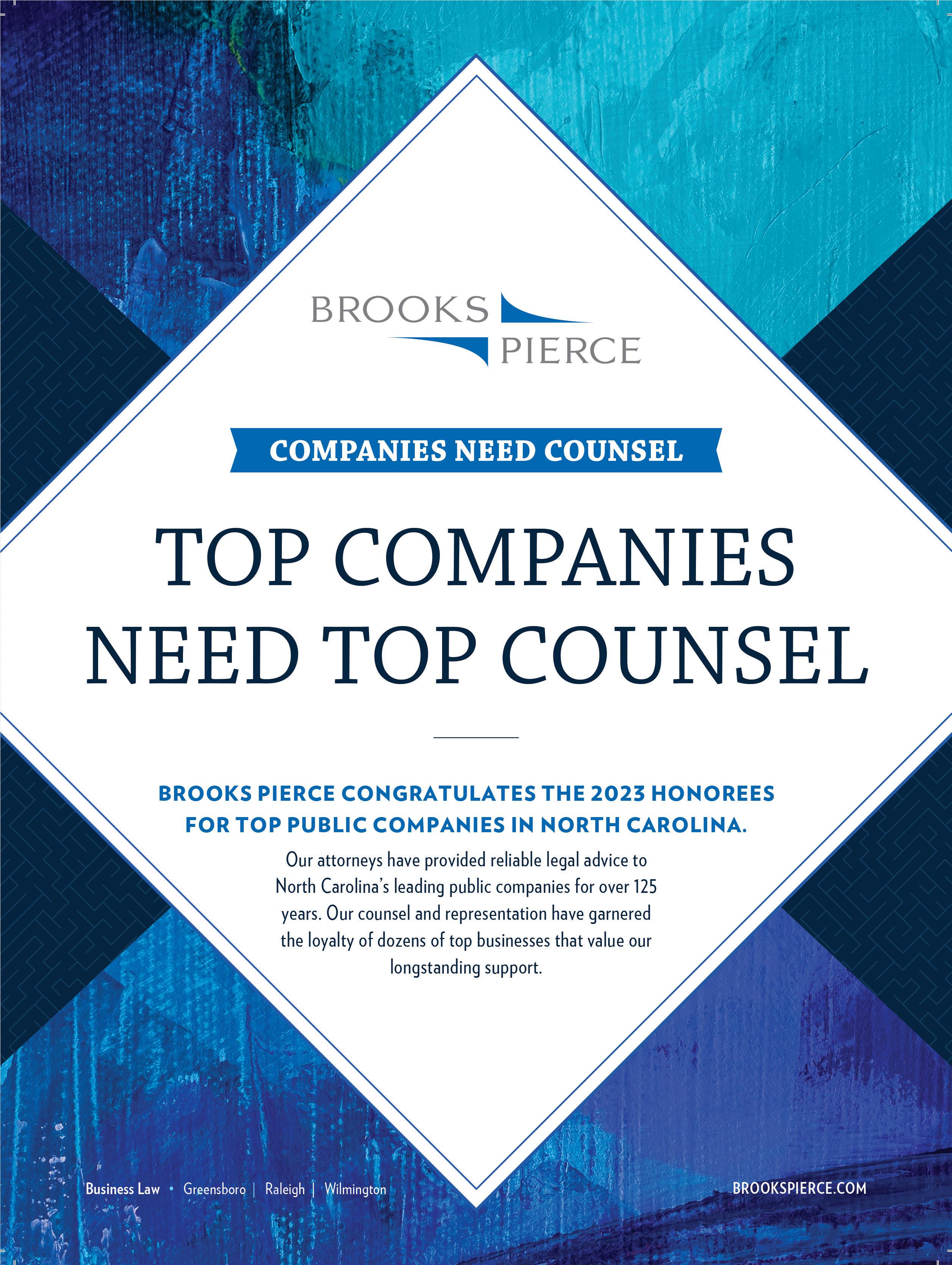

4 UP FRONT

6 POWER LIST INTERVIEW

Jeff Harris shares how Furnitureland South built a High Point dynasty.







8 PILLARS OF N.C.
Chicagoan Sis Kaplan helped shape Charlotte’s radio industry for more than two decades.
10 NC TREND
A quick dive into the N.C. swimming pool business; A Durham biotech veteran tries another Tune; Garth Brooks preps to promote Habitat housing in Charlotte; An OBX leader writes about the coastal region’s shifting tides; TV network INSP flips from the Gospel to Westerns; News from the N.C. Tribune
78 GREEN SHOOTS
As N.C. farmland disappears at an alarming rate, three developers sustain a family cattle business..
32 CORPORATE MEETING GUIDE
Increasing bookings after the pandemic lull are prompting various conference facilities to expand.





38 ROUND TABLE: MANUFACTURING


A panel of industry leaders discuss vital workforce issues confronting the sector that drives the state’s growth.

66 COMMUNITY CLOSE UP: CHATHAM COUNTY
The fast-growing central N.C. county shows the benefits of collaborating across regional boundaries.
COVER STORY
TURN THE RADIO ON
Video and other media couldn’t kill radio star Don Curtis’ dream for a statewide chain.


















 BY EDWARD MARTIN
BY EDWARD MARTIN
MIXED SIGNALS
TOP 75 PUBLIC COMPANIES




The biggest companies based in the state mostly showed a solid rebound from the prior year.

 BY CHRIS ROUSH AND DAVID MILDENBERG
BY CHRIS ROUSH AND DAVID MILDENBERG

MALL CHANGES
Creative approaches are required to sustain oncedynamic regional malls.


 BY CHRIS ROUSH
BY CHRIS ROUSH

A LOVE HOUSE STORY
A storied Irving Park mansion has been home to three leaders with major clout in Greensboro over the past 90 years.
 BY ROSS HOWELL JR.
BY ROSS HOWELL JR.
3 AUGUST 2023 August 2023, Vol. 43, No. 8 (ISSN 0279-4276). Business North Carolina is published monthly by Business North Carolina at 1230 West Morehead Street, Suite 308, Charlotte, NC 28208. Phone: 704-523-6987. All contents copyright © by Old North State Magazines LLC. Subscription rate: 1 year, $30. For change of address, send mailing label and allow six to eight weeks. Periodicals postage paid at Charlotte, NC, and additional offices. POSTMASTER: Send address changes to Business North Carolina, 1230 West Morehead Street, Suite 308, Charlotte, NC 28208 or email circulation@businessnc.com. Start your day with business news from across the state, direct to your inbox. SIGN UP AT BUSINESSNC.COM/DAILY-DIGEST.
COVER PHOTO COURTESY OF CURTIS MEDIA GROUP AUGUST 2023 62 54
48 58
T
To say we’re excited to be working with Chris is like saying LaMelo Ball is pleased with his new $262 million, ve-year Charlotte Hornets contract. A big understatement.
Chris joins us a er more than 20 years as a full-time academic, during which time he gained national respect as a leader in business journalism education. Most of that time was at UNC Chapel Hill, where he helped several hundred Tar Heel students prepare for jobs at both big media companies and small news organizations.
his month's story on how regional malls are adapting to change marks the rst feature produced by our new colleague, Chris Roush. It’s a tting topic for someone who’s tracked change in his own industry, journalism, for a long time.Wall Street and Main Street,” a er previously writing a leading textbook for business journalism. His love for our state is evident in his books on the history of Hickory-based Alex Lee food business; Progress Energy; and a biography of famed Wall Street Journal editor Vermont Royster, who was born in Raleigh.
“Business journalism has always been the one area of journalism that has continued to grow,” he wrote in an introductory blog. “And there are plenty of opportunities to grow business news in North Carolina.” ank you BNC readers and sponsors for helping us make that happen.
e rise of mutual funds, exchangetraded funds and target-date funds have led to declining interest by many investors in individual stocks. Many people paid to manage investments for individuals, families, businesses and nonpro ts are discouraged from promoting speci c shares. at’s a big change from early in my career.
PUBLISHER
Ben Kinney bkinney@businessnc.com
EDITOR
David Mildenberg dmildenberg@businessnc.com

MANAGING EDITOR
Kevin Ellis kellis@businessnc.com
EXECUTIVE EDITOR, DIGITAL
Chris Roush croush@businessnc.com
ASSOCIATE EDITOR
Cathy Martin cmartin@businessnc.com
SENIOR CONTRIBUTING EDITOR Edward Martin emartin@businessnc.com
SPECIAL PROJECTS EDITOR
Katherine Snow Smith
CONTRIBUTING WRITERS
Ray Gronberg, Ross Howell Jr., Vanessa Infanzon, Audrey Knaack, Mike MacMillan, Warren Cole Smith
CREATIVE DIRECTOR
Peggy Knaack pknaack@businessnc.com
GRAPHIC DESIGNER
Cathy Swaney cswaney@businessnc.com
CONTRIBUTING PHOTOGRAPHER
Amy Freeman
MARKETING COORDINATOR



Jennifer Ware jware@businessnc.com
ADVERTISING SALES
More recently, he was dean of the School of Communications at Quinnipiac University, a Connecticut school best known for its political poll and winning the NCAA men’s hockey championship this year. His desire to return to North Carolina for family reasons is our good fortune.
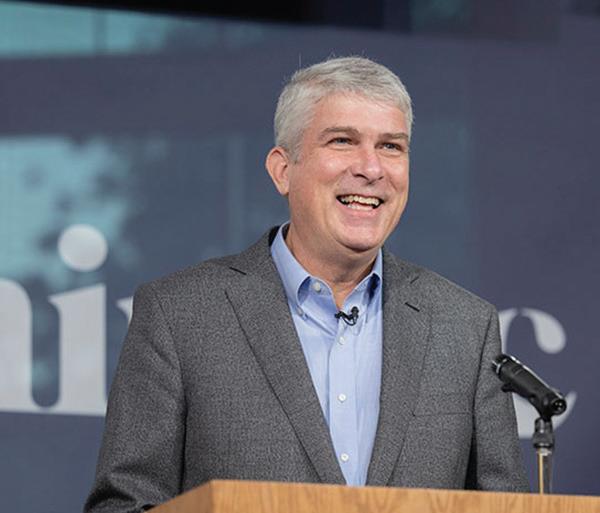

While Chris is already making our 42-yearold print magazine stronger, he’ll spend much of his time helping create more value for readers of our newsletters and website.
“Having Chris on board will allow us to have an industry expert solely focused on making BNC a major player in digital media in the state,” Publisher Ben Kinney says.
Last year, Chris published “ e Future of Business Journalism Why it Matters for





But BNC has always o ered an annual report card on the public companies based in the state. Our report starting on Page 48 shows that, indeed, there are a few N.C. companies that have shown consistent success over the past ve years.
At the Berkshire Hathaway annual meeting this year, Warren Bu ett’s partner Charlie Munger had a comment on this issue:
“I think one of the inane things taught in modern university education is that a vast diversi cation is absolutely mandatory in investing in common stocks. at is an insane idea. It is not that easy to have a vast plethora of good opportunities that are easily identi ed. And if you’ve only got three, I’d rather be in my best ideas instead of my worst.”
Contact David Mildenberg at dmildenberg@businessnc.com.
ACCOUNT DIRECTOR
Melanie Weaver Lynch, eastern N.C. 919-855-9380 mweaver@businessnc.com
ACCOUNT MANAGER AND AUDIENCE DEVELOPMENT SPECIALIST Scott Leonard, western N.C. 704-996-6426 sleonard@businessnc.com
CIRCULATION: 818-286-3106
EDITORIAL: 704-523-6987
REPRINTS: circulation@businessnc.com
BUSINESSNC.COM


OWNERS
Jack Andrews, Frank Daniels III, Lee Dirks, David Woronoff, in memoriam Frank Daniels Jr.
PUBLISHED BY Old North State Magazines LLC
4 BUSINESS NORTH CAROLINA
PRESIDENT David Woronoff VOLUME 43, NO. 8
UP FRONT David Mildenberg
ROUSH HOUR










AUGUST 2023
LIST INTERVIEW
with Nido Qubein at High Point University

SHELTER SAVANT
Jeff Harris is CEO and co-owner of Furnitureland South, the nation’s biggest single-location furniture store. Furnitureland South has about 600 employees, including 160 consultants who advise customers on how to buy furniture that fits their particular needs and homes. He earned a marketing degree and played baseball at High Point University. He and his wife, Stacey, have three children. Harris and his brother, Jason, also own The Design Network streaming service. This story includes excerpts from Harris’ interview and was lightly edited for clarity.

Give us a capsule view of Furnitureland South. It is a 54-year old business. I am second generation. Our daughter is now third generation. We’re the largest furniture store in the world and we are located in the furniture capital of the world. High Point. We have 1.3 million square feet of display space and showrooms at one location. That’s the world’s largest.
Customers come from all over because you offer tremendous choice and better pricing, right?
Absolutely. North Carolina has long been known as a place to get great prices on furniture. There’s so much manufacturing that has taken place in our great state of North Carolina, and over time, retail spawned out of that. Our cost of materials and labor was lower, so we were able to offer tremendous pricing to consumers that would travel here. Probably 65% of our business comes from consumers who reside outside of North Carolina.
How do you strike relationships with furniture makers? How does the system work?
We represent over a thousand brands of furniture, accessories, rugs and lighting that are made all over the world. The High Point Furniture Market is the largest trade show in the industry and it’s held every April and October. It’s buyers and sellers, interior designers. The people that are in the business. It’s not open to the public. When our parents started the business, one of their goals was to bring this incredible market that’s not open to the consumers. That’s one of the reasons that we built the buildings as big as we have so that it allows for this broad array of furniture categories: different brands, products, styles and price points. There’s not a day that goes by that we don’t get solicited for a new brand or product.
Tell us about the decision to expand to your current location?
Back in the late 80s, we built the same time they were building the new Interstate 85 My father was accused of being a bit crazy because
6 BUSINESS NORTH CAROLINA
Jeff Harris joined High Point University President Nido Qubein in the Power List interview, a partnership for discussions with some of the state’s most influential leaders. Interview videos are available at www.businessnc.com.
they thought the traffic would dry up. Now, it’s the only stoplight between Atlanta and Washington, DC, right where our store is. I was in high school when this happened. This was a decision that my father made at the time, and he really took a little bit of a risk because at the time we were on Main Street in High Point with about 8 or 10 of our competition.
But my father saw these manufacturers were putting restrictions where you could not have access to their brand unless they had dedicated space to display a certain amount of their product. Our location was nowhere near big enough. Now, we have close to 100 acres and we’ve built not only our showrooms there, but we’ve built our distribution center. our warehouse.
You have a Starbucks and a Subway. What about a hotel?
We thought about that. We are actually neighbors with Grandover Resort, which is a wonderful thing for our people.
Why has Furnitureland South remained successful when so many competitors have disappeared?
We are very blessed. We stay very close to our clients, and we want to know how they want to shop for furniture. Filling your home with furniture is not an easy process. So we continue to invest with our consumers to ask them how they want to shop for furniture? We invest in our people. We care about them. We want them included in the decisions.
Have you quantified your economic impact on the Piedmont Triad?
We have not, but it has to be in the hundreds of millions of dollars a year just based on the business that we do, and the amount of people that come to the area.
How are you different from Wayfair or Amazon? You don’t do e-commerce, correct?
No, we don’t. My first response is, we have the good stuff at Furnitureland South. We have the very best that this industry has to offer.
We carry the very best brands in the industry — that a lot of these brands don’t even do consumer advertising or marketing directly to consumers. There’s an education that has to take place for people to really understand what quality furniture really is.
We have tried to sell high-end goods online and, to my knowledge, there’s not many furniture retailers that have been successful in doing that. So, we really try to use our website for information, for inspiration, and connect-ability. We want to connect them with a professional. You need someone that can listen to the style you want, the function that you want for your room.
How do you connect customers to your 160 designers?
We create video bios for our design consultants, so you choose who you want to help you with this process. We have a 90-second video bio that tells about their personal style. We really encourage you to select that person before you just show up in North Carolina.
I hear that young couples don’t want furniture that lasts 25 years. They’re interested in speed, price, convenience, and quick delivery. Is that right?
There are cycles of the consumer shopping experience. You see a lot of marketing with people like “Rooms to Go” and “Ashley.” I think once they go through that process, they see, hey it may not
last 25 years, but some of this doesn’t last a year. So then they’re out there again. You know, they’re not inexpensive. Although they’re not the greatest quality, they’re not inexpensive. And so we have a lot of people that find us, and they’re wanting better quality goods. But we talk about this a lot, and we continue to have an entryway for people to shop with our brands.
What is the profile of your customers? Surely you don’t promote to 350 million Americans.
We’d love to be able to have a budget to do that. I like to tell people we’re the best kept secret in the industry. People don’t really know that we exist because, even though we are the largest furniture store right here in the furniture capital, people want something that’s convenient. So we do try to reach people within a 200-mile radius of the store. They can drive up for a weekend.
Our sweet spot is the East Coast. Now, we do business west of the Mississippi, but the bulk of our business is done here on the East Coast.
Why didn’t you expand with a Furnitureland West?
We’ve had these discussions for decades. We had a prototype Furnitureland design center that we were going to locate in Charlotte that would be our first parlay into a new market. But then the pandemic hit, so we pulled back. Business exploded over the two years during the pandemic. Who could have seen that coming? So we put those plans kind of on the shelf for now.
One thing that we know happens when you expand is you spend a lot of money. You’re taking big risks.
Tell us about The Design Network.
My brother Jason and I own the network. It’s almost 10 years old. You can find it on Roku on Apple TV, and Samsung, Vizio. We’re streaming millions of hours per month all over the world right now, and it’s pretty incredible what we’ve been able to accomplish. Now, Jason runs that business. It’s a completely separate business that sells advertising. We don’t sell furniture through the network. We’ve built an incredible network of home enthusiasts and designers.
What is most challenging in the furniture business now?
The biggest challenge is what is this new normal that everybody talks about? We’ve had to go out and lease additional warehouses just to handle the volume that we grew over 2021 and 2022. Being able to right-size your business to handle that growth continues to be a challenge . We’re really blessed in the fact that people are really moving to the Southeast and when they do, they’re able to buy more home for less money, and they’re wanting to start over with the furniture. Do other retail stores like you, or hate you?
Hate’s a very strong word. We have earned a lot of respect in our industry, and I’m able to participate with a lot of other leaders in this industry. There’s mutual respect. At the end of the day, we have to do a better job of educating the consumers on the value that the whole industry can bring them.
What’s ahead for the furniture sector?
I think the industry’s going to be pretty good for the next couple of years. I don’t have a crystal ball. But we can control the level of service and the connection that we make with our consumers. We have products that everybody needs. When times get tough, we work harder. ■
7 AUGUST 2023
SIS KAPLAN
The Chicagoan helped shape Charlotte’s radio industry for more than two decades.
 By Vanessa Infanzon
By Vanessa Infanzon
When Harriet “Sis” Kaplan and her late husband, Stanley Kaplan, bought a Charlotte AM radio station in 1965 for $550,000, they knew the market was ripe for change. More than 50 years later, fans of Big WAYS 610 still reminisce about the radio station’s iconic promotions and memorable songs and skits they heard during in the ‘60s and ‘70s.
Sis grew up in Chicago, where her father, Leslie Atlass, had started the Windy City’s leading news radio station, WBBM, in the 1920s. After graduating from Rollins College in Winter Park, Florida, in 1955, she worked in public affairs programming for CBS in Chicago, then produced a baseball-oriented television talk show.

Sis met Stan at a broadcast convention in Chicago in the early 1960s. They married in 1964 and lived in Boston for a year before moving to Charlotte.
During a visit to see if Charlotte was a viable market, Kaplan noticed that the city’s leading AM station, WBT, was airing a religious program rather than reporting election results. This gave her the idea to add a news operation at WAYS. But the Kaplans’ decision to shift the station’s format to Top 40 music was key to its success as rock ‘n’ roll music gained popularity.
Charlotte broadcast executive Jim Babb, who was general sales manager at WBT at the time, studied the Kaplans before they arrived. “We knew three months in advance, they were coming,” Babb says. “I came to the conclusion that it was going to be a different market with Stan, who had a very robust personality. And Sis’ family had been well-known in broadcasting. I knew they’d come well-prepared for a competitive situation.”
A famous Big WAYS promotion was a treasure hunt that offered $10,000 in $1,000 increments, buried around the region. Babb tried to convince WBT to counter the contest with something similar. But the station’s conservative management wouldn’t budge. “It’s still one of the greatest ideas I’ve heard in 60plus years and one of the most successful,” Babb says. “It bothered me that it worked.”
The Kaplans recruited radio personalities from around the nation, including the late Jay Thomas, who became a famous TV sitcom and movie actor. Big WAYS alums Robert Murphy and Scott Slade became radio stars in Chicago and Atlanta, respectively.
“The radio talent was a different style,” Babb says. “They took it more to the edge than what had ever been presented in the Charlotte market. It appealed more to the young people, but that was what many advertisers were seeking.”


Charlotte TV weatherman Larry Sprinkle worked for the Kaplans for 13 years as an announcer and operations manager.
“Sis was enthusiastic about what the station could do and how it could stay on top,” he says. “In the early ‘70s, a female in management was rare. She inspired other females to get others to get into the business.”
In 1970, the Kaplans bought an AM station in Jacksonville,



8 BUSINESS NORTH CAROLINA
PHOTOS COURTESY OF SIS KAPLAN
Florida, then added a Charlotte FM station two years later. The latter, WROQ, cost about $300,000. As music listeners shifted to FM stations, ratings declined at Big WAYS, prompting the Kaplans to change to a news-and-talk format in 1982.
With sales and news staff in place for radio, the couple started a group of weekly newspapers around Mecklenburg County, challenging the Charlotte Observer. It morphed into The Leader newspaper, which Charlotte’s Shaw family bought in the late ‘80s and resold to the Kaplans several years later. The paper was disbanded in a bankruptcy filing in 2002.
In 1989, the Kaplans sold WAYS and WROQ to CRB Broadcasting for $13 million. Stan, who died in 2001, and Sis were inducted into the inaugural class of the Charlotte Broadcast Hall of Fame in 2015. Earlier this year, the Council for Children’s Rights honored Sis as the first recipient of its HOPE award, recognizing her 15-plus years of volunteer service to the nonprofit.

Sis lives in Charlotte’s Dilworth neighborhood and serves on a committee that works with development and rezoning projects. Her daughter and son-in-law, Leslie and Bruce Schlernitzauer, own Porcupine Provisions Catering in Charlotte.

Comments are edited for length and clarity.
I came down and I did the due diligence of Charlotte. It looked like a growth market. The radio signal carried into the area of the growth, which was southeast. The station appeared to be something we could afford.
It was quite a culture shock to move here, much more for me. There weren’t a lot of working women in positions of decisionmaking. I’d be on a call, and they’d say, “Who do you have to talk to make a decision?”
We took over the market. We ran 10 treasure hunts [offering $1,000 to the winners.] The FCC said no more treasure hunts because people started digging up property where the treasure didn’t exist.
Larry Sprinkle was part of the morning show. He did lots of voices. He played jokes on people. He sent Stan out on a sales call that didn’t exist. He did things to any new disc jockey. The truth is many of the antics that went on then couldn’t go on today, from a standpoint of offending a lot of people. (Sprinkle has worked for Charlotte’s WCNC TV station for 38 years.)
The station had a national reputation because it was wellprogrammed and had a big audience and a lot of sponsorship. We became the No. 1 station in Charlotte.
I handled programming and Stan handled sales. We worked together, not always well. We had arguments. Our deal was that if it were a major decision and if we couldn’t agree, we just wouldn’t do it, regardless of how pissed off the one person would be.
Things are much better for women, but still have a long way to go to become equal. Things are better for white women than for people of color. There are still blocks there that exist and will have to come down at some point.
Ford just announced they won’t be putting AM radio in the cars. I think it’s another nail in the coffin. There are AM stations still doing well, but not a huge number of them. I don’t think radio has a bright future. (In May, Ford said it will install AM radio in 2024 models after complaints from customers and regulators.) ■
9 AUGUST 2023
During four decades as Charlotte business owners, Stan and Sis Kaplan were among the city’s most prominent media executives. Sis, shown with her daughter Leslie Schlernitzauer’s family, was active in many civic organizations. Stan never lacked opinions or ideas for unusual promotions.
SWIMMING UPSTREAM

Swimming pools are a growth industry for obvious reasons: It’s getting hotter everywhere, there are fewer municipal and neighborhood pools, and the “cocooning effect” prompts many homeowners to invest more on their cribs.
Here’s a primer about the business of pools, of which North Carolina plays a key role.




1
5.4 million Installed in-ground residential pools in the U.S.








300,000 In-ground pools built in the U.S. from 2019-22
$6.4 billion Global market for pool equipment.







309,000 Public swimming pools in the U.S.
10% Average price increase of swimming pool supplies from 2022 vs. 2021
8%
Compound annual growth rate of U.S. in-ground residential pool construction, 2012-21
-25%
Expected industry decline in new and remodeled pool revenue in 2023
2.5 times
Increase in spending on equipment per new pool over the past decade
80%
Percentage of consumer spending for maintenance of existing pools
source: Hayward Holdings, Pool Corp., Pentair, Allied Market Research
10 BUSINESS NORTH CAROLINA NC TREND ››› Home Improvement
POOL FACTS
2

HAYWARD MOVES SOUTH
Charlotte became a center of the U.S. pool industry when Hayward Holdings moved its headquarters from New Jersey to the Queen City in 2021. e company had annual revenue averaging $1.35 billion over the past two years, doubling from 2019 as demand for pools shot up during the pandemic. at’s second to Pentair among U.S. pool equipment manufacturers.
About 800 of Hayward’s 2,000 employees work in Clemmons, where it makes pumps, lters and cleaners. It has other factories in Rhode Island, Tennessee, Spain and China.
Hayward’s move coincided with its initial public o ering, which raised $685 million, in March 2021. Shares came out at $17 and traded higher initially, but have slumped in the past 18 months as pool demand has declined. Hayward traded for about $12.50 in mid-July.

e company’s principal owners are the BDT/MSD investment rm, which owns 34% of shares, and CCMP Capital Investors, with 14%, according to company lings. (Computer tycoon Michael Dell owns MSD.) Both companies are based in New York.
Hayward bene ts even when new construction slows because pools require consistent maintenance. “ One of the unique things about pools is that the a ermarket is really important” says Hayward CEO Kevin Holleran, who joined the company in mid-2019 a er working for Textron. “Once you build a pool, if something breaks, you are not going to drain it or let the water turn green.”



3 WHY POOLS ARE HOT 4



Hayward CEO Kevin Holleran cites these factors:
• More remote/hybrid work
• Migration to the southern U.S.
• Health, exercise and well-being bene ts









• Enhanced property values
• Excellent space for entertaining


PENTAIR CONNECTION
Pentair is the largest manufacturer of pool equipment in the United States with annual revenue of $1.6 billion, and its pool division headquarters is in Cary. It’s led by Executive Vice President Jerome Pedretti, who joined the London-based company in 2005. Pentair had total revenue of $4 billion last year, including sales of water-treatment equipment and industrial products.
HAYWARD’S NUMBERS REVENUE
2022 $1.31 billion
2021 $1.4 billion
2020 $875.4 million
2019 $733.4 million
NET INCOME




2022 $179.3 million
2021 $203.7 billion
2020 $43.3 million
2019 $8.5 million
ROBOTS & PUMPS
Robotic cleaners are popular with many pool owners. Some can be directed via smartphones. Federal rules that took e ect in July 2021 require new pumps for pools to meet energy-e ciency and other compliance standards.












11 AUGUST 2023
5
FRESH TUNE
There’s a lot of promise in gene-based disease treatment therapies, and a lot of hype. Language around the industry is rife with superlatives — “transformative,” “pioneering,” “paradigm changing,” and so on.

ere’s no one way to know what’s real because many therapies show promise in early trials, then fail to pan out. But following the money is probably as good a way as any. To that end, Tune erapeutics is heading in the right direction.
Based in Durham and Seattle, Tune was launched in December 2021 to develop so-called “epigenomic tools” to address a broad range of diseases. Earlier this year, it raised $120 million in its second funding round, up from $40 million in its Series A, according to Pitchbook, which tracks venture investing.
e lead investor is NEA, a major venture capital rm with o ces in Menlo Park, California, New York City, and other places. It was joined by the Emerson Collective, established by Lauren Powell Jobs, the widow of the late Apple founder Steve Jobs, and Durham-based Hatteras Venture Partners. Pappas Capital, also from Durham, is an investor too, its rst foray into epigenomics. Several companies in the industry have attracted major dollars over the past two years. Chroma, based in Cambridge, Massachusetts, launched in November 2021, has raised $260 million, according to the Crunchbase website.
GRIZZLED CEO
e epigenome refers to chemical compounds in the body that modify genes — telling them what to do and when and where to do it. e term is derived from the Greek word “epi,” meaning “above.” e epigenome sits above the genome and “tunes” how genes are expressed. Unlike gene editing, epigenomics holds the promise of modifying gene behavior without inadvertently damaging DNA sequences, and it can be turned on and o . In
By Mike MacMillan Matt Kane
something of a reprise of the Lamarck vs. Darwin schism over evolution, epigenomic marks can be passed from cell to cell and from one generation to the next, while changes rendered through gene editing generally cannot.
ere is considerable excitement around this new technology, based on the potential to “reverse pathways of cancer, genetic disease, and aging by changing cell fate and function,” as Tune puts it.


CEO Matt Kane, who joined the company at launch, is a familiar face in Durham biotechnology circles and experienced with start-ups. He co-founded Precision BioSciences and served as CEO. e gene-editing start-up went public in March 2019 at $16 per share, raising $145 million. It’s since been a rocky road, re ecting the risk in early stage biotech companies. e company reported $340 million in net losses between 2019 and 2022. e stock traded for about 60 cents in late June.

Kane, who owned a 4% stake according to company lings, departed in October 2021.
Tune calls its proprietary platform Tempo, a set of technologies that can be used to modulate speci c genes or groups of genes. is provides the ability to “screen for activators or repressors of gene expression in a wide variety of cell types and disease states, revealing new disease associations and targets in a matter of days or weeks. is shortens timelines of discovery and selection and increases the capacity for rapid clinical development of candidates,” according to the company.

12 BUSINESS NORTH CAROLINA NC TREND ›››
Research
A Durham biotech veteran gets another chance, with $120 million from some notable backers.
Tune stems from decades of research conducted by Charles Gersbach, a biomedical engineering professor at Duke University and a serial entrepreneur. Co-founder Fyodor Urnov is a professor at the University of California at Berkeley and a director at the Innovative Genomics Institute.
Epigenetics is a potential growth industry for the state. Tune employs about 85 people, including 40 at the Durham headquarters. This (Tune) is “very important for our research base here in North Carolina and in Durham, providing the opportunity to look at this cutting edge epigenetic approach to clinical medicine,” says Art Pappas of Pappas Capital.
North Carolina is receiving $51 million in federal grants to conduct epigenetics research for the fiscal year ending in September, on top of $59 million in the previous year, according to the North Carolina Biotechnology Center. The main recipients are research universities, including UNC Chapel Hill and Wake Forest.
“There is great potential for growth in epigenetics,” says Jen Greenstein, director of emerging company investments at the biotech center. “With a lot of amazing research happening at N.C. universities and at early stage companies, we expect to see more technology commercialization in the years to come.”

HOLY GRAIL?
Many of these technologies have yet to be shown to be effective in humans, though progress is being made. While Tune declines
to discuss its pipeline, CEO Kane says that the company has launched multiple discovery programs to explore “how to best apply our epigenetic tools to a variety of applications.” Most recently, it presented data it said demonstrated the “stable repression” of the gene responsible for controlling LDL cholesterols levels in non-human primates, such as macaque monkeys. LDL is associated with the formation of arteryclogging plaques in humans. The company characterized this advance as “incredibly promising.”
Still, the path of biomedical research rarely runs smoothly. While hundreds of millions of dollars has been spent on research, the field “hasn’t fully lived up to its potential,” with few drugs on the market, according to a 2021 story in the industry trade newsletter Biopharma Dive
Enough time and money may solve these challenges, however. Fans of epigenomic-based medicine tend to sound as if they have discovered the Holy Grail of bioengineering. “Genetic medicine is at a tipping point,” according to Kane in a press release about the company’s formation. Tune is “primed to become a transformative presence in modern biomedicine,” noted partner Ali Behbahani, co-head of NEA’s healthcare practice.
Progress in the biotech sphere trends to be incremental, unfolding over time. There is considerable optimism about the technology and, just as important, there is money available to invest. Both are good signs for companies such as Tune. ■
13 AUGUST 2023
FRIENDS IN AFFORDABLE PLACES
By Kevin Ellis

Habitat for Humanity has roots in Georgia, the home of founders Millard and Linda Fuller and Jimmy Carter, who brought international attention to the a ordable-housing nonpro t. But Charlotte has played a pivotal role in its history, a tradition that will continue in October when hundreds of volunteers are expected to build 23 homes on the city’s west side.
Country music superstars Garth Brooks and wife Trisha Yearwood are slated to attend the build, bringing star power to the annual Jimmy and Rosalynn Carter Work Project. e Carters began volunteering with Habitat in 1984, and in 1987 the former president and his wife joined crews that built 14 homes in Charlotte’s Optimist Park neighborhood.

A home being built in October will turn Brianna Sanford’s dream of homeownership into a reality. e 31-year-old substitute teacher and mother of two will trade her $1,873 apartment rent for a $600 mortgage on a three-bedroom home. She’ll go from spending more than 50% of her monthly income on rent to 30% for a home, including insurance and property taxes.

“It’s going to allow me to just breathe, and allow me to just let my hair down. Now it’s just living from check to check to check,” Sanford says.
e sharp uptick in housing costs in Charlotte – the median home price was $385,000 in May — makes the Habitat work more relevant than ever. “ ere’s a growing need for Habitat as prices and costs increase and incomes are stagnant in comparison,” says Laura Belcher, who has been CEO of Habitat’s Charlotte region for nine years.
It’s the rst Carter Work Project since the pandemic suspended the event three years ago. Overall, Habitat is building 39 homes on the site of the former Plato Price School, which educated Black children during segregation from 1915 until 1966.
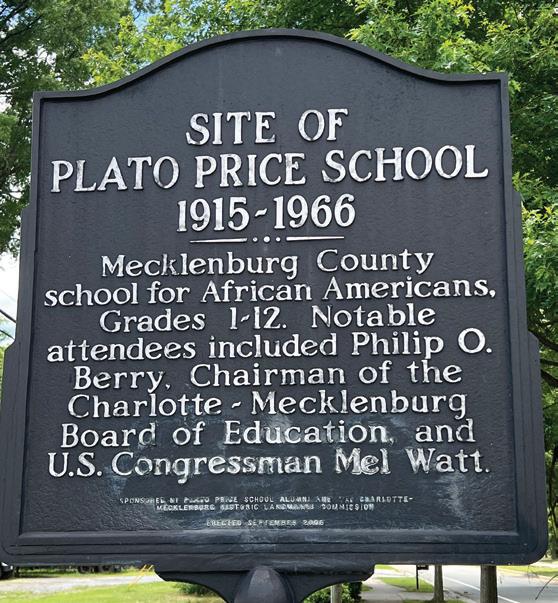

“I believe we’re on historic, hallowed ground,” Belcher says. “ is property has sat vacant for decades waiting for its higher purpose. Bringing home ownership to 39 local families and creating a neighborhood is its higher purpose.”
e neighborhood is a historically Black community near Charlotte Douglas International Airport. It’s in a part of the city with a homeownership rate of 26%, compared with Mecklenburg County’s average of 57%. e city of Charlotte donated the land to Habitat in 2018 and has since spent more than $1 million in infrastructure improvements there. Other $1 million-plus “cornerstone” contributors to the project include Ally Charitable Foundation, Merancas Foundation and Myers Park United Methodist Church. Lowe’s, Bank of America and Wells Fargo also have contributed at least $1 million each. Donations help Habitat get the project started as well as make the homes a ordable.
Construction on the site’s rst seven homes began in January, with families likely to move into those homes in August.
e pace of construction will ramp up in October when 700 volunteers are expected to swing hammers, level oors and hang walls. Having a focused e ort should enable 23 families to get


14 BUSINESS NORTH CAROLINA NC TREND ›››
Housing
Garth Brooks is set to make Habitat for Humanity shine in Charlotte this fall.
into homes a year faster than Habitat’s regular pace in Charlotte, Belcher says.
During the project, Habitat expects to complete construction on eight homes and frame 15 others. The homes will be a mix of 1,100 to 1,200 square feet, with three to five bedrooms. Some will have a second story.
CARTER’S LEGACY
The 39th U.S. president’s affiliation with Habitat began at a New York City project in 1984, three years after his presidency ended. Three years later, the couple came to Charlotte for the weeklong effort.
Carter, the oldest living U.S. president in history at 98, entered hospice care in February. Habitat plans to honor the Carters’ legacy during the project which also falls on Charlotte Habitat’s 40th anniversary. “All of these things have come together at the same time and it’s an amazing blessing,” says Belcher.
Charlotte’s mark on Habitat has included developer Paul
Leonard, who served as the group’s interim CEO in 2004-05, and author Frye Galliard, who wrote a book on its history, “If I Were a Carpenter.”
More than 1,900 homes have been built in Charlotte since 1987, along with 8,000 across North Carolina. Only Florida recorded more Habitat builds last year than the Tar Heel State.
Yearwood and Brooks, who is the top-selling country artist of all time, have been lending their star power to Habitat for about a dozen years. “When they come and do this for a week, it helps to plant seeds with other people,” says Belcher. “This is how you put your beliefs into action. If you believe there is a housing challenge, this is how you can put your time and energy into good work.”
Sanford can’t wait to get into her home, which she’ll share with a daughter and son who are rising second- and third-graders, respectively. With finances not so tight, she wants to enroll them in dance and gymnastics lessons. The stability of staying in a home should help them at school, she says.
“I want them to have their best life.” ■
BY THE NUMBERS
62 Habitat affiliates in North Carolina, second only to Texas (63).
229 Habitat new home builds in North Carolina last year, second to Florida (457).


77 N.C. counties with Habitat homes.
6 N.C. locations with active Habitat projects.
HOW HABITAT OPERATES
Habitat “right sizes” 30-year mortgages so low-income people can afford to buy a home, creating family stability while giving rise to generational wealth. The homes being built in October during the Carter Work Project in Charlotte should appraise for nearly $300,000, says Habitat for Humanity Charlotte Region CEO Laura Belcher. That’s more than many first-time home buyers and low-income families can afford.
Habitat sells the homes at appraised value, but arranges mortgage payments, taxes and insurance that remain at 30% of owners’ monthly income level. Most new homeowners get down-payment assistance from the city of Charlotte. Habitat also attaches a second, non-forgivable mortgage on its homes. Habitat homeowners build equity and can pass the home to an heir without paying off the second mortgage, she says. The second mortgage is paid back to Habitat upon the sale of the home, and Habitat and the homeowner then divide the equity in the home.
15 AUGUST 2023
BARRIER TALES
By Audrey Knaack
Change is not new to the Outer Banks. Yet, throughout Clark Twiddy’s career, the real-estate executive grew tired of learning about the region’s history from obituaries. So he decided to describe the changes occurring at North Carolina’s barrier islands through locals’ experiences.
“I would just call people up and say, ‘Hey, will you tell me a story or two?’ Or, ‘Hey, what’d you see here? And ‘hey, can you remember this?’ And so I would just talk with them.”
Twiddy’s hospitality-based career has provided an interesting perspective to look at how the Outer Banks’ region has developed through key personalities. e result is his new book, “Outer Banks Visionaries: Building North Carolina’s Oceanfront.” It’s his second release about the area’s history.

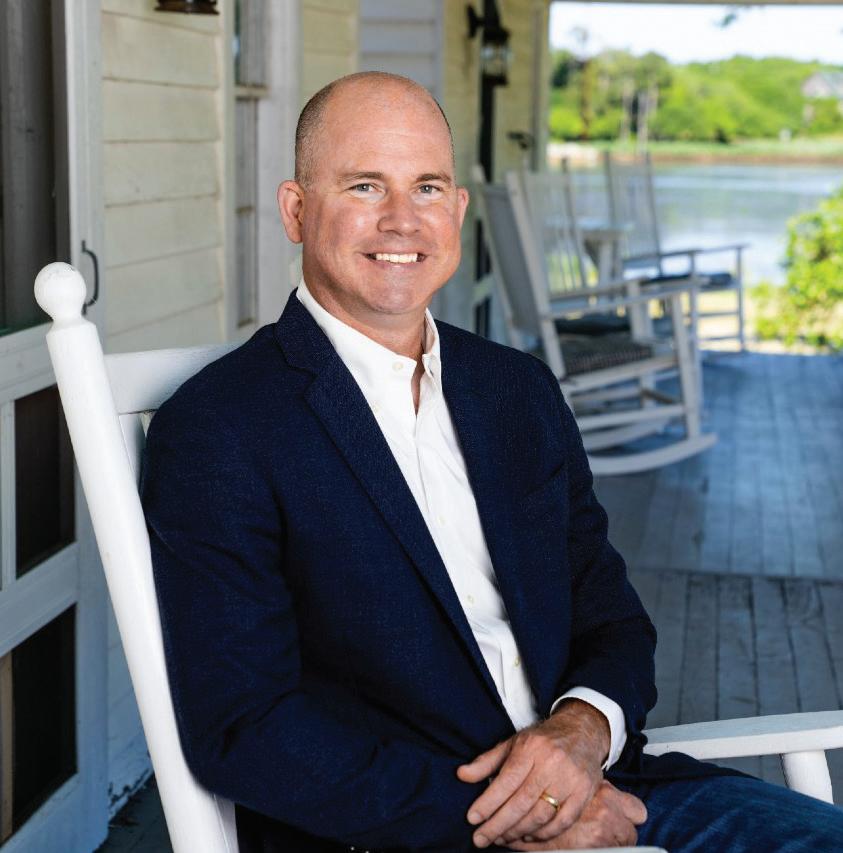
Over the past 30 years, the quaint shing villages have become neighbors to a booming visitor economy. Resistance to the change is futile, he notes.
“Change is a constant. It’s a question of how we shape change and our ability to shape it rather than to resist it. If we describe ourselves as resistant to change, then we are doomed to fail.”
e graduate of Virginia Military Institute,


University of Tennessee, and Northwestern University’s business school was raised in Duck, a small Dare County town. He oversees his family’s Twiddy & Company, which was formed in 1978 and comprises more than 1,000 rental homes from Nags Head north to the Virginia state line.
e Outer Banks’ status as a visitor economy accelerated during the ‘80s, Twiddy says, crediting how people gained purchasing power during the Reagan administration. Higher disposable income contributed to more demand for vacation homes and rentals. Today, North Carolina is the sixth-most visited state in America.
Dare County, home to Duck, Nags Head, Kitty Hawk and Kill Devil Hills, has a median home value of about $548,000, the highest in the state. “It’s indeed remarkable to consider that the Outer Banks has emerged as a capital of what is now a major asset class in America,” namely luxury residential real estate.


In the book, Twiddy covers the journeys of various Outer Banks visionaries who took part in its transition from isolation to a thriving visitor economy. He cites the late state Sen. Marc Basnight, to whom the book is dedicated, for helping attract state funds for infrastructure and a community college. As an elected o cial for 26 years, Basnight also worked to alleviate environmental concerns through the N.C. Land and Water Fund and other groups.
Others spotlighted by Twiddy include developers Richard ‘Dick’ Brindley and Bob Oakes, who cultivated resort and vacation rental
16 BUSINESS NORTH CAROLINA NC TREND ›››
Real Estate
Clark Twiddy
PHOTOS COURTESY OF TWIDDY & COMPANY
An OBX leader analyzes the coastal region’s shifting tides.
communities such as Corolla Light and the Village at Nags Head, respectively.
The shift from full-time to seasonal residents has provided a platform for service-based businesses to flourish. Twiddy emphasizes the importance of people who create services, trades, and experiences to keep visitors returning to the region.

“Our economy is 90% experiences. Our people are our most precious resource,” including manual laborers who play pivotal maintenance and construction roles.
Many of the region’s early structures are gone, which has led to increased respect for the importance of conservation.
“As you see growth explode on one end of the spectrum, there is a corresponding impulse for conservation.”
This concern helped inspire the creation of the Outer Banks Community Foundation in 1982. This nonprofit organization meets local needs, including protecting historical and environmental landmarks to safeguard the island’s opportunities and natural resources.

Through his retelling of the history of the Outer Banks, Twiddy says he wishes to help the region shape a better, more sustainable future. His passion project, he hopes, will educate others and that, “If nothing else, no one has to wonder how we got here.” ■

17 AUGUST 2023
PHOTOS COURTESY OF OUTER BANKS HISTORY CENTER
Pre-development photos of the Outer Banks from the early 1980s.
INSPIRING COWBOYS
 By Warren Cole Smith
By Warren Cole Smith
One of the biggest ratings successes of the past decade in the U.S. television industry is INSP, which is based in suburban Charlotte, in Indian Land, South Carolina. at success has led to robust paydays for CEO David Cerullo and other executives of the not-for-pro t organization, formerly called e Inspirational Network. It has a mission of “impacting people for Christ worldwide through media,” according to its federal tax ling.
In 2022, INSP o en appeared among the top-rated networks on television, including two weeks in the No. 6 spot in February. For 115 consecutive weeks, its ratings have been in the top 10 of U.S. cable networks, INSP o cials say.
INSP’s popularity followed a rebranding, kicked o in 2010, that emphasizes Western-themed, family-friendly programs, rather than religious-oriented fare. Over the past decade, household viewership has soared more than 1,300% with the network available to more than 60 million households, the company says.
Religious programming on INSP is now largely limited to 4 a.m. to 7 a.m., when the long-running “Camp Meeting” teaching and fundraising telethon airs.
Otherwise, INSP mostly airs shows from the 1960s and ’70s, such as “ e Ri eman” and “Gunsmoke.” Last year, INSP changed its logo to include a cowboy hat and its tagline is now “Heroes Live Here.”
Amid INSP’s success, Cerullo established for-pro t operations, including Imagicomm Communications, which bought 18 television stations in 12 markets from Atlanta-based Cox Media Group last August. Media reports placed the value of the deal at $488 million, which INSP o cials declined to con rm.
e Imagicomm stations range from Binghamton, New York to Eureka, California. e biggest markets include Memphis,
Tennessee and Tulsa, Oklahoma.
“It’s a blockbuster of a deal,” according to Radio+Television Business Report, an online publication. Imagicomm’s purchase of the Cox stations “is among the largest divestments seen in recent memory.”
When announcing the deal, Cerullo said it was part of a “broad corporate strategy to expand our media ownership across multiple entertainment platforms.” He called the stations “important local-journalism brands.”
INSP’s roots stem from the PTL Television Network, founded in Charlotte by Jim and Tammy Faye Bakker in 1978. David Cerullo’s father, Pentecostal evangelist Morris Cerullo, bought the assets of the network in a bankruptcy court-approved sale in 1990. For two decades, it carried primarily religious programming and relied on viewers’ charitable contributions for funding.
e INSP organization has a complex structure. In a prepared statement, spokesperson Ronn Torossian describes INSP LLC as a “a for-pro t, Single Member, Limited Liability Company ultimately owned by e Inspirational Network, Inc., a North Carolina NonPro t Corporation and 501(c)(3) Religious Organization.”
e network took in $29.3 million in charitable contributions in 2021, while total revenue topped $43 million, including investment income, its tax ling shows. Torossian declines to disclose the organization’s total revenue. Taxable income of its for-pro t subsidiaries isn’t subject to public disclosure rules, he says.
e not-for-pro t network had net assets of $266 million, including $187 million held in cash or other investments, at the end of 2021, according to its most recent ling. ere was no debt listed.
“I don’t have an issue with a Christian channel or network featuring a mix of secular and religious programming,” says Phil Cooke, a Burbank, California, consultant who studies
18 BUSINESS NORTH CAROLINA NC TREND ›››
Entertainment
Charlotte-area TV network INSP flips from the Gospel to Westerns.
Christian media. “It might be a good strategy to help engage more nonbelievers, who then would encounter a gospel message.”
But there are “ethical questions when a ministry or nonprofit is built on millions (or hundreds of millions) of donor dollars and then is suddenly converted to what is essentially a secular programmer with leadership making enormous salaries,” Cooke says.
David Cerullo’s total compensation over the past decade exceeds $36 million, according to INSP’s filings. His wife, Barbara, has received more than $3.5 million in the same period. Of the 20 highest paid U.S. ministry executives in recent years, eight are
INSP executives, according to a report by Charlotte-based Ministry Watch, which tracks the business of Christian organizations. (The author of this story is president of MinistryWatch.)
Cerullo had $4.5 million of compensation in both 2020 and 2021, and $7.3 million in 2019. Four other INSP executives earn more than the $741,000 compensation in 2021 of Franklin Graham. He is the CEO of Boone-based Samaritan’s Purse, a nonprofit humanitarian-relief organization with 2020 annual revenue of $898 million.
Attorney and non-profit expert David Bea says INSP can maintain its tax-exempt status if it provides a “public benefit,” such as “the provision of family-friendly entertainment.”


Torossian notes Cerullo “manages one of the most complex, multi-faceted organizations in the country.” His compensation is vetted by an independent committee of the company’s board of directors, who compare pay scales of similar organizations. Cerullo doesn’t get stock options that are common for other cable TV industry executives, nor does he receive royalties on the sale of his books, DVDs or CDs, he says.
The Inspiration Networks’ for-profit subsidiaries include MediaComm, which provides tele-production and distribution services to ‘INSP, LLC,’ and various unrelated companies, Torossian says. ■
19 AUGUST 2023
TRIBUNE NORTH CAROLINA INDEPENDENT INTELLIGENT INFORMATIVE



Our paid daily newsletter provides detailed interviews with key lawmakers, Q&As with other political leaders and lots of stories tracking daily happenings at the state legislature as the 2023 long session continues. Here’s some of what you missed. Sign up today at nctribune.com.
UNC CHAPEL HILL, DUKE OFFER TUITION DEALS

Duke University and UNC Chapel Hill rolled out plans to make their institutions more a ordable.
Duke will provide “full tuition grants” starting this fall for undergraduates from North or South Carolina who come from families with incomes of $150,000 or less.
UNC Chapel Hill Chancellor Kevin Guskiewicz said the university will “provide free tuition and required fees” to incoming in-state undergraduates whose families earn less than $80,000 a year.
e plans di er greatly. For those from families with incomes of $65,000 or less, Duke will supplement the free tuition with “ nancial assistance for housing, meals and some course materials or other campus expenses, without the need for student loans.”
e Duke program is retroactive to cover existing students who meet the quali cations. at is not the case with the UNC Chapel Hill program, which will start in 2024.
Duke's income thresholds are more generous, given the vast di erences in estimated cost of attendance between Duke ($83,260) and UNC Chapel Hill ($26,100).
One can’t gig UNC for only covering North Carolinians, as it’s a state-supported school. e private school also has more money in reserves to spend than its neighbor. Duke has a $12 billion endowment. UNC’s is $3.1 billion.
TOP RATING FROM CNBC DIVIDES COOPER, BERGER
ere’s been no shortage of crowing among North Carolina’s political class about CNBC naming North Carolina as America’s Top State for Business for the second year in a row.
e announcement brought Gov. Cooper some national TV time, which he used to argue that it’s “important for us to invest in the education and well being of our people to continue our amazing success.”
Senate President Pro Tem Phil Berger credited the “vision and plan” Republicans had “when we won control of the General Assembly back in 2010.” He also said Cooper’s “obstructionism and vetoes of businessfriendly legislation” have “done nothing to slow our momentum.”
e mutual departure from the bipartisanship that normally accompanies economic development success was noteworthy because CNBC warned “that the political detente that has helped the state achieve its business success may have come to an end.”
e four most powerful state economies in the U.S. are those of the four largest states by population. California, Texas, New York and Florida rank Nos. 25, 6, 20 and 8, respectively, in the CNBC survey.
All states have pluses and minuses. North Carolina and Texas rate 1-2 for workforce, which takes into account the number of STEM workers, and those with four-year or associate’s degrees or industry-recognized certi cation. California and Florida aren’t far out of the top 10.
Another North Carolina strength is “economy,” which CNBC includes job growth, GDP and scal condition. We’re No. 3, behind Florida and Texas. New York is 12th, while California is 37th.
In K-12 education, North Carolina was No. 7, ahead of California (9) and New York (13).
UNAUTHORIZED STREET TAKEOVERS ARE NOW ILLEGAL
North Carolina has enacted a new law to crack down on “unauthorized street takeovers,” events that can attract dozens of cars and hundreds of spectators and disrupt tra c.
It’s a broader ban than the prearranged racing that’s long been illegal in North Carolina, covering the impromptu shows that have attracted media attention in Charlotte. ink “ e Fast and the Furious.”
e situation in Charlotte prompted Reps. Carolyn Logan and John Bradford, both from Mecklenburg, and other legislators to push it through the legislature, where the provision passed unanimously.
It’s not just a Charlotte problem, says Marie Evitt, director of government relations for the N.C. Sheri s’ Association. “In a quick Google search, I found no less than ve or six stories about this happening across the state.”
“We’re seeing it more and more,” adds Rep. Marcia Morey, D-Durham.
e bill makes it illegal to “operate a vehicle in a street takeover,” or “knowingly participate," or “coordinate through social media,” facilitate or otherwise “commit an overt act in furtherance” of one. ■

20 BUSINESS NORTH CAROLINA NC TREND ›››
Public affairs


21 AUGUST 2023
CHARLOTTE
CHARLOTTE
Chicago-based railcar and freight car management company TTX will invest $14.5 million and create 150 jobs to move its headquarters here. The average salaries, including finance, information technology, human resources, and business and product development operations, will be about $162,000.

1.1 million square-foot building will cost more than $900 million. Atrium is also spending $450 million for a new tower at its Wake Forest Baptist Health campus in Winston-Salem.


Tom Murray, the CEO of the Charlotte Regional Visitors Authority for 11 years, plans to retire by the end of the year. The board has begun a search for Murray’s replacement.


Bank of America agreed to pay $250 million in fines and compensation to settle claims it had systematically double-charged customers fees, withheld credit card perks, and opened accounts without getting authorization from customers .
Truist informed its work-from-home employees that they would need to return to the office by June 30. Some employees had been allowed to work remotely since the pandemic.
Bank of America committed more than $500 million in equity investments to minority- and women-led funds, more than doubling its initial $200 million commitment. The bank provided equity to more than 150 funds, which to date have invested in more than 1,000 companies that span 40 states.
Valerie Kinloch, a 1996 graduate of Johnson C. Smith University, was named president, effective Aug. 1. She has been a trustee at the 156-year-old private institution that was founded to serve formerly enslaved people. It now has about 1,100 students studying in 22 degree programs.
Duke Energy sold its commercial rooftop solar business for $364 million to Boston-based ArcLight Capital Partners. Duke expects to net $259 million from the sale.



22 BUSINESS NORTH CAROLINA
Construction started on a 12-story, 448-bed hospital tower that will be the largest building on Atrium Health’s Carolinas Medical Center campus. The
NC TREND ››› Statewide
Carowinds amusement park closed a roller coaster after discovering a crack in a support pillar, park officials said. The Fury 325 is one of the tallest and longest rides in the park that straddles the North and South Carolina state lines. The amusement park, in its 50th year of operations, is owned by Ohio-based Cedar Fair Entertainment.

IGM Resins, a Dutch-based company that makes coatings and adhesives, is closing a production facility and laying off 58 employees. Founded in 1999, the company told the North Carolina Division of Workforce Solutions that additional employees will lose their jobs by January 2024.
HICKORY
Cox Manufacturing, a manufacturer of custom upholstery, ceased operations after more than 90 years in business. The company, which was founded in 1932 by William Cox with a focus on small-scale boudoir furniture, was acquired by James Christopher Robinson in 2021.
EAST
BURGAW
In a $50 million transaction, Novant Health will own Pender Medical Center, formerly Pender Memorial Hospital, and expand its role in the county’s healthcare operations. Pender County commissioners unanimously approved the agreement which includes medical center improvements and improved access to healthcare services.
CHARLOTTE
Green’s Lunch, the city’s oldest restaurant, closed after 97 years. The decision comes roughly six months after the 0.07-acre parcel where it was located was listed for sale at $3 million. Green’s owner Joanna Sikiotis said the restaurant had suffered declining sales since the pandemic.

DUNN
The Harnett County Board of Commissioners approved $5 million in matching funds to renovate the Magnolia Avenue School building into a workforce development center. The city of Dunn and the town of Four Oaks formed the I-95/I-40 Crossroads of America Economic Development Alliance in 2021 to promote job creation along the I-95 corridor.
MOREHEAD CITY
A catch by Morehead City boat “Sensation” was disqualified at the 65th annual Big Rock Blue Marlin tournament and “Sushi” of Nags Head was declared the winner. Once the 619.4-pound marlin was brought to the scales, Big Rock officials noticed multiple shark bites on the fish and disqualified the catch. Sushi won $2.7 million from the tournament’s $5.8 million purse.
FAYETTEVILLE

Diversified Maintenance laid off 55 workers after it lost the contract to clean the local Goodyear plant, according to a state filing. Diversified is based in Alabama, but it has a regional office in Raleigh.
Christopher Scott Harrison, 56, the former chief financial officer and majority owner of insurance and benefits business Ebenconcepts, received a prison sentence of 18 months and was ordered to pay $4.6 million for tax fraud. Prosecutors said he received nearly $25 million in unreported income.
WILMINGTON
The North Carolina State Ports Authority is taking the final steps toward a $22.6 million expansion. The port’s new intermodal facility will break ground in January. Its completion is expected by spring of 2025.
23 AUGUST 2023
PHOTO CREDIT: SKYLAR GERALD
Shelbourn Stevens left his post as president Novant Health New Hanover Regional Medical Center for undisclosed reasons, a spokesperson said. Stevens worked for Novant for more than 30 years and oversaw the region’s biggest hospital, the coastal market and the Brunswick Health hospital in Bolivia, N.C.

Developer Gene Merritt and entrepreneur Steve Unger formed Eastern Carolina Rail to push for the return of passenger rail from Wilmington to Raleigh. Merritt helped the successful effort to extend Interstate 40 in the 1980s and ’90s.
WILSON
The Ardagh Group is closing its glass manufacturing plant, leaving about 340 workers unemployed. Ardagh spokesperson Gina Behrman cited weak demand after 45 years in business.
TRIAD
GREENSBORO

Honda Aircraft, which makes the HondaJet light aircraft, will add 280 jobs and invest $55.7 million for production of its new 11-seat HondaJet 2600 model. Overall, the company has invested more than $335 million and employs more than 1,500 in the state. The state is offering $3.9 million in incentives tied to jobs and investment. The jet will be capable of nonstop transcontinental flights.

Donald Moore, hired in 2001 to run the Greensboro Grasshoppers minorleague team, is retiring at the end of the season. He was recruited after a group of civic leaders bought the team in 1999, Tim Vangel, the team’s assistant general manager, will succeed Moore.
Imperial Brands paid $82.6 million to acquire 14 oral nicotine pouch styles from a Canadian manufacturer. The company has about 900 employees in Greensboro, plus 775 field sales employees nationally.
ProKidney, a company based in Winston-Salem, plans to invest as much as $485 million and create 330 jobs as it expands in an effort to offer a new treatment to patients at high risk for kidney failure. Jobs will pay an average wage of about $75,000.
24 BUSINESS NORTH CAROLINA NC TREND ››› Statewide
PHOTOS
OF
COURTESY
HONDAJET
Aljihad Shabazz, the owner and operator of Reign & Inspirations, pleaded guilty to healthcare fraud and money laundering conspiracy for his role in a scheme that defrauded the North Carolina Medicaid Program of more than $4.7 million. Shabazz and others filed fake reimbursement claims to Medicaid for services that were never provided.
Real estate firm Bell Partners received $1.3 billion in equity commitments for a new fund. Bell will use the money to expand with multifamily housing projects in 14 markets, including Charlotte and Raleigh.


Gilbarco Veeder-Root won a contract to use its software platform for processing payments at fuel pumps at nearly 13,000 Shell retail locations. The system allows retailers to conduct transactions faster and launch new features. Terms of the deal were not disclosed.
Piedmont Triad Airport Authority reported that passenger boardings recovered to 80% of 2019 levels as of the end of May. Executive Director Kevin Baker says passenger traffic could be back to pre-pandemic levels by the end of this year.
North Carolina A&T State University and its partners, including N.C. State, were awarded an $18 million grant for an agricultural professional development program. The U.S. Department of Agriculture awarded $262.5 million in national grants “to foster the next generation of diverse agricultural professionals.” Each program will be funded for five years.
Wake Forest University is renaming its football field Allegacy Federal Credit Union Stadium, switching from Truist Field. Terms and length of the deal were not disclosed. It’s the largest corporate partnership in school history.
25 AUGUST 2023
WINSTON-SALEM
Reynolds American will have its fourth top executive under British American Tobacco ownership as part of a management shakeup, which occurred several weeks after the appointment of Tadeu Marroco as BAT CEO. David Waterfield was promoted as Reynolds’ president and CEO, succeeding Guy Meldrum.
Novant Health promoted Dr. Pam Oliver to chief medical officer. She is the system’s first Black chief medical officer. Oliver succeeds Dr. Eric Eskioglu.
Evva Foltz Hanes, the face of the popular Mrs. Hanes’ Moravian Cookies brand, died at age 90. Hanes and her husband, Travis, built The Moravian Sugar Crisp Co. into a thriving family business. The company employs dozens, has 90,000 mailorder customers and ships to 30 nations.
Hanesbrands named Scott Lewis as its chief financial officer. He will retain his chief accounting officer role. Lewis, a 17-year company veteran, became interim chief financial officer on March 1 following the departure of Michael Dastugue “for family reasons.”
Womble Bond Dickinson partner Kim Stogner was elected president-elect of the North Carolina Bar Association, putting her in line to lead the group in 2024-25. The attorney specializes in estates and leads the firm’s private wealth sector team. She joined Womble in 2009 after working for two other law firms. She has bachelor’s and law degrees from Wake Forest University.
TRIANGLE
CARY
SAS won a contract from the state of Texas to develop a series of public health dashboards for use in tracking influenza. Financial terms weren’t disclosed. A SAS spokesperson says Texas is the first state to sign such a contract.
BlueAlly Solutions, a technology services provider that launched in 1999, continued its growth surge, making its third acquisition so far this year. The latest is Atlanta-based B2B Technologies, which offers a variety of cloud-based services. Financial terms weren’t disclosed. Recently acquired companies include Corporate Armor and n2grate.

CHAPEL HILL
Glen Raven sold its Strata geosynthetics products and related construction business to India-based Hella Infra Market Private Limited, which is an online marketplace for construction materials. The business had acquired Strata in 2007. Terms weren’t disclosed. Glen Raven was founded in 1880 and operates in 23 countries.
Governors Village, a master-planned community with homes and commerce across more than 450 acres, is adding four commercial buildings. Chris Ehrenfeld, owner of Bold Construction, said the buildings will range from 7,000 square feet to 14,000 square feet with project costs ranging from $12 million to $15 million.
DURHAM
United Therapeutics is building a $500 million manufacturing facility near its existing operations to expand production of a drug-device combination product that received approval by the U.S. Food and Drug Administration last year. The product, Tyvaso DPI, treats pulmonary arterial hypertension. The building should be completed in 2026.
CHAPEL HILL
Mary Margaret Frank is the new dean of UNC’s Kenan-Flagler Business School. Frank holds both a master’s degree and a doctorate from the school. She succeeds interim dean Jennifer Conrad. Frank spent more than two decades at the University of Virginia’s Darden School of Business.

MCNC, the operator of the statewide NCREN broadband network, landed more than $11 million in expansion funds from the federal government. The money will add internet infrastructure in Cabarrus, Lee, Harnett, Cumberland, Sampson, Duplin, Onslow, Forsyth, Davidson, Rowan and Stanly counties.
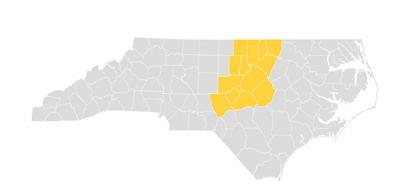
26 BUSINESS NORTH CAROLINA NC TREND ››› Statewide
BURLINGTON
PHOTOS COURTESY OF GLEN RAVEN AND UNC

A 2013 UNC Chapel Hill spinout, AgBiome tapped Ginkgo Bioworks to help accelerate the development of new agricultural biologicals and improve existing products used in crop protection. AgBiome has raised more than $253 million to date.
A group of lenders is providing as much as $2 billion to semiconductor maker Wolfspeed, Bloomberg reports. The financing, led by Apollo Global Management, and structured as seven-year secured notes, makes $1.25 billion of cash immediately available to the company. Another $750 million can be drawn later. Wolfspeed also signed a 10-year chip deal with Japan-based Renesas Electronics Corporation, which provided a $2 billion deposit as part of the agreement.
Fortrea was spun off from Burlingtonbased testing giant LabCorp and had a stock market value of about $2.7 billion in midJuly. The clinical trials company has about 19,000 employees in 90 nations. LabCorp has about 60,000 employees.

Opus Genetics raised an additional $4.5 million, following its $19 million capital round in 2021. Investors include Foundation Fighting Blindness FD fund, the Manning Family Foundation and Bios Partners. It is developing drugs to treat retinal diseases.
Duke University doctoral students have the right to unionize as Duke employees, the National Labor Relations Board ruled. The ruling comes four months after students filed to form a union with the power to negotiate wages and benefits on their behalf. Duke challenged the effort, saying the students weren’t employees.
State Employees’ Credit Union appointed Leigh Brady CEO after the departure of Jim Hayes, who held the post less than two years. Brady has worked at SECU for 35 years, most recently as chief operating officer. Hayes left the nation’s second-largest credit union to lead a Maryland credit union that serves U.S. State Department employees.
Restore3d, which provides custom-made surgical implants and recently raised $12 million, is acquiring Massachusetts-based Conformis. Publicly traded Conformis had a market cap of $8.6 million when the deal was announced.
Brii Biosciences earned $24 million through the sale of Qpex Biopharma, a San Diego-based firm being acquired by Japanese pharmaceutical company Shionogi. As part of the agreement, Chinese-owned Brii will acquire exclusive global rights to develop and commercialize BRII-693, an antimicrobial under development.
The Marriott Raleigh Durham Research Triangle Park is one of 19 hotels to be returned to lenders after Ashford Hospitality Trust didn’t pay a maturing loan. The 223-room hotel is the 12th largest hotel in the Triangle, according to Triangle Business Journal. It was part of a loan pool for several hotels.
MEBANE
Buc-ee’s is considering a 120-pump travel plaza on 32.49 acres along I-85/40, with state and local government approval still required. Lake Jackson, Texas-based Bucee’s previously dropped plans for a similar project in nearby Efland. It would be the first Buc-ee’s in North Carolina.
MORRISVILLE
Biotech Incyclix secured nearly $3 million in a $30 million round announced in 2022. The company’s founders include PPD founder Fred Eshelman. It previously raised $12 million to develop a drug to fight cancer.
Lars Petersen was named president and CEO of Fujifilm Diosynth Biotechnologies, succeeding Martin Meeson. The company is building a $2 billion production plant in Holly Springs.

28 BUSINESS NORTH CAROLINA NC TREND ››› Statewide
RALEIGH

Surround Medical Systems raised $4.4 million from investors to support a launch of its 3D dental imaging system. The privately held company, which has 115 investors, has raised about $42 million total and wants to raise another $5.6 million in this round.

MONCURE
VinFast, the Vietnamese automaker planning a car and battery manufacturing facility here, reported a first quarter net loss of $598 million. The startup company lost $2.1 billion in 2022 and $1.3 billion in 2021.
RALEIGH

Dr. Anita Louise Jackson was sentenced to 25 years in prison for using unsanitary surgical devices, Medicare fraud and stealing patient identities. She was also ordered to serve three years of supervised release and ordered to forfeit $4.7 million.
Sustainability firm GreenPlaces, which helps companies save money on their utility bills, raised $13 million in a Series A funding round, led by the California-based venture capital firm Redpoint Ventures. Investors include Durham’s Bull City Venture Partners. GreenPlaces plans to double its staff of 22.
NovaQuest Capital Management raised $90 million in a new fund to invest in biopharmaceutical companies, and plans to gather as much as $800 million. Founded in 2010, NovaQuest has attracted more than $2.5 billion and manages more than $3.6 billion in assets.
WAKE FOREST
The parent company of Piedmont Federal Savings Bank is buying Wake Forest Bancshares for $14.95 million. The Wake County savings and loan was founded in 1922.
WEST
ASHEVILLE
PLI Holdings, which makes hotel key cards for customers around the world, is laying off 51 workers, according to a state filing. The company, which started in 1988, said in a state filing that the layoffs began on June 6 and would be permanent.
BOONE
ASHEVILLE
Since debuting 23 years ago, Tupelo Honey has morphed from a quirky late-night restaurant dressing up Southern ingredients for locals to a chain with 22 locations. It plans to open about six new units per year. The owner is Stephen Frabitore.

Home2 Suites by Hilton North Star Villages plans a 105-room hotel and adjacent parking lot. The project cost is $9.6 million, according to the application. The hotel will be four stories and is about 2 miles northeast of Appalachian State University. ■
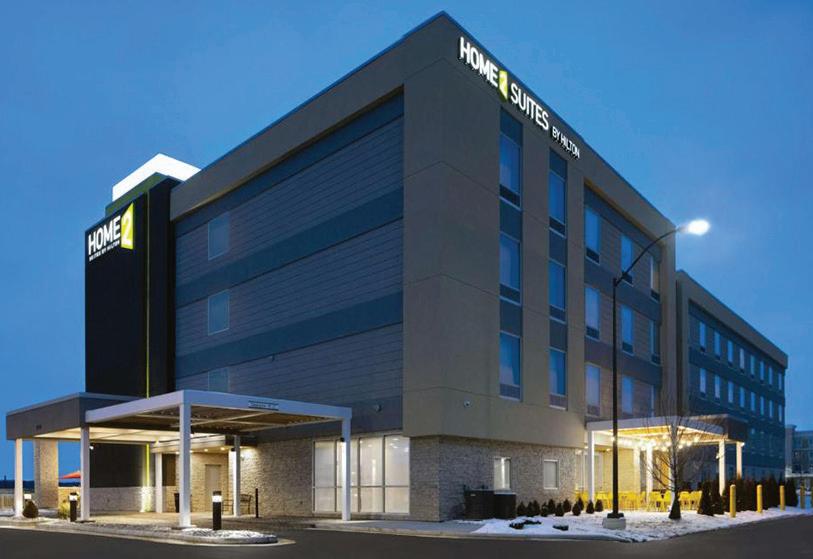
30 BUSINESS NORTH CAROLINA NC TREND ››› Statewide
PHOTOS COURTESY OF TUPELO HONEY AND HOME2 SUITES

CONVENTIONS COMEBACK
Conference facilities expand to accommodate rise in bookings.
Meetings and conventions in North Carolina are on the rise as the limitations of the pandemic fade into the rearview mirror.
The business community is eager for business as usual, said Rich Phaneuf, CEO of Association Executives of North Carolina, a Raleigh-based organization representing the state’s trade association leaders and meeting planners.
“If anything, over the past 12 months we’ve experienced a flooded market of association executives wanting to get out and meet in person,” Phaneuf said.

To handle the increasing business in the state’s major
conference cities, expansion is the name of the game. WinstonSalem and Charlotte have already enhanced their convention centers, and Raleigh is eyeing a major expansion.

In Asheville, a new Embassy Suites is coming online next year, providing a modern contrast to three new hotels that celebrate the city’s storied history. Asheville is embracing the romance of the past with the prohibition-themed Flat Iron Hotel, Zelda Dearest, an ode to Asheville’s literary history, and the Radical, which breathes new life into a historic manufacturing building in the River Arts District. All are expected to open this fall, says Michael Kryzanek, vice
president of business development at Explore Asheville.
The pandemic restrictions that forced people to flock to the great outdoors have yielded new opportunities for conference and leisure travelers alike, and Asheville is keeping the momentum going with guided hikes, foraging adventures, river paddles and biking excursions.
“Local farms are expanding into agritourism, offering farm tours, tastings and opportunities to enjoy our renowned food scene on an organic level,” Kryzanek says.
The Charlotte Convention Center’s $127-million expansion in 2020 means more conferencegoers can meet in the Queen City
SPONSORED SECTION 32 BUSINESS NORTH CAROLINA
CORPORATE MEETING GUIDE
and explore all the greater area has to offer, says Bill McMillan, senior director of sales for the Charlotte Regional Visitors Authority.
“Charlotte is busier than ever, and we are receiving leads far above our usual pace,” McMillan adds.

When conference attendees are ready to take a break from meetings at the Charlotte Convention Center, they can board the light rail and visit other areas of the city, like South End, a walkable district offering restaurants, bars and shopping, along with offices.
In some major meeting venues, sales teams are still juggling meeting space for clients re-booking conferences that were postponed during the pandemic. That trend is easing up and planners are starting to look ahead again. Christian Schroeder, director of sales and services at Visit Winston-Salem is relieved to have some breathing room.
“We joke in the office that it has been a bit of a Tetris game trying to fit the different meetings and conferences in the weeks and patterns planners want, and we’re glad to see them reserving space further out,” he says.


Last year, Winston-Salem put out the welcome mat at its newly refurbished Benton South, a renovated section of the 150,000-square-foot convention center in the heart of downtown.

And in Raleigh, the meetings sector is enjoying its highest volume of business ever, says Dennis Edwards, president and CEO of Visit Raleigh.
“Our leads are up 36% and in this fiscal year, we have booked 334 meetings and conventions, which is up 16%,” he says.

To accommodate the growth, the city is reviewing design concepts for a convention center expansion. Hotels and meeting facilities in new multi-use neighborhoods like North Hills offer options outside of downtown.
While North Carolina’s hospitality sector is excited that convention business is on the rise, Wit Tuttell, executive director of Visit North Carolina says travel is still in recovery mode.
“While travel increased about 43% from 2021 to 2022, it’s still down about 15% from pre-pandemic levels,” he says. “Hospitality employment is also lagging about 3% since 2019, and jobs are plentiful.”

Tuttle pointed out that most overnight visitors in
AUDIOVISUAL EXPERIENCES


Unleash the power of extraordinary audiovisual experiences! We transform spaces with captivating visuals and crystal-clear sound. Engage your audience with dynamic projection mapping and mesmerizing soundscapes. Our seamless execution ensures a flawless event. Create unforgettable memories that linger long after the lights dim. Let us bring your vision to life.

33 AUGUST 2023
D2 Production Services 704-443-8562 | d2productions.com
SEE OUR AD ON PAGE 19
North Carolina are residents traveling within the state or traveling here from states along the East Coast, he adds. Fortunately, travel to North Carolina has not been largely impacted by airline difficulties.
“We are fortunate that we are mostly a drive-to state, so any lingering air travel issues can actually benefit us when visitors decide they’d rather drive than fly,” Tuttell says. “On the other hand, more long-haul travelers are returning to the skies, giving visitors another option for how to get here.” ■
Destinations
For your next corporate meeting and conventions:




Asheville
Charlotte
Greensboro
Greenville
Hickory
Hot
Springs, VA
Pinehurst
Raleigh
Rocky Mount
Winston-Salem
SPONSORED SECTION 34 BUSINESS NORTH CAROLINA CORPORATE MEETING GUIDE
— Teri Saylor is a freelance writer from Raleigh.
The newly refurbished Benton Convention Center in Winston-Salem puts visitors near restaurants, breweries, museums and other downtown attractions.
34 BUSINESS NORTH CAROLINA PHOTO COURTESY OF VISIT WINSTON-SALEM

MEETINGS MEAN BUSINESS IN GREENVILLE
Greenville is the vibrant economic, education, medical, and entertainment hub of Eastern North Carolina. Greenville is a growing destination situated conveniently between Raleigh and our N.C. beaches, where from our Greenville Convention Center Campus, to East Carolina University, to our Downtown Greenville District, you will find a community dedicated to ensuring unrivaled experiences and good company at every turn!
Rachel Whitten, CMP, Vice President of Sales & Services 252-329-4244 | visitgreenvillenc.com





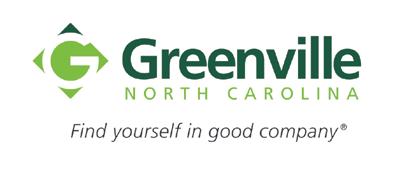


SEE OUR AD ON PAGE 25
EXPERIENCE IT ALL, IN ONE PLACE
Uncover the charm and history of Greensboro while enjoying a distinctive stay at one of North Carolina’s premier resorts. Featuring two challenging golf courses, The Spa at Grandover, tennis, seasonal Southern favorites at DiValletta Restaurant, handcrafted cocktails at one of our bars, live entertainment, a game room and an art gallery. The conference center features meeting rooms, unique ballrooms and lovely outdoor venues.
1000 Club Road | Greensboro, NC 27407 336-294-1800 | grandoverresort.com


REIMAGINED SPACES

The Hickory Metro Convention Center is growing with reimagined spaces. Adding over 46,000 SQFT of NEW space and renovating 30,000 SQFT of original space. These new and improved spaces are the sweet spot in meeting destinations located just an hour outside of Charlotte and in the beautiful N.C. foothills.



1960 13th Avenue Dr. SE | Hickory, NC 28602 828-322-1335 | visithickorymetro.com















SEE OUR AD ON PAGE 24
HISTORY. REINVENTED.
An extensive $150 million investment brings revitalized public spaces, a new event pavilion, 483 renovated guest rooms and a reimagination of 72,000 sq. ft. of distinct indoor meeting space. Enhance your experience with 40+ activities including golf, spa, sporting clays, zip line canopy tour, fly fishing, horseback riding and falconry.
7696 Sam Snead Hwy | Hot Springs, VA 24445 888-796-5838 | TheOmniHomestead.com

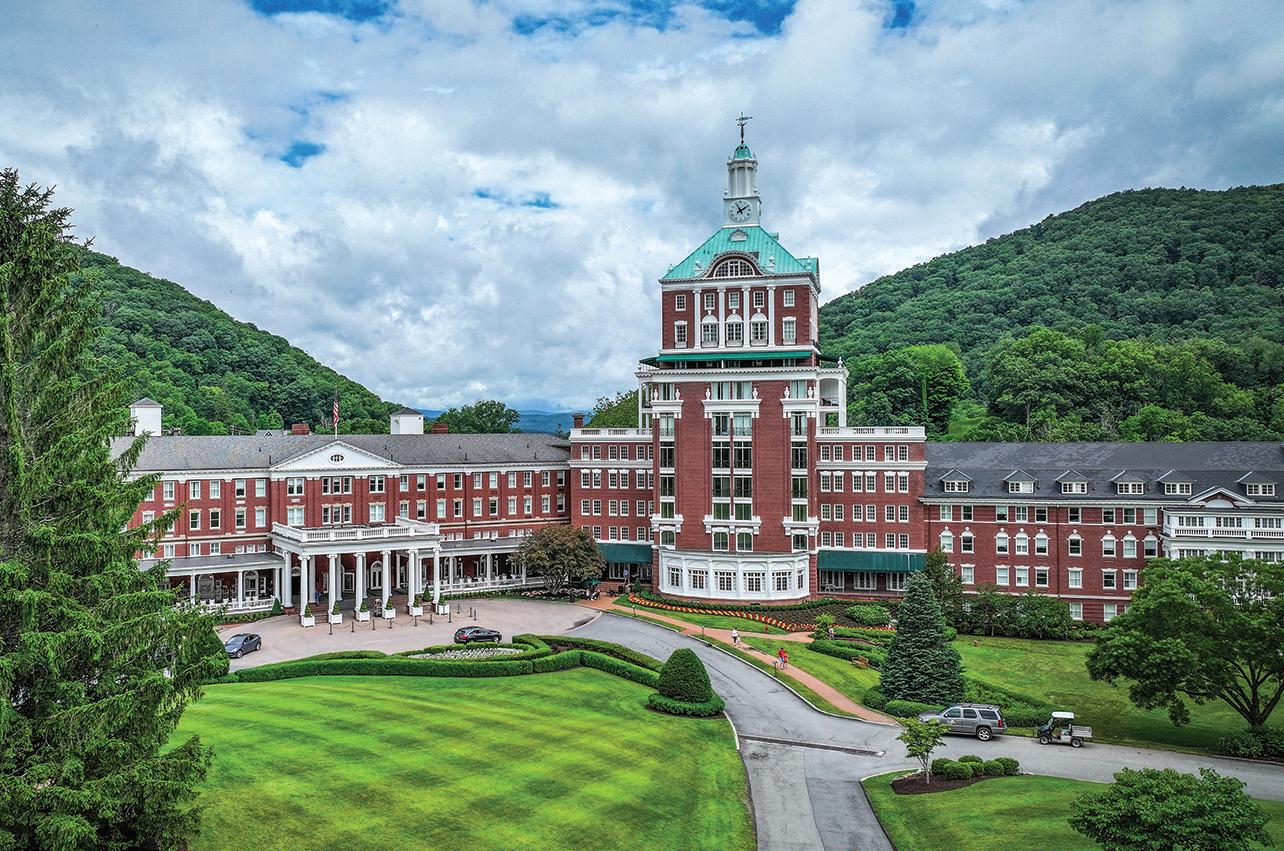
SEE OUR AD ON INSIDE FRONT COVER

SPONSORED SECTION 36 BUSINESS NORTH CAROLINA CORPORATE MEETING GUIDE SPONSORED SECTION 36 BUSINESS NORTH CAROLINA
SEE OUR AD ON PAGE 31
ASHEVILLE DOWNTOWN
This winter, Embassy Suites by Hilton Asheville Downtown will bring188 guest suites and over 7,000 square feet of new, flexible meeting and event space, including outdoor space for daytime events at its rooftop restaurant, Soprana, boasting expansive mountain views. The hotel is walkable to all downtown shops and breweries.

192 Haywood Street | Asheville, NC 28801







828-407-0422 | ashevilledowntown.embassysuites.com





1895
That’s when Pinehurst began welcoming guests to its tree-shaded grounds. From executive boardrooms to expansive event spaces, our seamless blend of Southern hospitality and innovation sets the stage for gatherings that will leave your attendees energized and inspired. Elevate your meetings at Pinehurst Resort, home of the 2024 U.S. Open.


800-ITS-GOLF pinehurst.com




YOUR EVENT, YOUR WAY

Conveniently located just an hour from Raleigh, North Carolina and just a couple of hours drive from the coast of N.C., the state-of-the-art event venue the Rocky Mount Event Center has everything you need to host your meeting, lunch, happy hour, dinner and holiday party. With an aerial ropes course, climbing walls, arcade, flexible rooms, and a full-service in-house catering team where you can create your own menu, your guests will have an experience that they will never forget!

rockymountevents.com













LOOK FORWARD, TRAVEL BACK
Visit Winston-Salem is the official sales and marketing organization responsible for marketing greater Winston-Salem as a premier tourism destination for the economic benefit of the community. Visit Winston-Salem is responsible for developing and implementing strategic destination campaigns to increase leisure visitation, conventions, and sporting events in Winston-Salem.

200 Brookstown Avenue | Winston-Salem 336-728-4200 | visitwinstonsalem.com


37 AUGUST 2023 37 AUGUST 2023
SEE OUR AD ON PAGE 34
SEE OUR AD ON INSIDE BACK COVER
SEE OUR AD ON PAGE 35
OUR AD ON PAGE 29
SEE
“YOU AREN’T ABLE TO JUST DO IT WITH A WRENCH ANYMORE.”
Computerization and robotics are key for production, recruiting and education. For this Business North Carolina round table, manufacturing leaders talk about technology, post-COVID growth, shortage of employees, reaching students early and cybersecurity.



Cargo Transporters, Mertek Solutions, NC Chamber, Pitt County Economic Development, The Rise Companies, Technology Associates and UNC Charlotte sponsored the discussion. It was edited for brevity and clarity.
YOU REPRESENT DIVERSE MANUFACTURERS. CAN YOU TELL US ABOUT YOUR COMPANY?


SILVER: Ketchie is a precision machine shop in Concord. We mainly support the railroad, heavy equipment and road construction equipment industries.
MCINTYRE: I’m the site director for Avient Protective Materials. We manufacture Dyneema, which is the strongest synthetic fiber in the world. It’s made in Greenville. There’s also a smaller facility in the Netherlands. It goes into bulletproof vests, cut-resistant gloves, ropes, nets and consumer applications.
PEDLEY: Mertek Solutions is in Sanford. We design and build automated assembly and test equipment. Business North Carolina named me Mr. Robot years ago and it seems to have stuck with me, so I appreciate that.
ANDERSON: The RISE Companies is an investment company. We are buying
38 BUSINESS NORTH CAROLINA ROUND TABLE MANUFACTURING SPONSORED SECTION
PICTURED BELOW, FIRST ROW:

JON ANDERSON president, RISE Companies
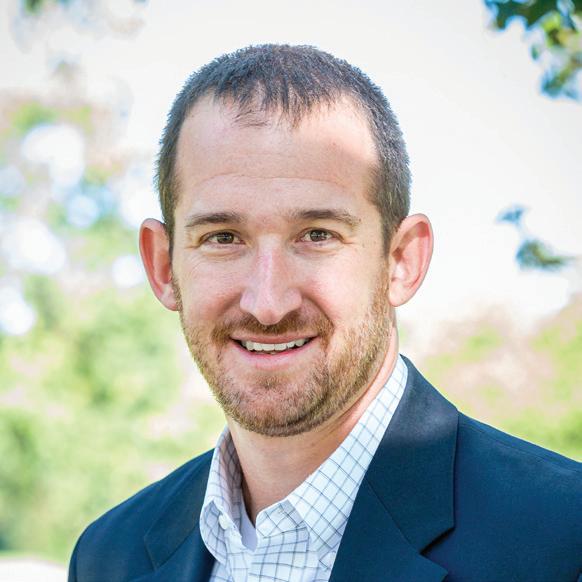
ERIC HOBBS president, Technology Associates

SCOTT MCINTYRE site manager, Avient Corporation



SECOND ROW: THIRD ROW:

PHIL MINTZ (MODERATOR) executive director, N.C. State Industry Expansion Solutions director, North Carolina Manufacturing Extension Partnership
BRIGID MULLANY mechanical engineering professor, associate dean for research, UNC Charlotte


JERRY PEDLEY president, Mertek Solutions




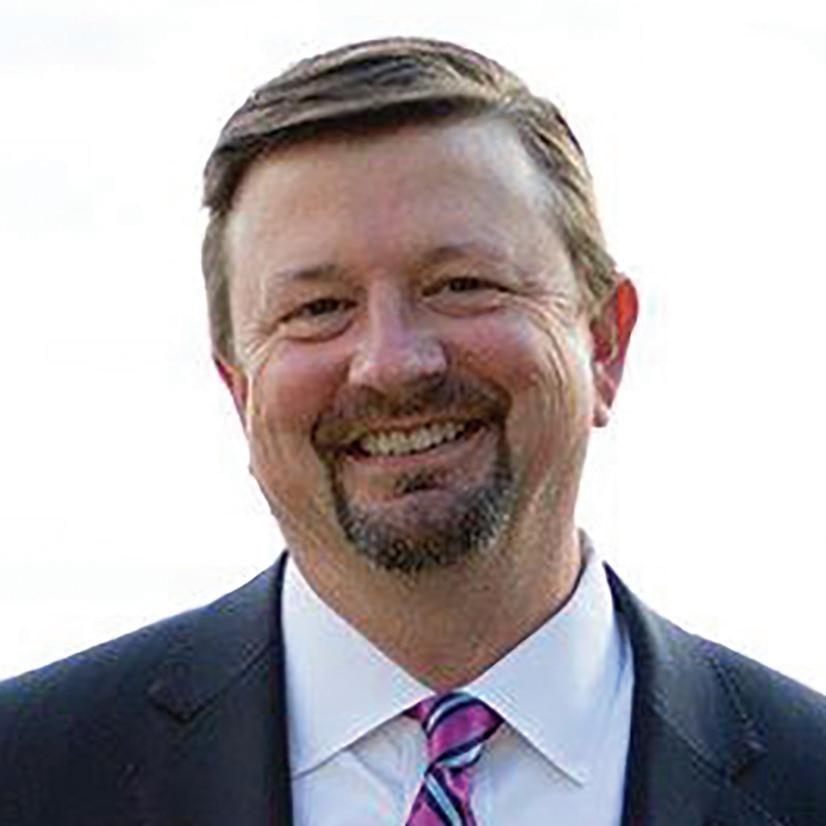
GARY SALAMIDO president and CEO, NC Chamber COURTNEY SILVER president, Ketchie Inc.

39 AUGUST 2023
and leading companies in manufacturing and industrial industries. Current companies are in commercial electrical contracting and metal fabrication.

HOBBS: Technology Associates is based in Raleigh. We’re a full service technology solutions firm providing support for smallto medium-sized businesses.

MINTZ: N.C. State Industry Expansion Solutions is an extension and outreach division of the College of Engineering on campus. I also operate as the director of the North Carolina Manufacturing Extension Partnership. It’s geared to work with mostly smaller manufacturers, to make sure that N.C. manufacturers have all the things that they need such as best practices and access to technology information.
WHAT IS THE STATE OF MANUFACTURING IN NORTH CAROLINA? ARE THINGS AS GOOD AS BEFORE COVID?
MCINTYRE: I can’t speak for the state. I can certainly talk more for eastern North Carolina. Trying to recruit people into manufacturing now is very, very difficult. It has been since the pandemic. We are sold out to our capacity. I know that our next-door neighbors, Thermo Fisher (pharmaceutical and biotechnology sectors), they are growing like crazy. We have HysterYale, which makes lift trucks and we have Grady White Boats. All of them have hiring signs outside of their plants. So I think that says a lot about how positively manufacturing is going. In
SPONSORED SECTION 40 BUSINESS NORTH CAROLINA ROUND TABLE MANUFACTURING
the past, we put an application out and within four or five days, we’d have hundreds of applicants. For a technician job now we get 10 to 20 applicants. I think the generation coming through now, these jobs are not as appealing maybe as 10, 20, 30 years ago. My son is 22 years old. He wants to work in social media or something that’s going to make him rich very quickly.
SILVER: We have a very long backlog. North Carolina has always been a manufacturing powerhouse. That probably speaks to why we were founded here in1947. We have a low cost of doing business in our state compared to other states. We have a competitive tax rate. Nationally, there are 13 million manufacturing

workers, and that’s the highest level of manufacturing workers that we’ve had since 2008. I saw that the manufacturing sector averaged 780,000 job openings for our sector over the last 12 months.
JERRY, ARE YOU STILL GETTING ORDERS FOR THESE SYSTEMS THAT COMPANIES USE TO TRY TO MITIGATE MAYBE SOME OF THE WORKFORCE ISSUES?
PEDLEY: Everybody wants a machine to do projects at this time. We have shipped a lot of machines. A project for us is a year long. We’ve seen shifts in our customers from, from automotive to medical and consumer goods. We have a lot of skilled employees all over. And yes, people
want robots to put things together when it has a good return on investment.
GARY, WHAT IS YOUR MANUFACTURING COUNCIL TELLING YOU?
SALAMIDO: We’re hearing a lot about what you all have been saying so far. I know the (shortage of) talent piece is real. We need to get our young people interested in the incredible work that’s going on. It’s not your father’s or grandfather’s manufacturing anymore. We need a lot of talent that can be utilized in different ways. We’re really competitive along a lot of dimensions. We want to continue to be a state that attracts talent from all over the world.
41 AUGUST 2023
WHAT ARE SOME THINGS YOU ARE DOING TO HELP YOUR SITUATION WITH RECRUITING WORKERS INTO MANUFACTURING?


MCINTYRE: We’ve tried a bit of everything. During COVID, we did have to bring some lines down. We shut down three of our six lines. Then we had to ramp back up. We are looking to bring in another 50 to100 people and it’s been a challenge. For two years we were understaffed. Just at the end of last year we managed to get fully staffed. We’ve tried different recruiters and different ways of advertising. One of the most effective ways was having a job fair on the site. We did a social media blast to everyone within a certain area. We had a tremendous response to that. It
was almost like speed dating. You would come in, you would get an overview of the company, then ultimately the last table was to sign up for a job if both sides were interested. So that worked well, but that was a panic situation.
What we’re figuring out right now is how do we get more integrated going forward so that we don’t get to that position that we’re really struggling to get people in. We’re working more closely with the schools now. We will bring in school children and teachers and tell them what we do. Coming from Scotland to the U.S. I have seen that apprenticeships are not nearly as big a deal here. In Scotland and in Europe in general, at the end of an apprenticeship, nine times out of 10, a full-time job would come. That’s something that
SPONSORED SECTION 42 BUSINESS NORTH CAROLINA ROUND TABLE MANUFACTURING
we are looking at with the veteran community and Pitt Community College.

SILVER: We’re also doing a whole lot at once. We’re making investments in machining technology, robotics, automation and in our workforce. Earlier this year, we invested in a collaborative robot. So not only does it bring down our lead times, increase our output and reduce our backlog, it helps attract a skilled workforce. This next generation of workers wants to use creativity and work on the latest and greatest technology. During interviews, we’ve had people say: “It’s really great that you’re investing so much in technology and robotics and have this vision.” We have an apprenticeship program here at Ketchie. We also started something
this year called Opportunity Knocks. It’s a high school internship program. They come to Ketchie for four days a week and have mentors in the shop. Each day is two hours. They job shadow machinists for three days. On the fourth day they’re in a classroom setting. It’s been so energizing to see some of my team members who have been machinists for 30 years have the opportunity to give back and share knowledge.
ERIC, HOW ARE YOU ADDRESSING DATA MANAGEMENT AND CYBER ISSUES?
HOBBS: First, to echo what’s already been talked about, we have heard consistently across all of our manufacturing and construction
companies that it’s a record year for them as a company. Many have been around 40 years. We’re hearing a lot less about how they can’t get products. It’s finding employees that is the sticking point. In the past from a recruiting standpoint, you’d post the openings and pray. Now we see human resources as kind of the other side of the growth-and-sales coin. We’re a 30-person company, probably the smallest in this group here, but we have a full-time person doing nothing but human resources and recruiting. From a cybersecurity standpoint, it’s worse and worse. I think there is a preconceived notion that manufacturing can kind of fly under the radar. FBI reports show that manufacturing as a group is around 14% of all cyber related breaches.
43 AUGUST 2023
Our customers are really getting focused on security. A lot of people focus on ransomware. From the data we see, ransomware really isn’t the biggest risk in the cybersecurity landscape. It’s more business email compromises. An FBI study said ransomware resulted in about $34 million in losses in the U.S. and the cost of business email compromise was $2.75 billion. That’s 80 times the risk. We are telling our manufacturing clients: “80% of your problem is coming from people and less than10% is coming from vulnerabilities.” It’s the employees who willingly click on something, give up credentials and get hacked that are the problem. If folks would simply instate an operational requirement to verify any banking changes via phone you would virtually eliminate all the business email
compromised risks. If we can get people to do common sense approaches versus looking for another tool to employ I think they would be in a better position. We’ve had people call us from across the state, a lot in manufacturing and they say: “We just transferred $50,000 to the wrong account.” We’re trying to get people to focus on how to mitigate that exposure rather than invest a boatload of money in more IT infrastructure.
BRIGID, WHAT IS UNCC WORKING ON THAT GIVES US AN INDICATION OF WHERE MANUFACTURING IS GOING?
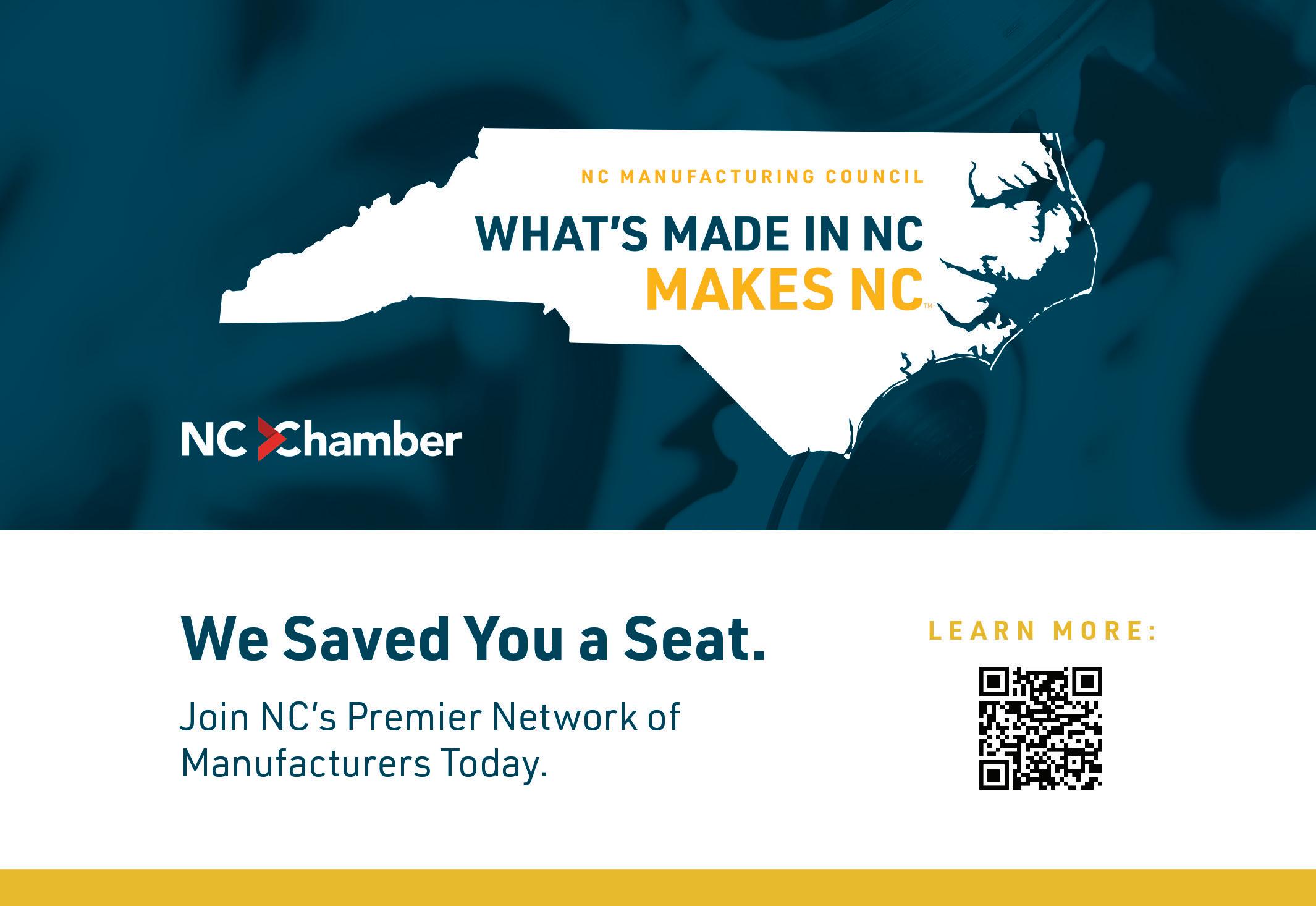
MULLANY: Digital is coming into everything that we do and a lot of the manufacturing faculty embrace that.
We’ve had a lot of recent new hires in manufacturing here at UNCC and all of them have a digital component to their work, either machine learning or visual guided human-robot collaborative assembly. Students come in thinking they know what manufacturing is, but they don’t realize all the bells and whistles that come with it. You aren’t able to just do it with a wrench anymore. You need to hook it up to a computer and do the diagnostics and program it. Manufacturing has evolved so much. We’re seeing more of the collaboration between computer science and manufacturing. Curriculums have to evolve. There is basic core material you have to cover to have a safe engineer out in the world. A lot of curriculum is students working with faculty in the
SPONSORED SECTION 44 BUSINESS NORTH CAROLINA ROUND TABLE MANUFACTURING
research labs. They get into the lab and teachers say: “You know that thing you learned in class, well here’s the application and the machine learning.”
IN THE COLLEGE OF ENGINEERING HERE AT N.C. STATE WE PROMOTE STUDENTS TAKING ON SUMMER INTERNSHIPS AT FACTORIES. ARE YOU SEEING MUCH OF THIS?
MULLANY: UNCC has that too. I think 80% of them are industry funded, the industry sponsors are on the team. It’s like a two-semester long interview for a student, or a two-semester long introduction to a company. The linkage with the industry is key. The National Academies report (press covering science, engineering and medicine) report was also pushing it. They
want the National Science Foundation to fund more undergraduate internships at companies. I hope some of the federal dollars will make their way to that.
PEDLEY: I don’t think there is anything more important than to get involved with your area high schools and their academies of engineering, your community college and your universities.
NORTH CAROLINA CONTINUES TO RECRUIT THESE HUGE FACTORIES THAT NEED EVEN MORE WORKERS. WHAT ARE YOUR THOUGHTS ABOUT THAT?

SALAMIDO: In the public system right now, there are a couple of initiatives that are a great opportunity for that
engagement that Jerry talked about. The Department of Public Instruction recently launched a career planning piece. They are going to start introducing students in middle school to what a career plan could look like. Introducing manufacturing careers is a way of keeping potential employees in the pipeline. Companies want to know that there’s a predictable capacity and alignment between what the employers need and what the education system is producing. If they’re going to invest tens of millions, hundreds of millions, billions of dollars they want to know that there are going to be workers here for a long time. Also, we’re hearing a lot more about second chance hiring as an opportunity. Manufacturing can play an important role there. We can make sure that we introduce those
45 AUGUST 2023
folks that have not had any felonies or anything violent, but have been caught in the system and have not been able to figure a way back, into the workforce. North Carolina is a veteran-friendly state. There is opportunity with our veterans to continue to build the relationships with the business community and the manufacturing community.
JON, AS A RECOVERING BANKER, AS YOU DESCRIBED YOURSELF, WHAT KIND OF PROJECTS ARE YOU HEARING ABOUT? WHAT WHAT DO MANUFACTURERS NEED?
ANDERSON: I think Jerry will be glad to hear the answer, but, certainly people are looking for any sort of robotics, any sort of machinery that could make their plants faster. They are certainly looking to invest in either automation or recruitment.

WHAT DOES THE FUTURE LOOK LIKE IN TERMS OF GROWTH?
MCINTYRE: We’ve got three segments. The biggest is personal protection
for the military, law enforcement, first responders and those needs. We expect that to continue to grow. The other one is marine industrial fibers, ropes and nets that are on tankers and cruise ships. They’re also in the sustainable side of things because they’re used to tethering down offshore wind farms. Another segment is nets, which are in aquaculture and even every major baseball stadium has a net that’s got Dyneema fiber in it. I think our growth area is in the consumer side. We’ve got fiber that is going into tents and end users are saving because of the sustainability. The final product is less weight and requires a lot less fuel to transport and lasts longer. We’re going have to build a new fiber production line, which is a very significant investment. That will be in Greenville. The decision has been made, it won’t be in the Netherlands or China.
SILVER: We definitely have a strong vision of growth because our customers require it. I really think our whole country needs manufacturing to be
a team sport. We need to use our partners in our community, like the N.C. Industrial Commission, the N.C. Manufacturing Institute, the Small Business and Technology Center. We have to work together. Especially the small- and medium-sized manufacturers, we have to grow. There are challenges, especially as a small manufacturer. Investing in robotics and needing that ROI, is crucial for the small manufacturer, but they don’t have a lot of sources of capital, like larger manufacturers. So you need really good partnerships in the community, and to have good suppliers and good robotic integrators. We need to not only service our current customers, but go into industries that we aren’t in yet.
PEDLEY: Medical and consumer goods are certainly areas we’re looking at for growth. Medical device assembly, things like that. ■
SPONSORED SECTION 46 BUSINESS NORTH CAROLINA ROUND TABLE MANUFACTURING

Mixed signals
Most big N.C.-based stocks soared over the past year. But 33 of the 75 showed declines.
By Chris Roush and David Mildenberg
stocks of North Carolina’s 75 largest public companies took widely divergent paths in the past year: 17 recorded gains of more than 40%, while nine declined by at least 40%.
That was a major change from a year earlier, when only 12 of the 75 companies showed any increases, reflecting a particularly bloody period for investors.
Of the 20 largest North Carolina companies in terms of market capitalization, 15 recorded gains from July 1, 2022 to June 30, 2023. Ten posted bigger increases than the 17.3% increase in the S&P 500 Index during that period. Most of the gains occurred in the first half this year, with the index increasing 16%.

Star performers among N.C. stocks included three Wake County-based companies. Telecommunications-equipment maker Extreme Networks soared 192% as analysts said it took
some business away from giant Cisco Systems. Raleigh-based First Citizens Bancshares gained 96%, much of the increase coming after it bought the assets of failed Silicon Valley Bank in a governmentassisted deal. Liquida Technologies’ promising treatment for hypertension helped its shares gain 80%.
Overall, 27 of the top 75 companies performed better than the overall market.
Unfortunately, 33 companies declined during the 12 months. Advance Auto Parts and medical device maker Bioventus each declined 58%. The Raleigh-based retailer reported sharply lower profit and cut its annual dividend from $1.50 to 25 cents. Durhambased Bioventus sank as CEO Ken Reali departed in April after backing out of a deal to buy a California-based surgical implant business. The company reported a loss of $213 million last year,
48 BUSINESS NORTH CAROLINA
following a $10 million pro t in 2021.
Eight companies joined the list this year, led by No. 33 RXO, based in Charlotte and a spino from Greenwich, Conn.based XPO; and No. 34 ProKidney, based in Winston-Salem, which went public as part of a special purpose acquisition company conversion.
1 TO 25

e biggest departure was Cary-based Cornerstone Building Brands, which was No. 31 a year ago. It was acquired last July by the Clayton, Dubiller & Rice private-equity group.
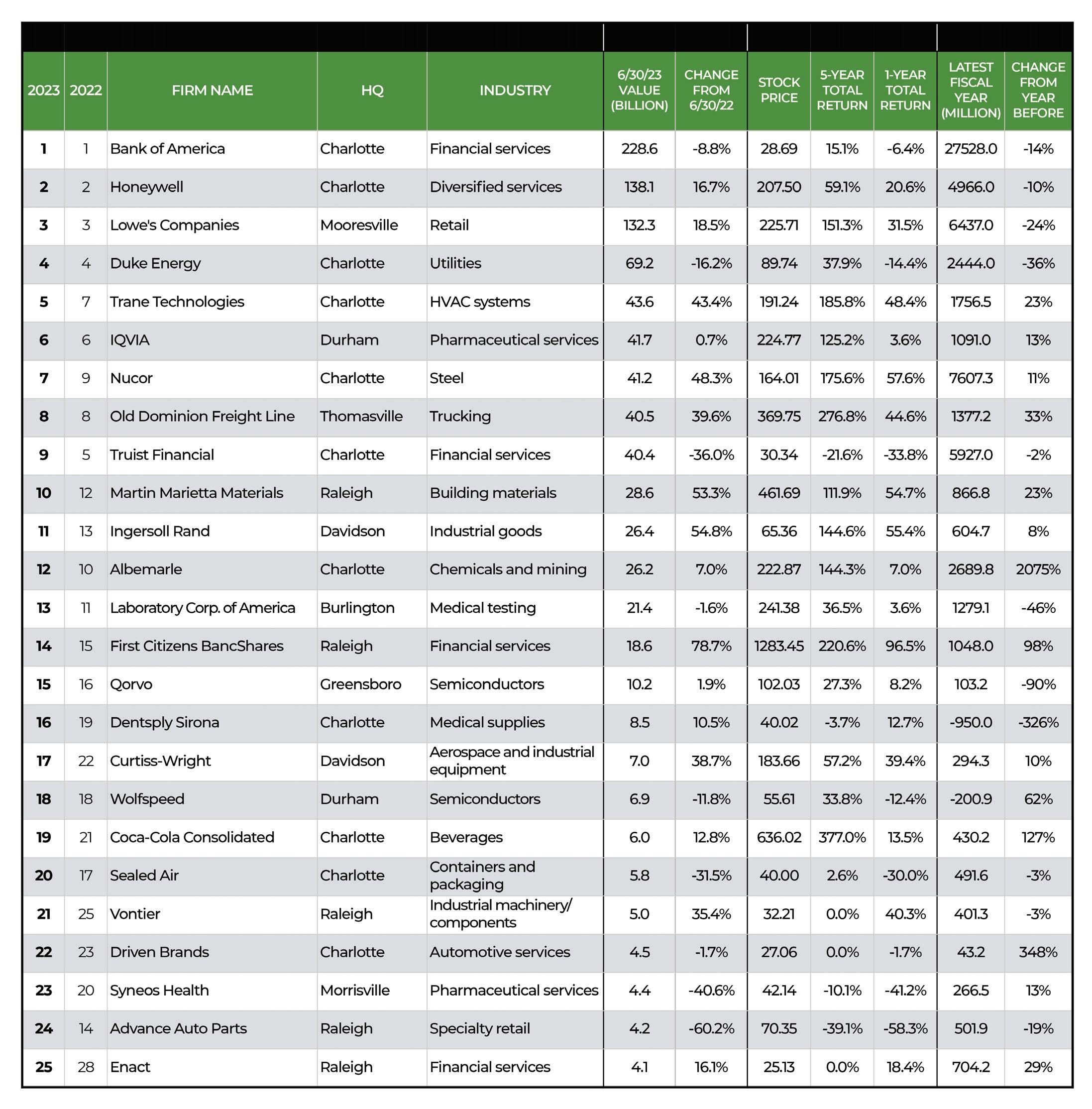
No. 23 Syneos Health is not likely to be on the 2024 list because it has agreed to a $7.1 billion pending sale to a group of private equity rms.



49 AUGUST 2023
MARKET VALUE PRICE & STOCK PERFORMANCE NET INCOME
NEWCOMERS TO THE
DEPARTURES FROM THE


50 BUSINESS NORTH CAROLINA Advance Auto Parts -58 % Bioventus -58 Hanesbrands -53 Glatfelter -52 G1 Therapeutics -50 LendingTree -50 Unifi -43 WORST 1-YEAR RETURNS Coca-Cola Consolidated 377 % Piedmont Lithium 312 Old Dominion 277 Extreme Networks 227 First Citizens 221 Trane Technologies 186 Nucor 176 Ingles Markets 170 BEST 5-YEAR RETURNS Asensus Surgical -99 % G1 Therapeutics -94 LendingTree -90 NN Technologies -86 CommScope -81 Chimerix -75 Unifi -75 WORST 5-YEAR RETURNS Extreme Networks 192 % First Citizens 97 Liquida Technologies 80 AvidXchange 69 Enpro 64 SPX 61 N-Able Technologies 60 BEST 1-YEAR RETURNS Glatfelter 18.5 % Hanesbrands 13.2 Barings BDC 12.5 Cato 8.5 Highwoods Properties 8.4 Truist 6.9 Insteel 6.8 HIGHEST DIVIDEND YIELDS
TOP 75 # COMPANY HQ ACTION ITEM 33 RXO Charlotte Spin-off from XPO 34 ProKidney Winston-Salem SPAC conversion 49 Columbus McKinnon Charlotte HQ relocation 53 NET Power Durham SPAC conversion 60 374Water Durham IPO 71 Fathom Holdings Cary Market cap change 73 Asensus Surgical Durham Market cap change 74 NN Charlotte Market cap change
75 2022 COMPANY HQ SALES RANK PRICE FOUR COMPANIES WERE ACQUIRED DURING THE PAST YEAR 31 Cornerstone Building Brands Cary $5.8 billion 55 ChannelAdvisor Morrisville $663 million 60 Aerie Pharmaceutical Durham $770 million 69 Marrone Bio Innovations Raleigh $236 million THREE COMPANIES HAD LOWER MARKET CAPITALIZATION 58 Sunlight Financial Advisors Charlotte 68 Science 37 Morrisville 74 Peoples Bancorp of North Carolina Newton
COMPANY
BANKRUPTCY 72 Avaya Holdings Durham
TOP
ONE
FILED FOR




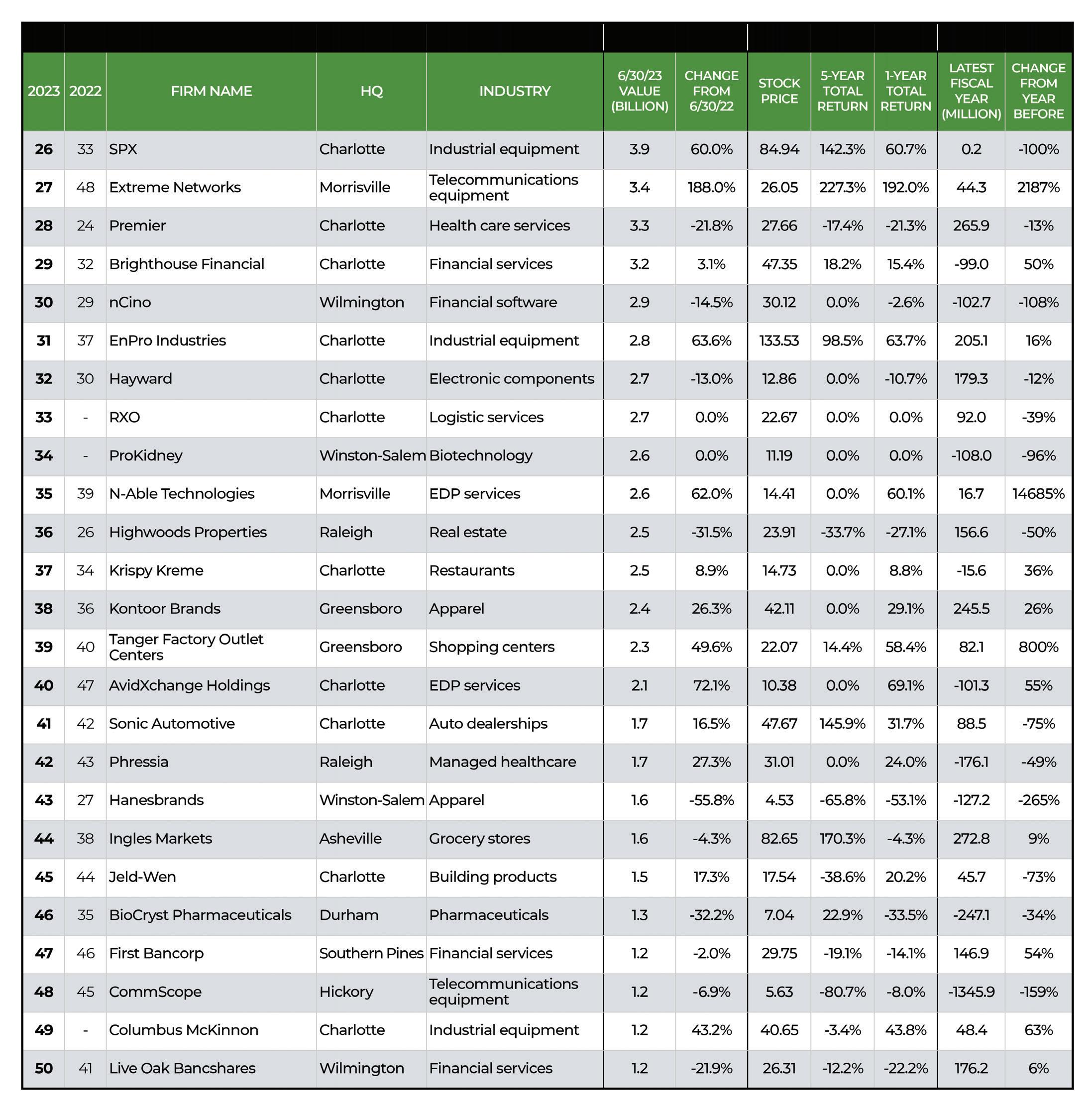



51 AUGUST 2023
26 TO 50
MARKET VALUE PRICE & STOCK PERFORMANCE NET INCOME
MARKET CAP MOVERS TOP-PERFORMING CEOs
THESE COMPANIES SHIFTED UP OR DOWN IN SIGNIFICANT WAYS:
No. 9 Truist
The Charlotte-based bank ranked fifth a year earlier, but instability in the banking industry unnerved investors. The sixth-largest U.S. bank reported a 34% negative total return during the 12-month period.
No. 24 Advance Auto Parts
The Raleigh-based retailer ranked 14th a year earlier. It reported a 19% decline in net income to $501 million and slashed its dividend by more than 80%.
No. 27 Extreme Networks
The Morrisville-based communications software company nearly tripled in value, moving up from No. 48. Industry analysts said Extreme is competing well against industry giant Cisco Systems.


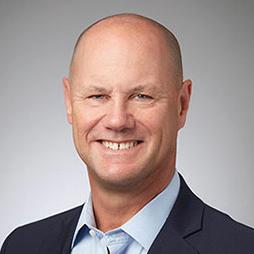
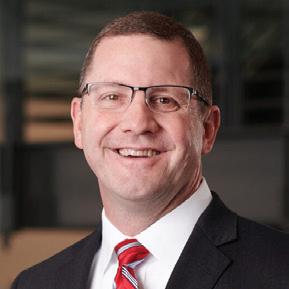
No. 36 Highwoods Properties
Rising office vacancies worried investors, prompting the Raleigh-based real estate investment trust to lose 31.5% of its market cap. It dropped from No. 26 a year earlier.
No. 50 Live Oak Bancshares
The Wilmington-based banking company shed a fifth of its market cap amid worries about credit quality and industry tumult. It ranked No. 41 a year earlier.
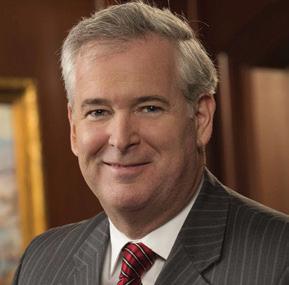
No. 57 Gambling.com
More interest in betting sparked surging interest in the reviews of casinos and betting sites provided by the Charlotte-based company. Its revenue soared 81% to $76.5 million.
No. 65 Fennec Pharmaceuticals
The Durham-based pharmaceutical company is developing a drug to prevent hearing loss in pediatric cancer patients. The drug received marketing approval for 27 European nations in June.
Coca-Cola Consolidated
Frank Harrison III
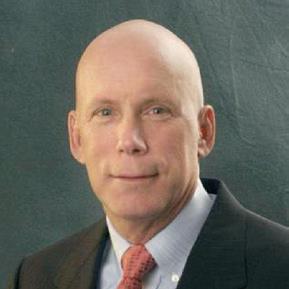
377% return
CEO since 1986
Piedmont Lithium
Keith Phillips
312% return
CEO since 2017
Old Dominion Freight Line
Greg Gantt
277% return
Retired as CEO, June 30 after six years
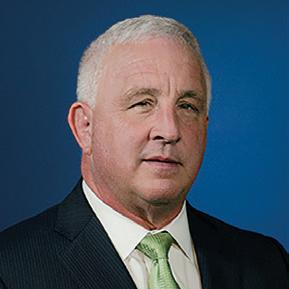
Extreme Networks
Ed Meyercord
227% return
CEO since 2015
First Citizens
Frank Holding Jr.
221% return
CEO since 2008
Trane Technologies
Dave Regnery
186% return
CEO since 2021
Nucor
Leon Topalian
176% return
CEO since 2020
52 BUSINESS NORTH CAROLINA
BEST STOCK MARKET RETURNS OVER THE PAST FIVE YEARS
Data for the Top 25 Public Companies was provided by Matt West, Capital Investment Cos. and Nottingham.



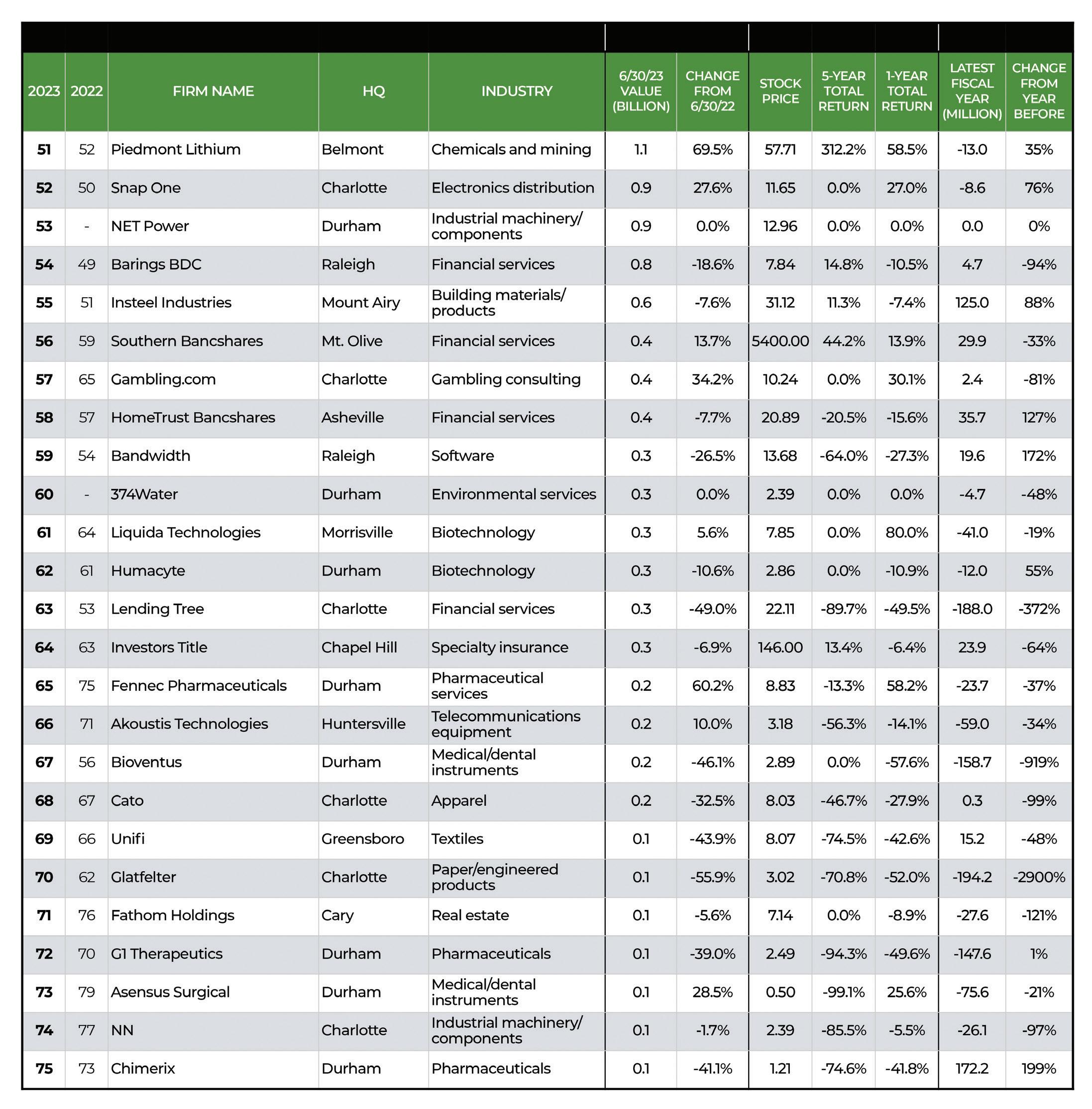




53 AUGUST 2023
MARKET VALUE PRICE & STOCK PERFORMANCE NET INCOME 51 TO 75
TRADING SPACES
Creative approaches are required to sustain the state’s once-dynamic regional malls.
By Chris Roush
When Pat Anderson entered the mall industry in the early 1990s, the business strategy was all “Field of Dreams” — build it and they will come. e industry boasted 2,500 malls throughout the country, and crowds galore.

“When I got into it, it was a development phase,” says Anderson, now senior general manager at e Streets at Southpoint mall in Durham. “And everybody operated a certain way.”

But the 21st century has not been kind to malls and their owners. e COVID-19 pandemic, the ease of online shopping and changing consumer habits are forcing mall owners across the country to nd new ways to keep attracting people to their locations.

54 BUSINESS NORTH CAROLINA
Truliant Federal Credit Union transformed the former Macy's at Hanes Mall in Winston-Salem into its new offices.
PHOTO CREDIT: LLOYD AARON PHOTOGRAPHY FOR TRULIANT
e Streets at Southpoint owner Brook eld Properties recently won approval from the Durham City Council for a hotel, o ce space and apartments to be built around the perimeter of the mall, with construction likely to take place over the next decade. “It’s just a great challenge, and you have to move to the future,” Anderson says. “I think we’re in a position now to move forward and make that happen.”
He’s not alone among North Carolina mall operators. At Hanes Mall in Winston-Salem, Truliant Federal Credit Union recently occupied the former Macy’s space. e owner of Cary’s South Hills Malls and Plaza wants to add as many as 1,750 apartment units and o ce space.
In Chapel Hill, construction has begun to overhaul University Place, built in the 1970s, to include a 253-unit apartment complex, including a swimming pool, in an existing parking lot. A nearby grocery store has been demolished to make room for street-side retail and o ce space.


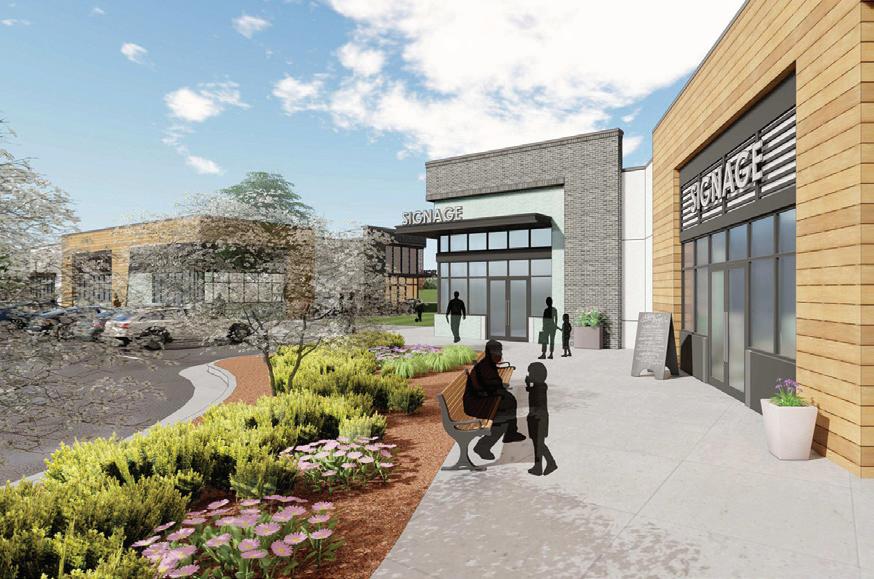
“It’s a big trend throughout not only Carolina but the country,” says Chuck McShane, director of market analytics in the Carolinas for CoStar Group, which tracks commercial real estate trends. “ e development models of malls have shi ed to become much more experiential and much more focused on high-touch premium products or discounted products. e days of going to a mall for a full Saturday and spending your whole time there are gone. at’s where you’re seeing more malls to look to add housing, for the convenience factor.”
e decline of the great American mall growth has been happening for more than a decade. When COVID-19 hit, Coresight Research predicted about 25% of the country’s 1,000 malls would close in the next three to ve years. Now, about 700 enclosed malls remain.
“During COVID, [the pressure on mall owners] accelerated tremendously because people were spending more time at home,” says McShane. “And retail spaces near homes lled up pretty rapidly. So developers are trying to leverage that by locating housing close to malls.”
Department store chain Dayton’s opened the rst enclosed shopping mall in a Minneapolis suburb in 1956 as a way for consumers to browse without having to face harsh weather. (Dayton’s morphed into present-day Target.) Two-story malls arrived in the 1970s, many soon adding movie theaters and food courts. Many were built in the suburbs, drawing shoppers away from downtown retail areas.
By 2001, however, malls were struggling because of overbuilding and the rise of Amazon.com. e Streets at Southpoint, which opened in 2002, contributed to the closing of South Square Mall in Durham, built in 1975, a er Belk and JCPenney relocated to the new mall. (South Square was razed, and the site now houses a Target and a Sam’s Club.) e last regional mall to be built in North Carolina was Northlake Mall in Charlotte, which Taubman Centers opened in 2005.
Retail vacancy rates have shi ed since that time. In 2006, the overall retail vacancy rate in North Carolina was 5.6%, but in malls, it was just 2.5%, according to CoStar Group. Last year, the overall vacancy retail rate for the state had declined to 3.1%, but the mall vacancy rate increased to 7%.
“While 7% might not seem high, there are fully occupied malls, and then those that are struggling with 20-25%-plus vacancies,” says McShane. “It’s a bifurcated market. And many closed malls have been converted to other uses over the years, which has decreased total mall inventory.”
Ram Realty, which is based in Palm Beach Gardens, Florida, acquired what was called University Mall in Chapel Hill in 2018. Built in 1973, the renamed University Place had already lost its two department stores, Dillard’s and Belk, and was anchored by A Southern Season, a local food and cooking retailer. e main
55 AUGUST 2023
Construction at University Place has begun. When completed, the mall will include apartments, a hotel, and a main street.
RENDERINGS COURTESY OF RAM REALTY ADVISORS
attraction for many locals was a Burlington Shoe Factory and a GameStop, both now long gone.
“We had some ideas to redevelop it and turn it into a more lifestyle center,” says Je Kurtz, Ram’s vice president of development.
A er three years of design work and permitting approvals, Ram Realty began construction in October 2022 on a 253-unit apartment complex in the parking lot. e rst oor will include about 9,000 square feet of retail space, primarily for local retailers. Construction should be completed by late 2024.

On the other side of the mall, Ram plans to create a street with about 30,000 square feet of ground- oor shops on both sides with space for movie nights, musical acts and community events. “We view that as the heart of the new University Place,” says Kurtz. “People want to walk around and be outside.” e mall is about 2 miles from downtown Chapel Hill and UNC Chapel Hill.
Ram Realty also has approval to build a 150-room hotel at University Place. All told, it plans to spend about $160 million.
“A lot of malls in their current form are obsolete,” says Kurtz. “It’s just not the way people are shopping these days. When we bought it, we envisioned something more interactive. We did see an opportunity to change the mall to be more in line with shopping habits. ey prefer outdoor spaces. ey want restaurants.”
SilverSpot Cinema and a Planet Fitness — located where a Rose’s once sold discount goods — have outside entrances that attract visitors, along with the Bartaco and Hawkers restaurants. On a Friday night, both usually have a waiting list for tables, and cornhole sets outside Bartaco keep the patrons busy while they wait for seats.
TRULIANT GOES SHOPPING
CBL Properties is taking a di erent strategy at Hanes Mall in Winston-Salem, one of the 94 sites that the Chattanooga-based real estate company owns in 22 states. e mall opened in 1975 and was the state’s largest enclosed mall for decades. In 2018, Novant Health acquired the old Sears location. A er Macy’s closed, Truliant Federal Credit Union spent $8 million for an operations hub, which has about 250 full-time employees. e space can accommodate as many as 550 workers, and opened in January. e company headquarters is across the street.
e employees have access to the mall and its food court, says Chad Frye, Truliant’s senior vice president of facilities. e space is more collaborative than its main o ce, allowing for more conversations.


Frye calls the operations center employees who work at Hanes Mall the “walking wallets.”

“ e mall needs consistent shoppers, and Truliant is providing them,” says Frye. “ ere de nitely is an ease of access to shopping and eating and the ability to walk around the mall from a well-being and exercise standpoint.”

Hanes Mall added a Dave & Buster’s restaurant in 2019 and high-end sneaker retailer Swish in late 2021. e mall, says CBL Vice President Stacey Keating, returned to pre-pandemic levels of sales and tra c by the end of 2021. “Even though sales have cooled some because of broader economic uncertainty, we’ve continued to enjoy tra c and sales that are above pre-pandemic levels.”
Raleigh-based Loden Properties and partner Northpond Partners of Chicago bought Cary’s South Hills Mall Plaza for nearly $40 million in 2021. e key attraction was the location of Cary’s oldest mall at the intersection of U.S. 1 and Interstate 40. “South Hills sits at one of the prominent intersections in the state,” says Henry Ward, a Loden partner. “It was a community mall that was cutting-edge in its time. In its current form, it had become functionally obsolete.”
Loden led plans with the town earlier this year to redevelop close to 50 acres. Almost all of South Hills will be torn down and is likely to be replaced by what Ward says mirrors a Dutch style called
56 BUSINESS NORTH CAROLINA
Truliant Federal Credit Union moved its operations center into the old Macy's location at Hanes Mall in Winston-Salem. The employees give the mall "walking wallets."
PHOTO CREDIT: LLOYD AARON PHOTOGRAPHY FOR TRULIANT
“woonerf,” or livable street. “We are overlaying an urban street grid into a very suburban location,” he says, “that will get a grid of streets to feel like a mini downtown.”
Imagine ground oors with retail shops, including the popular Grand Asia Market and the Baker’s Dozen Donut Shop. Above the retail will be o ces and housing – the plans include up to 935,000 square feet of o ce space and 235,000 square feet of research lab space, as well as 350 hotel rooms. Loden is also working with Cary to include its proposed sports complex in the development. An old car dealership on the property could be renovated into “something creative,” says Ward.

e construction won’t begin until a er the rezoning is approved, which will likely take about a year. Ward says South Hills will be a decade-long project in three or four phases and will cost in the hundreds of millions of dollars. He’s interested in attracting restaurants and bars, along with an area for shoppers to have lunch, work out and entertain their children.
“ ere are di erent reasons why people shop” today, says Ward. “At its core, it’s not always because people need a thing…. e reason people shop now ful lls a lot of di erent needs, and one of them is entertainment.”
Not every owner is looking at adding housing, restaurants and entertainment. Northgate Mall in north Durham closed in 2020, and its current owners are attempting to turn it into a life sciences o ce complex. Duke University bought the Macy’s wing in 2017 for o ce space and a medical clinic.
In January 2021, video game maker Epic Games bought Cary Town Center, which had opened in 1979, for $95 million, and the mall closed. It was demolished last year, but plans to build a headquarters for Epic, along with some retail space, have stalled. e picture is mixed at Charlotte-area malls, says McShane. SouthPark and Concord Mills, both owned by Simon Property Group, are the two best performers.
But Northlake, a two-story, 1.1 million-square-foot mall in the northern part of the county, went into receivership in 2021 a er its owners failed to pay its debt. ree shootings at the center preceded Apple’s decision to close its store, which many area residents called the mall’s major draw. Syracuse, New York-based Spinoso Real Estate Group operates the mall, which is expected to be sold next year.
Dick’s Sporting Goods le Northlake in 2021 and moved to Concord Mills, which is primarily an outlet center that bene ts from its proximity to Charlotte Motor Speedway and a Great Wolf Lodge.
Initially developed by the Belk and Ivey department store families in 1970, SouthPark has nearly 1.89 million square feet and is visited by more than 12 million shoppers annually. It has upscale retailers such as Gucci and Saint Laurent, which have their only locations in North Carolina there. e adjacent Symphony Park hosts concerts, and e Residence at SouthPark apartments are located above retail. In 2022, Simon made upgrades to the mall’s West Plaza, adding Su olk Punch Brewing, a new play area, green space and a stage for small performances. In 2024, the mall plans to add more restaurants.
“SouthPark has a lot of premium brands, and it’s become much more of a destination,” says McShane, “where people will come in and spend a weekend shopping.”

Back in Durham at e Streets at Southpoint, Anderson is gearing up for expansion. Urban Retail Properties opened it in 2002 as a hybrid with both an enclosed mall and an outdoor pedestrian wing. e front entrance – where Macy’s, Nordstrom and Belk are located – will remain the same. Along Interstate 40 and the mall’s back side, plans include 300,000 square feet of o ce space, more than 1,300 apartments and a 200-room hotel. Anderson predicts a ve- to 10-year timeframe for Southpoint, now owned by New York-based Brook eld Properties.
“We’re a successful center, but we look ve to 10 years down the road, and we want to make sure we maintain a destination,” says Anderson, noting that 71% of Southpoint’s shoppers come from outside Durham County. “We have a great thing, and we want to keep it that way.”
MAJOR OWNERS OF NORTH CAROLINA’S REGIONAL MALLS
CBL Properties (Chattanooga,



Brookfield Properties (New York)
Simon Property Group (Indianapolis) Carolina
57 AUGUST 2023
The owner of South Hills Mall in Cary wants to redevelop it into small streets with retailers, restaurants and office space.
RENDERING CREDIT: PERKINS&WILL
Cross Creek Mall, Fayetteville 790,582 square feet Friendly Center, Greensboro 1.36 million sq. . Hanes Mall, Winston-Salem 1.43 million sq. . Mayfaire, Wilmington 331,781 sq. .
Tennessee)
Carolina Place, Pineville 1.2 million sq. . Four Seasons Town Center, Greensboro 1.08 million sq. . Greenville Mall, Greenville 533,000 sq. . Independence Mall, Wilmington 998,525 sq. . Streets at Southpoint, Durham 1.33 million sq. .
Premium Outlets,
eld 439,730 sq. . Charlotte Premium Outlets, Charlotte 389,353 sq. . SouthPark, Charlotte 1.89 million sq. . Concord Mills, Concord 1.37 million sq. . (Simon owns 59%
Smith
of Concord Mills) source: companies
Turn the radio on


Video — and other media — couldn’t kill radio star Don Curtis’ dream of building a statewide chain.
By Edward Martin
Sun glints off windshields backed up on Interstate 40. It’s 7:08 a.m. and Research Triangle Park rush hour is building. Frustrated drivers tap apps on their cell phones and scan car infotainment screens for WPTF 680, an AM radio station. There, Triangle Traffic Network spells it out — an accident blocks the left lane just beyond Airport Boulevard, a 25-minute delay.
Ninety miles away in the serene fields of corn and soybeans of Pitt County, farmers in the cabs of $250,000 John Deeres listen to WNCT 1070 AM’s Southern Farm Network reports from the Greenville station. Today, they learn that corn is down 26 cents a bushel, while soybeans are off 9 cents.
The diverse networks, along with nearly 60 Tar Heel radio stations that broadcast them and other programming, make up Raleigh-based Curtis Media Group. Urban WPTF is the exception with most of the stations based in smaller towns and rural communities. Averaging 3 million listeners a week, it is the nation’s largest radio network owned by a single shareholder, says a spokesperson for the National Association of Broadcasters in Washington, D.C.
It’s not what Don Curtis, son of a Bessemer City druggist, imagined at age 15, when, with scrubbed face, gleaming grin, neatly combed sandy hair and black-rimmed Buddy Holly glasses, showed up with a homemade audition tape at a Kings Mountain radio station.


“I still listen to the tape,” he cringes. “I was terrible.”


He didn’t get the job, but the station manager sold the teenager an hour block of air time that he could broker to merchants in his hometown. Curtis paid $20 and sold the time slots for $56 within a week.
Such was the professional debut of the broadcaster, now 86, who many consider the voice of North Carolina.

58 BUSINESS NORTH CAROLINA
“I’ve known him for 30 years,” says Michael Walden, an economics professor emeritus at N.C. State University who has appeared on Curtis’ weekly Carolinas Newsmakers broadcast. “He’s a pioneer in the radio industry. It’s changed, but he’s managed to change with it, and that’s what has made him successful.”
So successful that his family foundation has become one of the largest donors at UNC Chapel Hill, with donations topping $21 million to the journalism and media school. The Curtis Foundation had about $10.5 million in assets in 2021, according to a federal tax filing.
Cable detour
Curtis’ climb in Tar Heel broadcasting could have been different. While he started his first radio station in 1967, he also joined several investors to build early cable systems in Gastonia, Dunn, Belmont and elsewhere in the late 1960s and early 1970s. He was the first president of the fledgling N.C. Cable Television Association.
He quickly learned that cable television required constant infusions of cash to remain competitive. He bailed, just as cable television was hitting its upward stride.
“It was capital intensive,” he says, “and the biggest transition of all — satellite TV — had not even come along then.”
He and his group sold the business to Greensboro-based Jefferson-Standard Broadcasting for about $1 million in the early 1970s. “I didn’t make the whole million,” he says. But he used his share to acquire Durham Life Broadcasting, which owned WPTF in Raleigh and stations in Fayetteville and other cities.

While assisting Jefferson-Standard with the transition, he met Barbara Hoffman, who was working for the Greensboro company. Six months later, they married. Over the next five decades, she had key roles in Don Curtis’ life and Curtis Media, from account executive and secretary-treasurer. She died in 2019.
“I had 52 great years with her,” he says softly on a late June afternoon. “I guess it’s helped me to keep busy since.”
Curtis, say industry watchers, has generally avoided hot water in the torrid world of mass media. That’s an achievement given his extensive, live programming of potentially unpredictable guests
and his wide-ranging media group’s coverage of controversial news topics.
There’s muted criticism that the news-talk offerings of Curtis Media’s flagship WPTF radio lean too conservative. Curtis also mentioned offhand in a Facebook posting in 2017 that a classmate appeared in “blackface” as a maid in a school play, more than 70 years ago. Critics accused him of being racist, though supporters scoffed that the criticism represented hypersensitivity. He apologized.
“It’s not often you meet an individual like him who’s the same person as both a business leader and creator,” says N.C. State Treasurer Dale Folwell, who’s been interviewed by Curtis. “He’s objective, because like a lot of people he’s frustrated with how divided our society is. He talks to people like adults.”
Folwell, a Republican candidate for governor, says he’s heard only one criticism of Curtis. “That was from a preacher, who said one of his parishioners didn’t come inside for his Sunday morning service because she was sitting in the parking lot and didn’t want to miss the last half of his program.”
Contrary to conventional wisdom, both AM and FM radio are thriving, say Curtis and officials of the industry’s trade association. A Federal Communications Commission spokesperson says 420 stations are licensed in North Carolina, the most ever.
 Don Curtis
Don Curtis
59 AUGUST 2023
Their formats range from Curtis Media's news-talk, regional news like North Carolina News Network on 80 stations, to pop, classical, country, gospel, urban and ethnic. Formats range from South Asian in Durham to low-power college FM stations barely heard beyond campuses.

“There are far more sources to pick and choose from than ever before,” adds Curtis, whose privately owned company doesn’t disclose its financial information.
The 175 employees include President Trip Savery, who has worked for Curtis Media for more than 20 years, excluding a stint with a large radio group in Charlotte from 2010-13. Curtis has a daughter, Donna, who is married to Raleigh multifamily housing developer Billy McClatchey of Chaucer Creek Capital.
“The only real setback has been in small-market radio,” Curtis says, referring to tiny AM stations known in the 1940s and 1950s for broadcasting swap-meets-of-the-air, early morning bluegrass music, letters to Santa and greetings to kids on their birthdays.

“Small-market radio was certainly more important than it is today,” he says. “It was part of the community, part of its fabric. Every community had one.”
FCC statistics show a steady increase in stations from about 10,500 nationwide in 1990 to roughly 15,200 in 2022. Studies by the nonprofit Pew Research Center and Nielsen Media Research show more than 80% of people over age 12 listen to some form of radio.
Curtis Media studies show many Tar Heels listen to radio about 14 hours a week. “It’s the only media not connected by a wire,” Curtis says. “It’s really mobile. It’s in our cars, you multitask with radio, we’re expanding into podcasts and other forms of delivery. There’s a bright future for it.”
Automakers recently found out the hard way. Ford in May said it was dropping AM radio from its car entertainment systems,
joining BMW, Volvo and others. Under pressure from customers and Congress, who noted that Emergency Broadcast Systems operate on AM bands, Ford reversed its decision by June.
Change master
Here, 30 miles west of Charlotte in Gaston County, downtown Bessemer City, with its brick storefronts and diagonal parking, still bears traces of the 1950s when Curtis was growing up. It underscores the sweeping changes he’s harnessed in radio, spanning the medium’s history from staticky consoles nearly as large as washing machines to earbuds and subscription services like Spotify or Sirius XM, with hundreds of satellite-relayed channels, featuring sports, music, foreign languages and dozens of other programs.
In the 1950s, his father Richard was a druggist who compounded prescriptions in Curtis Pharmacy, the town’s corner drug store. Its shelves were crammed with cathartic Black Draught, castor oil and Rawleigh cooking spices and flavorings, staples in the medicine cabinets and pantries of Piedmont textile towns.
“I got a reel-to-reel tape recorder for Christmas when I was about 14 and began to record things,” he says. “I decided I wanted to be a disc jockey,” so he went to station WKMT in neighboring Kings Mountain with his demo tapes. “I still listen to it today. Boy, did I have to improve a lot.”
By the end of the week, he’d cleared $36 from his $20 investment that the station manager sold him to broker in his hometown, selling ads to Bessemer City merchants, including his father. But he didn't land a talking gig.
“I decided I didn’t want to be a radio announcer after all, that I wanted to be a radio salesperson,” he says. “In that day and age, small-market radio was certainly more important than it is today.
Don Curtis' lifelong love of radio has led to one of the state's most enduring media companies.
19%
60 BUSINESS NORTH CAROLINA
Nationally, local radio advertising revenue has declined
since 2013, according to consultants Borrell Associates. Stations are selling more digital ads to offset declines in traditional broadcast sales.
CURTIS MEDIA GROUP'S N.C. RADIO STATIONS
AM RADIO STATIONS
TRIANGLE
WPTF 680 AM Raleigh
WQDR 570 AM Raleigh
WKIX 850 AM Raleigh
EAST
WGBR 1150 AM Goldsboro
WFMC 730 AM Goldsboro
WWMC 1010 AM Kinston
WSSG 1300 AM Goldsboro
WNCT 1070 AM Greenville
WEST
WXIT 1200 AM Blowing Rock
WATA 1450 AM Boone
WECR 1130 AM Newland
FM RADIO STATIONS
TRIANGLE
WQDR 94.7 Raleigh
WBBB 96.1 Raleigh
WKIX 102.9 Raleigh
WKXU 102.5 Hillsborough
WYMY 101.1 Burlington
EAST
WPLW 96.9 Goldsboro
WKJO 102.3 Smithfield

WELS 102.9 Kinston
WMGV 103.3 Newport
WMJV 99.5 Grifton
WSFL 106.5 New Bern
WIKS 101.9 New Bern
WEST
WZKT 97.7 Walnut Creek
WMMY 106.1 Jefferson
WWMY 102.3 Beech Mountain
WZJS 100.7 Banner Elk

Every community had a radio station. That was just part of being a community.”
Curtis enrolled in UNC Chapel Hill’s journalism school in 1965, though his initial plan was to be a pharmacist. He quit school five years later, three credits short of a degree. “I had far more than enough credit hours to graduate, but not in any one subject.”
The school awarded him a bachelor’s degree in media and communications in 2003, after he passed an oral examination. He’s a member of UNC’s journalism hall of fame.
In 1967, he started his first station, WCSL AM in Cherryville. He chartered Curtis Media Group a year later.
“In those days, you could buy a station, build it up, sell it, and use the profits to enter a larger market,” he says. “It’s a lot tougher now. You could never do that now.”
MIDDLE OF THE ROAD
While a first impression may suggest Curtis is homespun, that’s deceiving. He has been an innovator, including launching FM stations that stand apart from their AM counterparts. Curtis Media was the first in the Southeast to adopt a 100,000-watt Hispanic format.

More than 70 years after getting turned down for an on-air slot in Kings Mountain, despite running a major broadcast system, he’s living his teenage dream — sort of.
Curtis leans into a studio microphone dangling from an articulated arm. A crib sheet lies in front of him, and Walden, the economist, sits across a desk with a similar microphone. They’ve not rehearsed, though Curtis occasionally glances at his notes. His questions are concise and informal, non-abrasive. He leans back and nods as Walden discusses the state’s economy.
“He’s really nonpartisan, and his questions reflect that,” says Walden. “He always comes prepared, and of course in radio, you have to watch the clock.”
In fact, both watch a clock that indicates how many seconds Walden has to answer — “the count-down,” he says.
This is Carolina Newsmakers, Curtis’ signature show. His on-air personality? He pauses.
“I don’t know that I have one,” he says. “I don’t express my opinion on the programs at all. I let the guests have freedom to talk about what they do, to discuss their problems and opportunities. I believe there’s a place for that kind of broadcast. One thing missing from the broadcast scene is the opportunity for people to hear views that may conflict with what they believe. We have Republicans, Democrats, liberals, conservatives. I just try to stay out of their way.”
Curtis is not, of course, without opinions. He characterizes himself as leaning slightly left of center on social issues, slightly right on financial ones.
He finds ways other than the airways to express his views.
He served for eight years as a trustee at UNC Chapel Hill, where the $10 million Curtis Media Center opened in 2022. He had similar positions on the boards of Peace and St. Andrews universities. He’s also been a member of the Z. Smith Reynolds Foundation board of visitors and a director of the Greater Raleigh Chamber of Commerce board, and Wells Fargo’s Raleigh unit.
He has also amassed what he suspects is the world’s largest collection of 1970s transistor radios — about 2,100. They were trendy when he was starting.
He dismisses it all with a shrug. “I move from one thing to another, and keep my nose clean,” he says. “I love business and I love broadcasting.”
After 70 years in both, he says, he hasn’t decided whether he is a glorified disc jockey or tycoon. But he’s narrowing it down.
“My long-range plan used to be five years out,” he says. “Now I think about one year out.”
61 AUGUST 2023
A LOVE HOUSE STORY
A storied Irving Park mansion has been home to three leaders who shaped Greensboro over the past 90 years.
By Ross Howell Jr. | Photography by Amy Freeman
In 1936, when Greensboro textile executive J. Spencer Love reviewed local architect William C. Holleyman Jr.’s drawings for a new house overlooking the Greensboro Country Club, he saw a Georgian Revival masterpiece. The new mansion completed a year later would reflect the majesty of Westover, the Virginia plantation residence of William Byrd II that is a famous example of Georgian architecture.
Greensboro had never seen such a house and probably never will again. It has been home to influential business leaders — Burlington Industries founder Love, Cone textile heir Benjamin Cone and magazine-industry pioneer Bonnie McElveen-Hunter — who wielded major influence on the Gate City’s development over three distinct eras.
The home’s history can’t be repeated. Its craftsmanship can’t be replicated.
When current owner McElveen-Hunter was asked in 1997 why she bought the Love house, she responded, “I cannot tell.” She reflected, then continued. “There’s no rational reason why you would buy a house like this. It’s totally emotional, irrational.”
Earlier this year, Benjamin Briggs, executive director of Preservation Greensboro, led me on a tour of the house. It started on the stately brick walkway lined with oak trees and boxwood plantings that leads to the front entrance.

Back in the day, guests would have probably been let off at Country Club Drive, so they would sense the expanse and balance of the house as they made their way up the walk.
Briggs explains the language of Georgian architecture, its symmetry and balance, and points out the wide, Palladian floor-toceiling windows of the first floor, the use of quoins at the corners of the house, the modillions — ornate brackets at the eaves supporting the roof.
The brick work, Briggs says, is “Flemish bond,” where the bricks alternate between end (header) and length (stretcher), short and long — like Morse code.
The entrance itself is classic Georgian with pilasters on either side of the door topped with Ionic capitals. “The frontispiece around the door is called a broken pediment,” he says. He points to shapes above the door that look almost like scrolls. “That’s called a swan neck. The pineapple at the center is a symbol of welcome.”
Briggs notes anomalies in the design of the metal railings of the walkways and grills protecting the windows. He credits Otto Zenke, an interior designer who came to Greensboro in 1937 to work as chief decorator for Morrison-Neese Furniture. He later opened his own design studio, with offices in London and Palm Beach, Florida.
Stepping through the front door, the grand foyer has a marble floor set with alternating black-and-white tiles. At the far end is a
62 BUSINESS NORTH CAROLINA
sweeping, curved staircase with Chippendale railings.
“Bonnie really opened this house up to people,” says Katie Redhead, a veteran Greensboro real estate agent who is selling the house for McElveen-Hunter. Redhead recalls Christmas celebrations and fundraising events for a panoply of nonprofit and charitable organizations. McElveen-Hunter, a Republican political donor and activist, provided lodging for many national political leaders including George W. Bush, Dan Quayle, Henry Kissinger, Sandra Day O’Connor and Colin Powell.
A closer look at the elegant stairway shows skillful handiwork of the curved Chippendale railing. There’s a stately, light-filled living room; a handsome, mahogany-paneled library; and a latticed breakfast room.




Three exterior buildings were renovated or added by various owners. A pool house — redolent with Palm Beach charm and an elegantly landscaped pool; the carriage house — a three-bay garage renovated into living quarters; and just beyond the tennis courts, a two-story cottage with the ambiance of a European hunting lodge — formerly the greasy garage where fourth owner Rusty Taylor kept his RV parked.
And there are more than 3 acres of gardens and grounds, private and woodsy, in the heart of Irving Park.
TEXTILE TITAN
Spencer Love built his house when many Americans were struggling to make ends meet amid the Great Depression.
Unemployment and despair sparked by the stock market’s collapse in 1929 worsened in 1934, when drought forced many Midwestern farm families from their homesteads into nomadic Dust Bowl work camps.
In contrast, “Greensboro’s textile industry emerged essentially unscathed from the Depression,” writes architectural historian Marvin A. Brown, because of continued demand for apparel, bedding and other products. So why shouldn’t the wealthy president of Burlington Mills be planning a grand house?
Word about construction of Love’s house appeared in an April 1936 article in the Greensboro Daily News under the headline,
“New Home for President of Burlington Mills Company to Be One of Finest in City.”
The reporter proclaimed that the “new residence will be of the colonial type, constructed of red brick. It will be a 10-room, two-story structure, modern in every respect.” The house featured the first central air-conditioning in North Carolina — a system of forced air flowing over coils that circulated water.
Love was born in Cambridge, Massachusetts, where his father was professor of mathematics at the Lawrence Scientific School of Harvard University. He studied at Harvard Business School before enlisting with the U.S. Army during World War I.
In 1919, Love returned to Boston, looking for work, and eventually moved to Gastonia, where his paternal grandfather was a textile industry pioneer.
With borrowed money, Love purchased the Gastonia Cotton Manufacturing Company. He sold the company’s building and land, and moved the manufacturing equipment to Alamance County, where he chartered Burlington Mills in 1923.
Built in the middle of a cornfield, the plant employed 200 people and manufactured all-cotton textiles, including flag cloth, bunting, scrims, curtain and dress fabrics, as well as cloth for diapers. Then Love decided to experiment with a new synthetic fiber called rayon and began to manufacture bedspreads.
By 1936, Love had moved his company’s headquarters from Burlington to downtown Greensboro. At the time, Burlington Mills comprised 22 manufacturing facilities located in nine different communities. Annual sales had reached $25 million, which is equivalent to about $550 million today. The company’s shares began trading on the New York Stock Exchange in 1937 and grew to become the largest U.S. textile company.
Briggs believes Love, a native New Englander who may have considered himself an outsider, was making a statement in the Irving Park neighborhood. “He’s building a grand house overlooking the golf course in the midst of the Depression,” says Briggs. “He was staking a claim.”
63 AUGUST 2023
Love had chosen an architect who was somewhat of an outsider, too.
“Holleyman was not the obvious choice,” Briggs says. “Someone like Charles Hartmann was well-known to the community.”
Architect Hartmann had been recruited from New York by nancier Julian Price to design the Je erson Standard Building, along with Price’s landmark home in the nearby Fisher Park neighborhood.

When Holleyman arrived in Greensboro in 1922, the Atlanta native was still in his 20s and relatively inexperienced a er working in New York for two years. He won contracts to design homes in the Gate City and Pinehurst, along with larger structures for Women's College (now UNC Greensboro) and North Carolina A&T State University. Love also chose him to design his new Burlington Mills headquarters in Greensboro.
Sadly, Holleyman died of a heart attack in 1939 at age 45.
CONE CONQUEST
Also short-lived was Spencer Love’s enjoyment of his magni cent new home.

He was forced to give up the house in his 1940 divorce settlement with his rst wife, Sarah Elizabeth, who remained there for a short while before moving to Connecticut.
e buyer was Love’s friend, Benjamin Cone. He was the son of Ceasar Cone, co-founder of the Proximity Manufacturing Company, Revolution Mills and White Oak Mills that once employed more than 2,500 people. Benjamin Cone Jr., Cone’s son, said his father enjoyed teasing his pal, Love, about purchasing the house from his ex-wife, calling it “Love’s Labor Lost,” a cheeky allusion to William Shakespeare’s comedic play.
Born in New York, Benjamin Cone attended grade school and high school in Greensboro and graduated from UNC Chapel Hill. Following his service in the U.S. Navy in World War II, Cone resumed responsibilities in the family business and entered politics, serving on the City Council and as Greensboro’s mayor. Cone and his wife, Anne, lived in the Love house from 1941 until 1977.

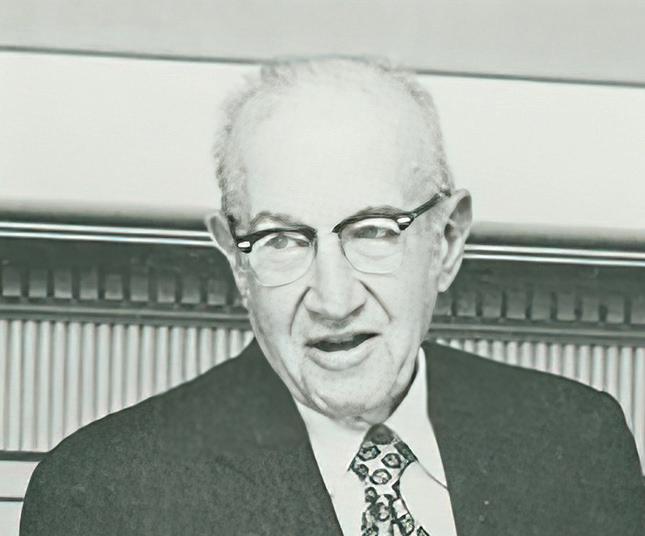

eir big house was o en aglow with activity. During World War II, the Cones sometimes entertained troops who were stationed at Greensboro’s Overseas Replacement Depot. ere were frequent parties for business and community leaders, political gures, and neighbors.
According to a story by News & Record writer Meredith Barkley, Benjamin Cone Jr. remembers as many as seven servants “keeping the house going.”
English actor Sir Michael Redgrave visited the Cones many times. Redgrave met the couple during the war years in Virginia Beach, when Redgrave’s ship was being retro tted at the Norfolk Naval Shipyard.
Tyrone Power, the star of swash-buckling lms such as " e Mark of Zorro" and " e Black Swan," was a World War II U.S. Marine Corps pilot and a frequent guest of the Cones.
When the Cones decided to sell the house in 1977, the buyer was Richard Love, one of Spencer’s sons and a successful builder in the region for nearly 50 years. “He added brick walks in front and put up a brick wall along Country Club Drive, giving the home a more formal look,” Barkley reported.

For his improvements, Love went back to the company his father had originally used — Old Virginia Brick Co. of Salem, Virginia. He ordered twice as many bricks as he thought he would need, culling out those he didn’t feel matched precisely, which were repurposed in other building projects.


In 1983 Love sold the property to John Russell “Rusty” Taylor Jr., who was president of the rst senior class to graduate from Walter Hines Page High School in 1961. He later attended Harvard University and received his law degree at UNC Chapel Hill. He trained as a U.S. Marine Corps pilot during the Vietnam War and later joined his father’s real estate rm in Greensboro.
Taylor concentrated on updating the house’s electrical and mechanical systems, modernizing the telephone and security
64 BUSINESS NORTH CAROLINA
Left to right, J. Spencer Love, Benjamin Cone and Bonnie McElveen-Hunter
systems, repairing the leaky roof, and adding a workout facility and sauna in the basement. He died in 1995.
e current owner, Bonnie McElveen-Hunter and her husband, the late Bynum Merritt Hunter, moved into the Love house in 1997. Bynum Hunter grew up in Greensboro and became a senior partner at the Smith Moore Smith Schell & Hunter law rm. He served as attorney for the Atlantic Coast Conference for more than 25 years.
Bonnie McElveen-Hunter was married to Hunter for 38 years. A native of Columbia, South Carolina, she was a military kid who lived in six states and Germany. A er graduation from Stephens College in Missouri, she moved to Charlotte to work for Bank of America and later as an advertising executive for Charlotte Magazine.
In 1972 McElveen-Hunter moved to Greensboro to work for Congressman Walter E. Johnston III. She then started Pace Magazine, the in ight publication of Piedmont Airlines. Adding magazines for United Airlines, Delta Air Lines, U.S. Airways, Southwestern Airlines and others, CEO McElveen-Hunter built her company into Pace Communications. Once focused on in ight magazines, it is now a multifaceted digital marketing company. In 2001, George W. Bush appointed McElveen-Hunter as ambassador to Finland. She later became the rst female chair of the American Red Cross.
THERMAL ENERGY
Extensive renovations of the home occurred a er her purchase. Upstairs walls were moved for comfortable new bedrooms, walk-in closets, dressing areas and elegantly appointed his-and-her bathrooms.


Downstairs, the kitchen was completely gutted and a replace, wet bar, handcra ed library shelves and custom cabinets, and hand-milled crown molding were installed in the Cone room. at carpentry work was done by Ren Putnam, a master woodworker and furniture maker in Reidsville.



“What people don’t realize is that the Love house was built to industrial standards,” Putnam says, noting the use of masonry and
THE LOVE MANSION
10,834 square feet
4 levels, including basement
17 rooms

6 bedrooms
7 full bathrooms
3 half bathrooms
List price: $5.95 million (July 15)
Assessed value: $4.28 million
Annual property tax bill: $58,366
Previous sale: $2.94 million (Feb. 1, 1997)
Source: Tyler, Redhead & McAlister Real Estate
concrete throughout. “I think Spencer Love wanted to build a place that was nearly reproof.”

Later, in 2008, McElveen-Hunter decided to install a geothermal heating and cooling system at the Love house. She asked Putnam to supervise the project, which was quite a challenge in an old house built like a fortress.
“ e men dug 16 dry wells 400 feet deep,” he says. Geothermal tubing was installed in the dry wells and ran to the carriage house, pool house, cottage and main house.
“ en Bonnie decided she wanted a well for irrigation,” Putnam says. “So we asked this country boy to come in with his divining rods.” In a short while, the man marked a place toward the back of the property and told them to drill. “Sure enough, we hit water at about 300 feet.”
e geothermal project took months to complete. “I don’t know of anything like it around here,” Putnam adds.
And that’s the point of it.
Greensboro has never seen anything quite like the Love house, where owners have lavished additions and updates that boggle the mind.
Now that the home is for sale again, its future is uncertain. Originally listed for $7.5 million in 2021, the asking price was $5.95 million in early July. Could this magni cent historical home one day be torn down?
“Sadly,” says Briggs, “we’ve seen such things happen.”
I reached out to McElveen-Hunter and asked her why anyone would want to buy the house now?
“ is place is more than a home,” she responds in a call from her home in Palm Beach, Florida. “It’s relationships. Experiences. Memories. It belongs to the community.”
“I’ll never leave this house,” McElveen-Hunter concludes. “I’m just passing it on. I hope someone else will love it just as much as I do.”
Greensboro’s unique Love’s labor. May it never be lost.
Ross Howell Jr. is a Greensboro writer. is story originally appeared in O. Henry, a sister publication.
Chatham County has been preparing for this dramatic moment. Several years ago, resolute community leaders took steps to ensure the viability of the county for years to come. They asked residents to believe that two megasites would bring jobs and opportunity. More importantly, they asked residents to be patient while they readied the sites and recruited companies. That faith and patience has paid off! Chatham County now calls itself home to two of North Carolina’s largest economic development projects ever announced. And we’re still just getting started.
In March of 2022, Vietnamese vehicle manufacturer VinFast announced that they would purchase 2,000 acres at the Triangle Innovation Point (TIP) Site in Moncure for its first American electric vehicle production facility. The project will generate $4 billion in investment and 7,500 jobs. In September of that same year, Durham-based semiconductor manufacturer Wolfspeed announced that it would build a new facility on 450 acres in Siler City, at the Chatham-Siler City Advanced Manufacturing (CAM) Site, investing $5 billion and creating 1,800 jobs. This meant that in 2022 alone, Chatham County saw over $9 billion in investment and 9,000 jobs planned. Currently, both projects are moving forward and ramping up their presence around the county.




This is all just the beginning. As we continue working with VinFast and Wolfspeed on their facilities, we are launching a new business retention and expansion program and putting together information on our remaining industrial land. With Wolfspeed’s site plan, the remaining 1,400 rail-served acres of the CAM Site is ready for a user, primed for advanced manufacturing. Additional land is available adjacent to VinFast’s site, at TIP West, and the Midstate Development Center has 300 acres beside the CAM site. Altogether, Chatham County has over 2,000 acres available for additional new businesses.
We certainly have a lot to do, but we won’t be setting out alone. We are fortunate to have partners inside and outside of the county as well as our investors in




the Accelerate 2026 campaign who are willing to collaborate with us to achieve our vision, and a greater future for all. Our education partners at Central Carolina Community College and Chatham County Schools are several of our biggest assets. Our regional utilities partners in Lee County and Randolph County are essential to what we do. Chatham Park is the gem we show off to all prospective companies, covering 8,000 acres. County leadership has backed us the entire way. Collaboration is the way we do things in Chatham. We invite you to visit and see why our success continues to grow.

Sincerely,
C. Michael Smith President Chatham Economic Development Corporation 964 East Street Pittsboro, NC 27312

SPONSORED SECTION COMMUNITY CLOSE-UP CHATHAM COUNTY 66 BUSINESS NORTH CAROLINA
Global electric automobile manufacturer VinFast has selected Chatham County for the site of its multi-billion dollar electric vehicle plant.
COLLABORATION ACROSS COUNTY LINES
Asign stating “Trespassers Welcome” brings a smile as visitors reach The Plant, Chatham County’s 17-acre eclectic gathering spot for business, nature and the arts. Chatham County Economic Development Corporation President Michael Smith says the sentiment defines the county. Chatham regularly collaborates and partners with businesses, academic institutions, government officials, farmers, entrepreneurs and residents within and across its borders.
Many of the county’s recent business and manufacturing acquisitions, residential-mixed use projects and educational partnerships spill into neighboring counties. For example, Smith


was recently at The Plant for a meeting organized in part by UNC Chapel Hill, in neighboring Orange County and Karen Howard, chair of the Chatham County Board of Commissioners. Chatham and the university team up often.
“I recently collaborated with UNC Kenan-Flagler Business School to launch Chatham Leads, which seeks to bring together leaders from business, academia and government to propel innovation and opportunity in Chatham County and the region,” Howard says. “It was an exciting opportunity to bring together old, new and future businesses, non-profits, our schools and community college, UNC faculty and staff and local government staff and partners to talk about what
Chatham’s future can look like, and The Plant was the perfect venue.”
“For a variety of reasons,” Smith says of overlapping county lines, “Chatham has cultivated really strong relationships with neighboring counties. We have collaboration. We have this advantage that we’re in the RTP regional partnership and part of the Carolina Core, and we’re so grateful to have regional marketing groups helping us with our story.”
Chatham is certainly well situated geographically, surrounded with business and educational connections in Wake County to the east, Guilford County to the west and Alamance, Orange and Durham counties to the north.

67 AUGUST 2023
Chatham County’s business, education and lifestyle spill beyond its borders.
people at....
PHOTO
CREDIT: ADRIAN MORENO
“With the coming of Interstate 685 [from Dunn to Greensboro] that side [of the county] is only a half hour from Greensboro, and that side of Greensboro continues to grow. So, one part of us is near the Triangle and one part is near the Triad,” Smith says.
“Chatham really is well placed for growth and opportunity,” Howard echoes. “As a large, still fairly rural county, we are close to airports, rail, major highways and byways but are working diligently to retain much of our rural character and precious greenways while allowing for access to job centers, arts and recreation and housing.”
BLURRED LINES
“A win for one is a win for all,” Smith says. “Technically, our largest town is Cary. And Cary is more in Wake County, but 10,000 people are in Chatham. And The Governor’s Club [residential community and country club] has a Chapel Hill address, but residents pay Chatham County taxes.”
Chatham has a claim to some of the state’s most recent economic development home runs.
In March, electrical vehicle company VinFast announced its $4 billion investment in an EV and battery facility at Triangle Innovation Point in Moncure, in southern Chatham. It’s expected to create 7,500 jobs. The facility’s water and sewer utilities, however, are across the line in Sanford, in Lee County.
Last September, Wolfspeed, a silicon carbide manufacturing company, announced it is building a $5 billion chip production plant on 445 acres at the Chatham-Siler City Advanced Manufacturing megasite. Its water lines are in Randolph County.
In April, Duke Energy paid $3 million for 68 acres near the Chatham-Randolph line to increase service in the area.
As more employees and businesses come to the area, rooftops are going up to meet the demand for housing.
Chatham Park is a new 7,000-acre mixed-use development on the county’s east side about 15 minutes from Wake
County and Chapel Hill.
“It’s 20 minutes from VinFast, 25 minutes from Wolfspeed and every client we have, we’re going to talk about Chatham Park,” Smith says. The masterplanned community with onsite healthcare, shopping, recreation and a K-12 private school, will have several neighborhoods including townhomes, apartments and a 55-plus adult community with pool, tennis, pickleball and a putting green.
“There will be 20,000 residential units in there,” Smith says. “Every image we show of Chatham County, we show Chatham Park.”
Howard chairs the Durham-Chapel Hill-Carrboro Metropolitan Planning Organization.
“While most of Chatham is in a rural planning organization for transportation planning [the Triangle Area Rural Planning Organization TARPO], a small portion of northeastern Chatham is in the Durham-Chapel Hill-Carrboro Metropolitan Planning Organization [DCHC-MPO],” she says. A portion
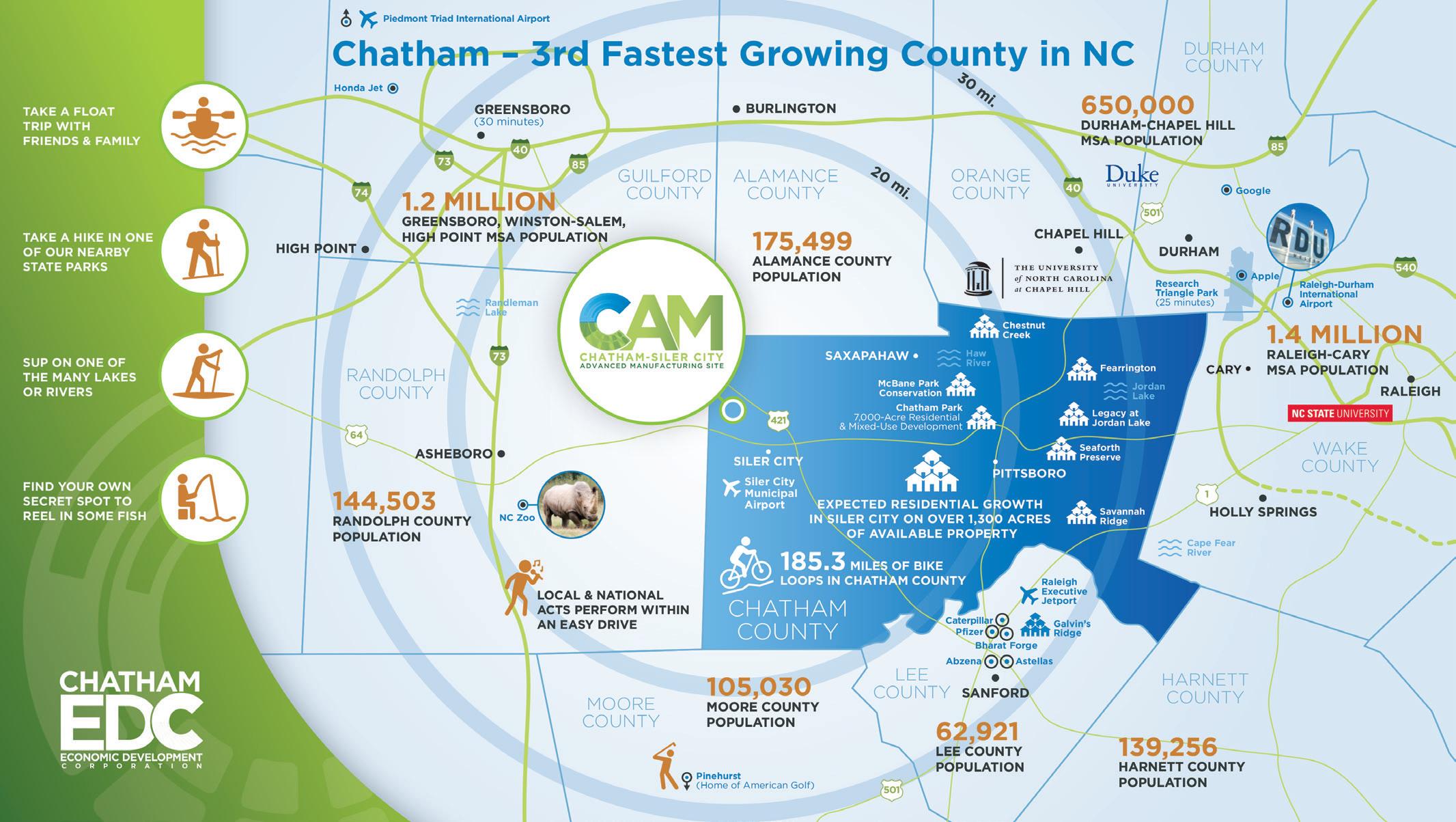
SPONSORED SECTION COMMUNITY CLOSE-UP CHATHAM COUNTY 68 BUSINESS NORTH CAROLINA
GRAPHIC CREDIT: MICHAEL SMITH, PRESIDENT OF CHATHAM COUNTY ECONOMIC DEVELOPMENT CORPORATION

of Chatham may also soon fall within the Capital Area Metropolitan Planning Organization [CAMPO].
“All three planning organizations are responsible for regional transportation planning, but the methodologies and needs make for very different conversations in order to ensure that the right options for our community are on the table,” Howard adds. “Things like Bus Rapid Transit (BRT), light rail and commuter rail should be in our sights, but we are also committed to ensuring that bike lanes and sidewalks are part of what we negotiate for Chatham so that we can create communities that are walkable and where bike and pedestrian safety is foremost.”
STRONG EDUCATIONAL INFRASTRUCTURE

The relationships between Chatham’s high schools, Central Carolina Community College and neighboring universities are vital to educating a workforce, Howard says.

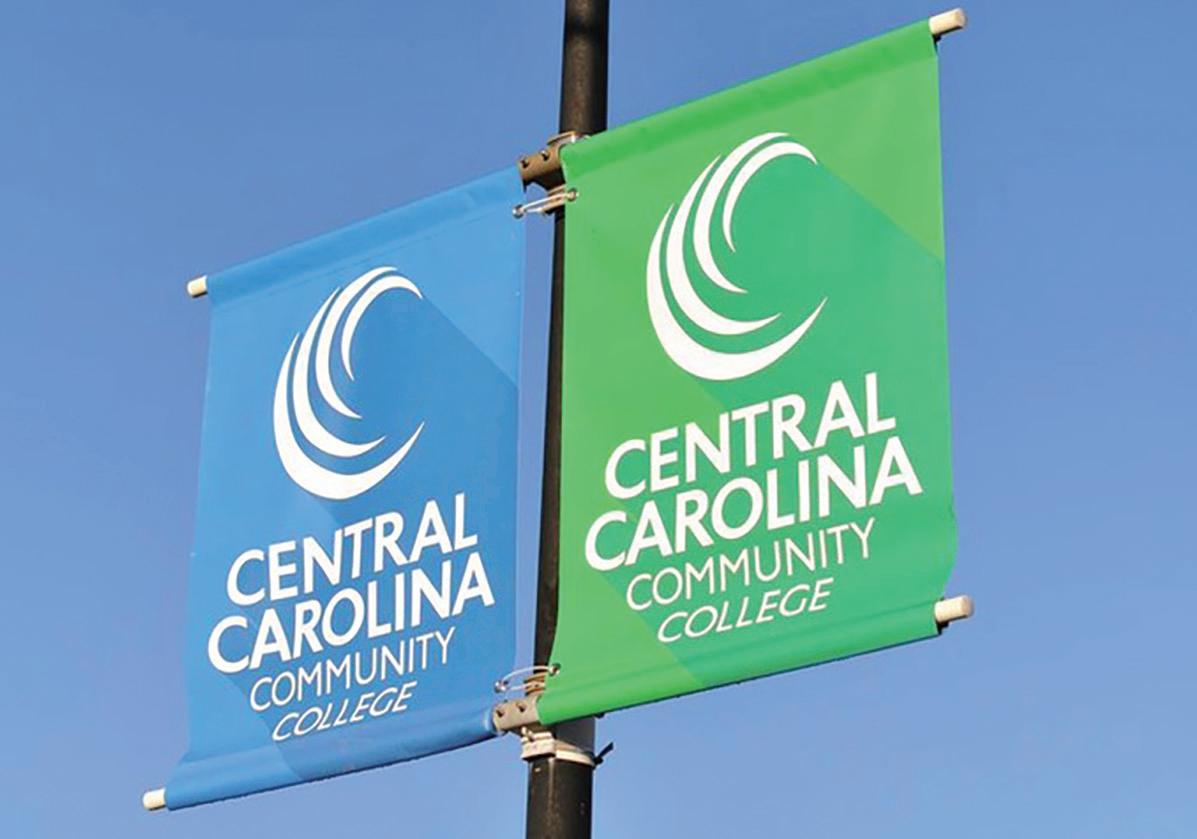
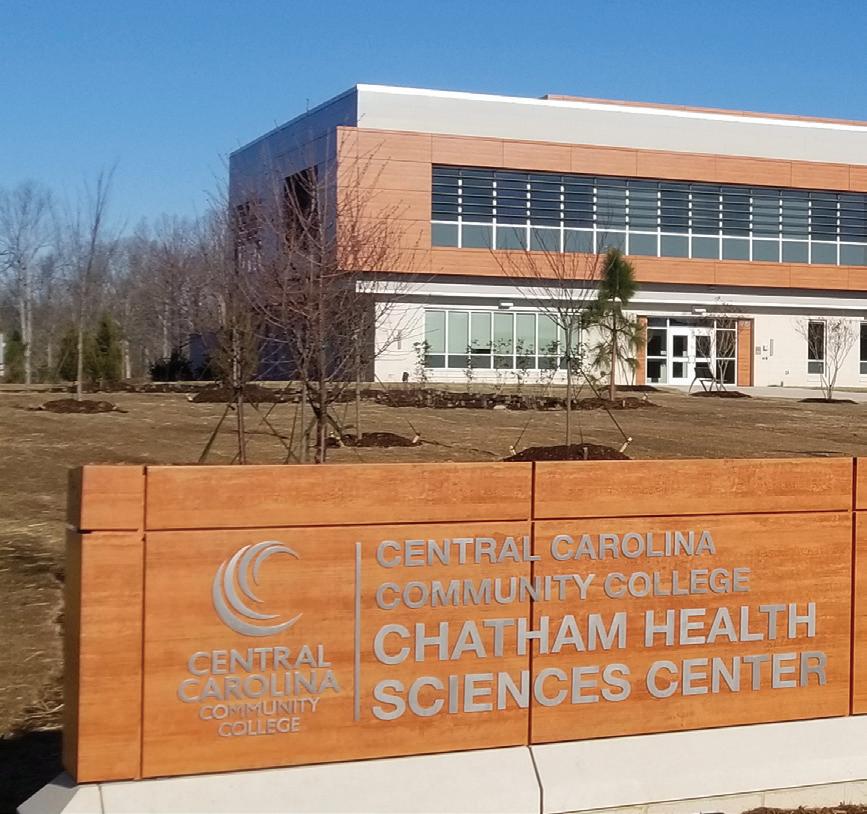
She has many ties to education in the area and across the state including chairing the county Board of Education in 2013-14 and serving on the school system’s AIG Advisory Committee, the admissions committee for KenanFlagler’s MBA at UNC program, the Legislative Committee of the North Carolina Schools Boards Association and the Parent Advisory Council of the North Carolina School of Science and
Mathematics and currently as co-chair of the task force of Presidential Initiative, Pathways for Disconnected Youth.
“Chatham County Schools, Central Carolina Community College, our EDC and other partners are trying to address the need to build a pipeline to meet the needs of the workforce, and it seems the landing of such companies as VinFast and Wolfspeed in our community have super-charged the conversation,” she says. “The launching of programs at the Moore Center in Lee County, which is proximate to VinFast, and creation of programs to support the employee needs of both companies has spurred program development at campuses in Chatham as a natural progression of that relationship.”
SPONSORED SECTION COMMUNITY CLOSE-UP CHATHAM COUNTY 70 BUSINESS NORTH CAROLINA
PHOTO COURTESY OF CENTRAL CAROLINA
COLLEGE
Central Carolina Community College’s Promise Program offers free in-state tuition to accepted students who graduate from schools in Chatham, Harnett and Lee counties.
COMMUNITY

Central Carolina Community College’s Promise Program offers free in-state tuition for two years for accepted students.
“This program is eligible for all our Chatham, Harnett and Lee County residents who graduate from a public high school, private school, charter school or homeschool,” says Felicia Gilmore, Central Carolina Community College’s Career Center coordinator. “We also offer several other programs like TRIO [Upward Bound, Talent Search and Student Support Service], YouthBuild and other great programs throughout the college to help high school students have a smooth transition to college.”
Howard is the current liaison with the Board of Education. The school system recently initiated One Chatham, a push to unite students, faculty, staff, facilities, infrastructure, curriculum and communications.
“This really touches on the intersection of many years of focused work we have been doing in the county to ensure that local students have access to well-paying, meaningful employment that will offer them the opportunity to stay close to home and be involved in the community that has invested in them,” Howard says.
“In our high schools, we have also built supports that help guide our students to the careers of the future both in programming and in access to Central
Carolina Community College through dual enrollment, our Early College and the Chatham Promise. We are seeing that change in real time as businesses and industry, as well as community expectations, have emerged to create 21st-century opportunities in clean manufacturing and forward-looking industrial applications of science and technology.”

In 2020, she co-chaired the N.C. Association of County Commissioners Presidential Initiative on Disconnected Youth that focused on people ages 16 to 24 who were neither in school nor employed. “Since then,” she says, “we have a new partner in this work in MyFutureNC, which seeks to get 2 million North Carolinians to a degree or certification by 2030, and a percentage of that number resides in Chatham.”
CONNECTING EMPLOYERS AND STUDENTS
“Everything is shared,” Smith says. For example, the past two years he has participated in the N.C. Certified Economic Developer Program with N.C. State, which was held at Central Carolina Community College’s Sanford campus.
“They talk about attraction and getting new companies to come to your community,” he says. “I was fortunate to be part of what happened in Lee
[County] because it reemphasized all the shared assets we have in the counties. A few weeks ago, we met a client at the Raleigh Executive Jetport, and we drive seven minutes to the VinFast site.”
Central Carolina Community College partners in work-based learning with Bharat Forge, Wolfspeed, Accauro Gene Therapies, Toyota, Astellas and VinFast. The college’s job board, College Central Network, “assists our local employers, employers from other states, and national employers in posting jobs for our students, alumni, and community residents to search for careers,” Gilmore says. “Students have the opportunity to apply instruction in an actual workplace setting by working for an employer that is directly related to the program of study.” Workers needing more job-specific training utilize the college’s Department of Workforce Development.
“Different departments assist with aiding in teaching new skill sets, new techniques, and even basic skill sets to help employees become more successful in the area of expertise that is needed by the employer,” Gilmore says. “The Career Center hosts career fairs [at campuses in Chatham, Harnett and Lee] and expos that bring in a variety of different employers in the spring, fall and summer semesters.”
Gilmore created a summer semester program called Work-it Wednesdays to bring students and employers with open positions together. “Employers have the opportunity to pick the location that best suits their needs from a pool of candidates that they can pull from to hire for their open positions,” she says. “Work-It Wednesdays will be held on Chatham, Lee, and Harnett’s main campuses. Some of the employers that have participated in the series of hiring events are Lee County Government, Belflex Staffing Network, Residential Services Inc. and GKN Automotive.”
She says the fields most in-demand are manufacturing, healthcare, personal care and services, logistics and food services.
SPONSORED SECTION COMMUNITY CLOSE-UP CHATHAM COUNTY 72 BUSINESS NORTH CAROLINA PHOTO COURTESY OF CHATHAM COUNT Y COMMUNITY COLLEGE
Students learn welding skills at Central Carolina Community College.
Chatham

Assistant County Manager Bryan Thompson, County

Attorney Bob Hagemann, Michael Smith, president of Chatham Economic Development, Board of Commission


Chair Karen Howard, House Minority Leader Robert Reives and County Manager Dan LaMontagne pose for a photograph while wearing “$9B/9K/22” pins, which represent a remarkable year with $9 billion in investments and 9,000 jobs in 2022.
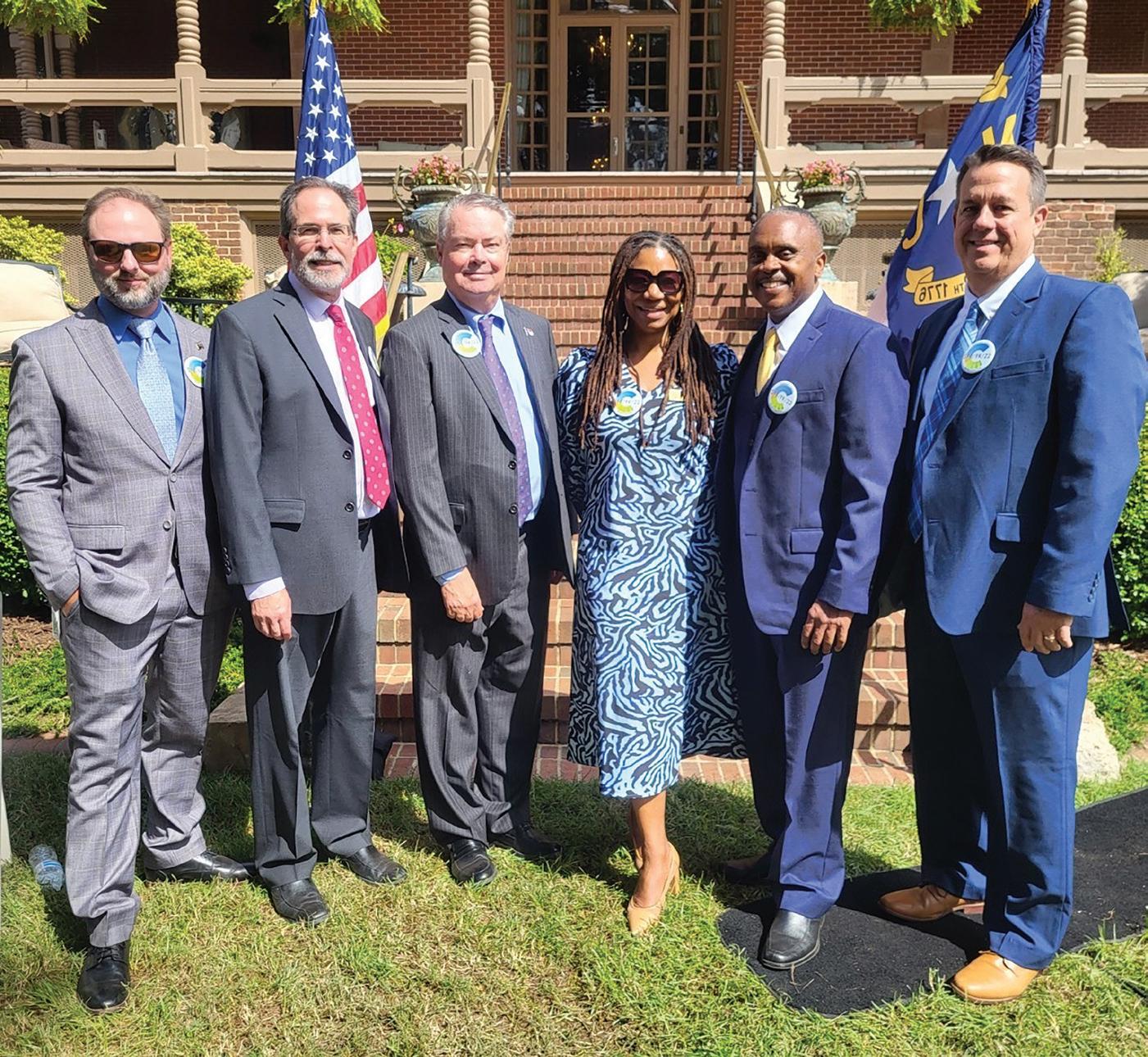
73 AUGUST 2023
NATURAL CHARM
“There are so many quirky things. We had the largest job announcement with VinFast, the largest investment with Wolfspeed, and I was at that meeting a few weeks ago and The Plant was packed because there was a jazz band playing outside,” Smith says.
And that’s a prime example of industry and quality of life coming together. Education and workforce are key to attracting business, of course, as well as location, transportation, investment incentives, and many other components. But Chatham County’s distinct quality of life is an important draw, too. The mostly rural county has proximity to the urban downtowns of Raleigh and Greensboro, and offers its own small town charm, as well.
The Plant is a gathering place for families, artists, performers, wedding goers and business folks wanting a cool place to meet and work. It houses restaurants, breweries, coffee companies, shops, an art gallery, and a farm-to-fork food truck along with a native plant nursery and nature walk. Visitors can throw an ax, write in a journal under a tree or rent bikes.
Lyle Estill, his wife Tami Schwerin and Lyle’s brother Mark Estill bought the former metal alloy plant in 2004 after it sat vacant behind barbed wire for a decade. Before it was a manufacturing facility, the property was one of the biggest flower farms in the country. It provided the chrysanthemums for John F. Kennedy’s inauguration in 1961.
Now, Lyle and Tami operate The Plant as a place to grow food, host events and “promote local resilience.” The relaxing encampment offers everything from caviar to scented candles to birdwatching. Its calendar is full of live music, ice cream socials, yoga, dance performances and more.
Smith also points to Bynum Front Porch, another gathering place that is a former general store in an 1872 cotton mill village on the Haw River that’s become a non-profit with family-friendly events and Friday night live-music series.

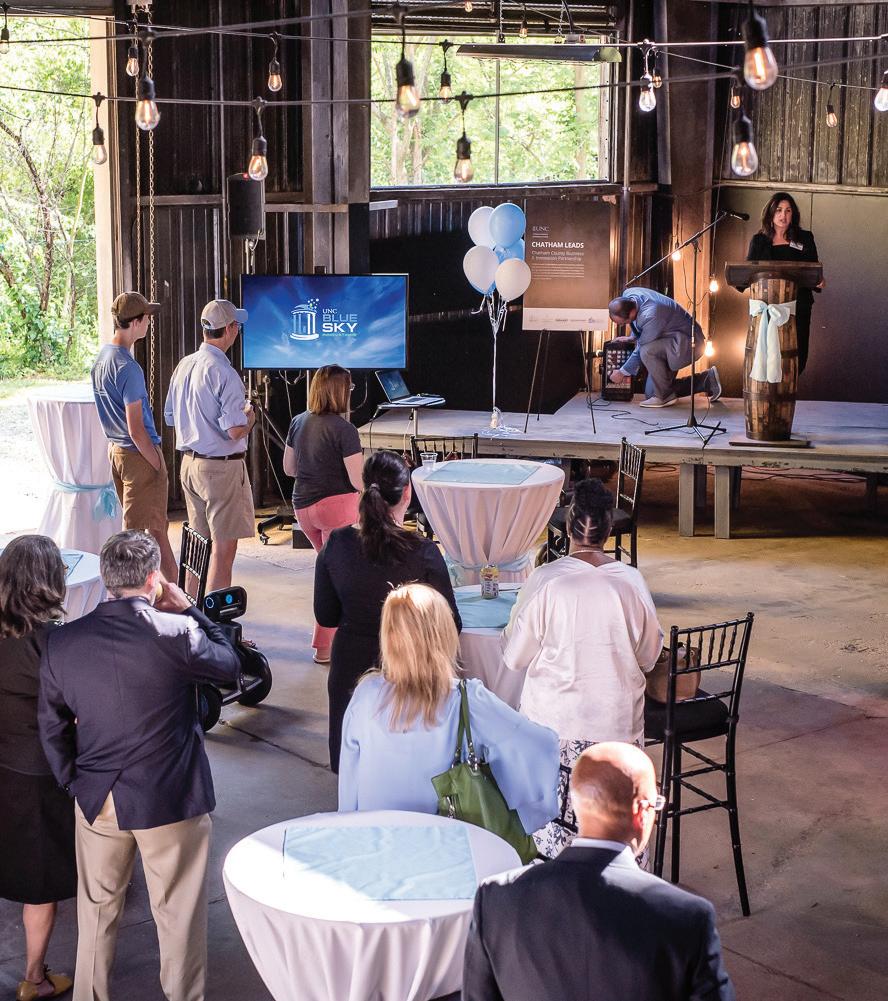
Jordan Lake State Recreation Area in Chatham, 30 miles from Raleigh, has boating, swimming, more than 1,000 campsites for tents, trailers or RVs, hiking trails and fishing areas.
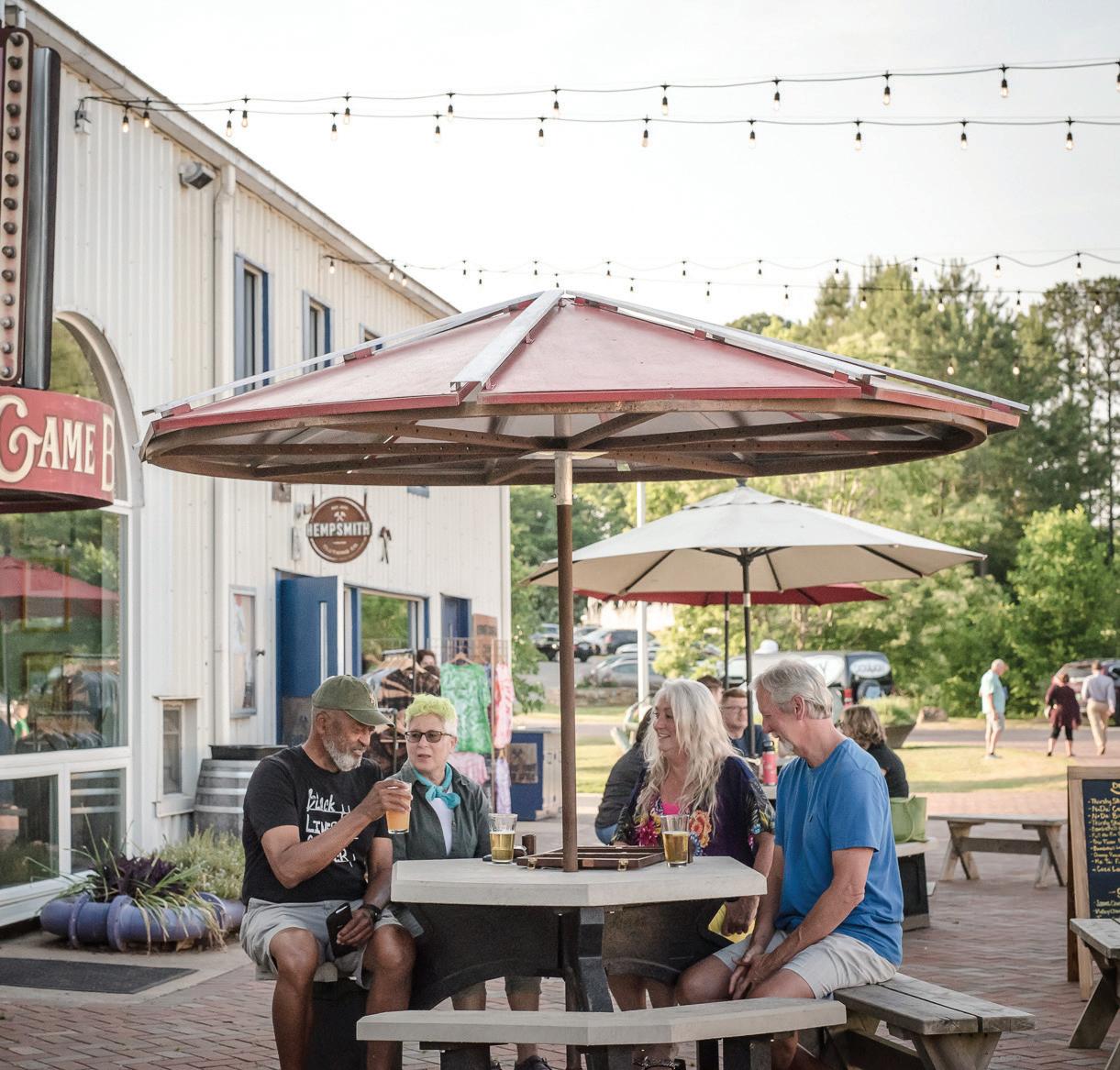
SPONSORED SECTION COMMUNITY CLOSE-UP CHATHAM COUNTY 74 BUSINESS NORTH CAROLINA
PHOTO CREDIT: ADRIAN MORENO
The Plant, a place for food, drink and music in Pittsboro, is owned by husband and wife, Tami Schwerin and Lyle Estill.
CLOSE-UP CHATHAM COUNTY

CHATHAM COUNTY



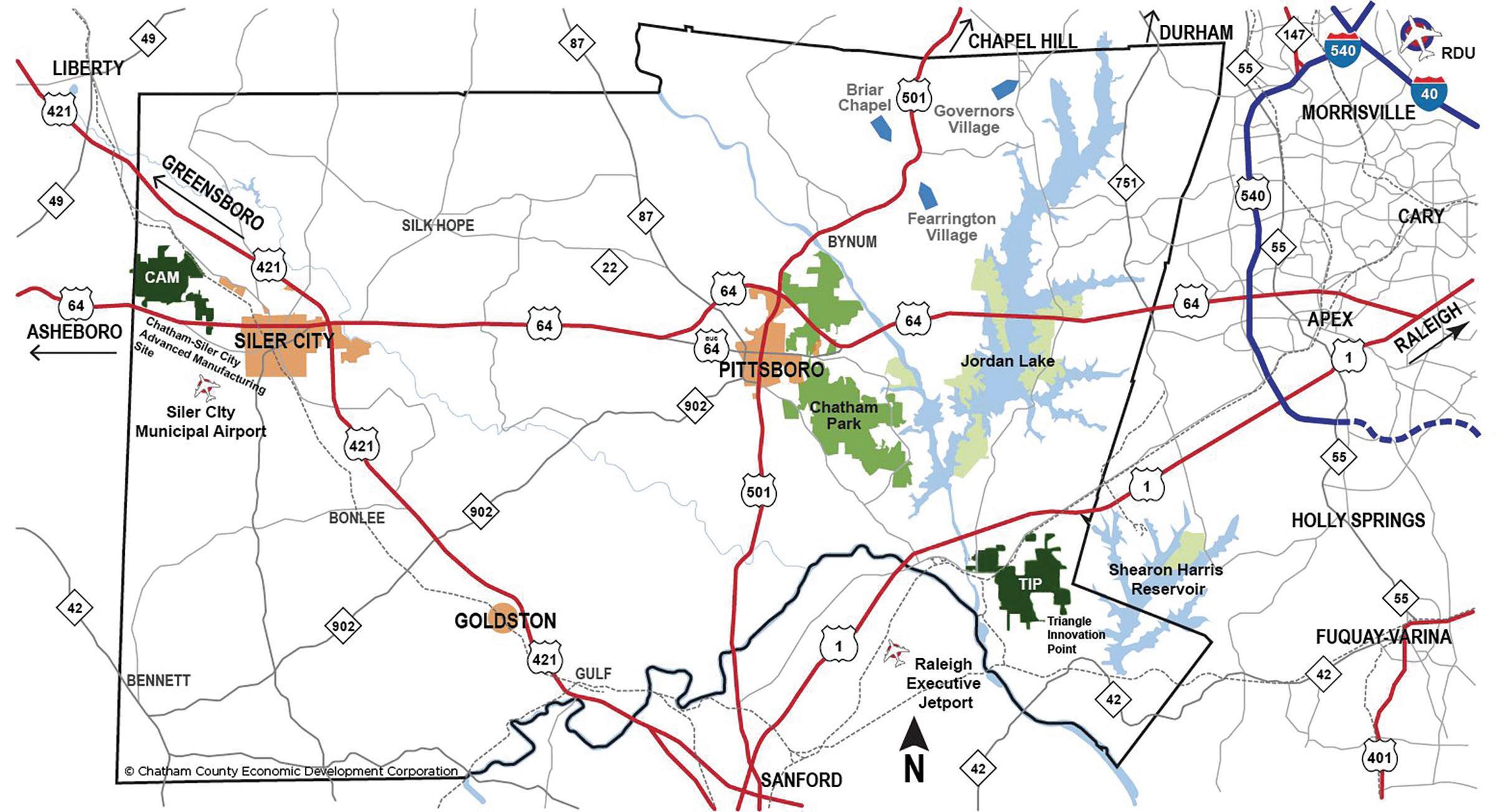
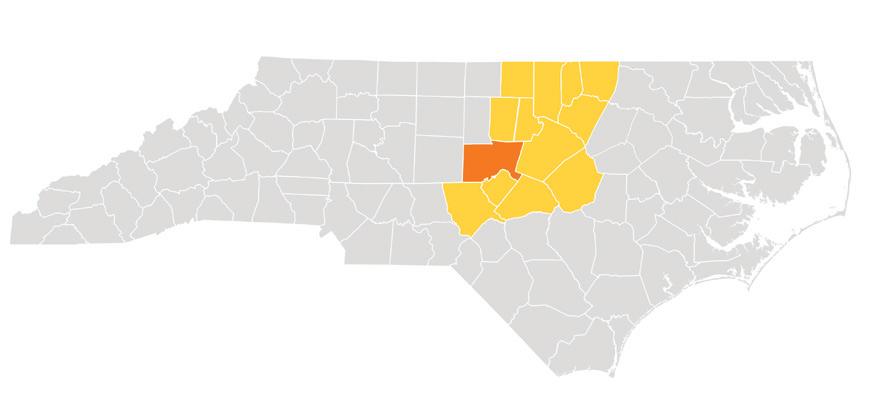
“A few weeks ago, someone put on my desk (information that stated) Jordan Lake is one of the most visited state parks in North Carolina, and that’s exciting, because it’s right here in our county,” Smith says. “You have this beautiful body of water with zero development on it.”
The park drew more than 2 million visitors in 2022, 27% more than 2021.

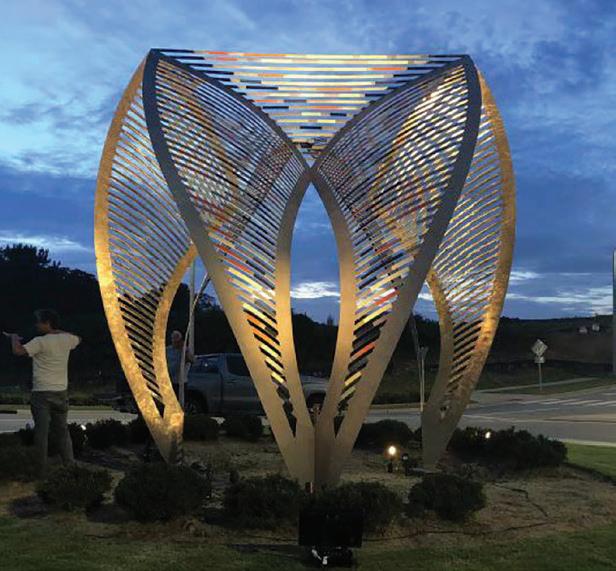
“Chatham is Jordan Lake and the thousands of acres of surrounding protected lands,” Howard says. “It is music and the arts. Great schools. Quaint towns. Rivers and trails. Like most places we are a complex network of newcomers and old-timers looking for ways to collaborate for a future Chatham that respects its past with integrity and looks toward its future with hope. We are racially and ethnically diverse, and we don’t always agree but Chatham continues moving toward that better future for all.” ■
— Kathy Blake is a writer from eastern North Carolina.

SPONSORED SECTION COMMUNITY CLOSE-UP CHATHAM COUNTY 76 BUSINESS NORTH CAROLINA
PHOTO
&
GRAPHIC CREDIT: MICHAEL SMITH, PRESIDENT OF CHATHAM COUNTY ECONOMIC DEVELOPMENT CORPORATION
Triangle Innovation Point -TIP
Chatham Park
Unique architecture helps showcase Triangle Innovation Point while public art highlights the industrial Chatham Park site.
2011 2021* POPULATION (000S) 64.4 77.7 EMPLOYMENT (000S) 14.1 15.8 UNEMPLOYMENT RATE 8.0% 3.6% PER CAPITA INCOME (000S) $47.1 $66.8 EMPLOYMENT BY INDUSTRY Health care: 14.9% Retail: 10.7% LARGEST PRIVATE-SECTOR EMPLOYER Carolina Meadows LARGEST CITY/TOWN Siler City: population 7,699 COUNTY PROPERTY TAX 66.5 cents per $100 value HIGHER EDUCATION Central Carolina Community College
Chatham Park is a 7,100-acre planned mixed-use development.

CATTLE CALL
As N.C. farmland disappears at an alarming rate, three Charlotte developers keep a family heritage alive with Angus cattle.
BY KEVIN ELLIS
Three Charlotte real estate developers went down east to Lake Mattamuskeet hunting for ducks and returned with a plan to raise Angus cattle.
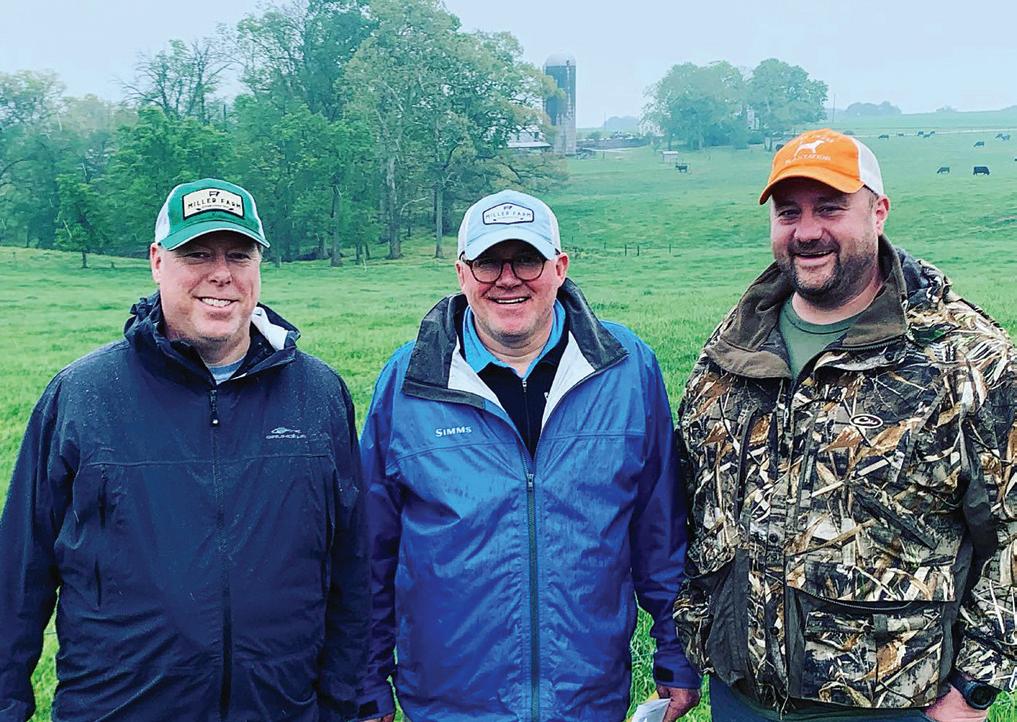
Grant Miller and Rob Speir, who work in Charlotte for Torontobased Colliers International, and Tim Robertson with Charlotte-based Beacon Partners, weren’t daydreaming on that January 2021 trip to the state’s largest natural lake. ey, along with Miller’s father, have put up about $85,000 and formed Harve Creek Cattle, named for the creek passing through the 120 acres of the Miller family farm in Stony Point, an unincorporated area of 1,500 residents that crosses over the Iredell and Alexander county line.
“We had to get the merchandise rst. Got some shirts and some hats. Had to design a logo,” says Miller. By April 2021, the company had bought seven heifers and began looking for a bull.
“ at’s always been my kind of outlet to go out there and get on the tractor and unplug,” says Miller, who has a farming background, unlike Robertson and Speir.
“We want to be a 50-cow operation, selling registered Angus to other commercial producers,” he says. “Slow and steady growth. We want it to be a product we can stand behind. Now, will it make us any money? I haven’t a clue.”

e industrial real estate developers’ venture into cattle comes at a critical time for agriculture in North Carolina. While the industry’s annual economic impact topped $100 billion for the rst

time, hitting $103.2 billion, state Agriculture Commissioner Steve Troxler repeatedly warns that the state is losing too much farmland to development. Operations like Harve Creek and many others need to thrive for the state to retain a leading ag economy, he says.
North Carolina ranks second in the nation in potential farmland loss, behind Texas, according to a report last year by American Farmland Trust. e report projects 1.1 million acres of farmland will be paved over based on current development numbers by 2040, but




78 BUSINESS NORTH CAROLINA GREEN SHOOTS Revitalizing rural N.C.
PHOTOS
OF
COURTESY
GRANT MILLER
Rob Speir, Grant Miller and Tim Robertson
could increase to 1.6 million acres if growth accelerates. e hardest hit counties would be Johnston and Wake in the Triangle and Union in the Charlotte area.
North Carolina had 8.3 million acres of farmland and 45,100 farms in 2021, based on a survey by the U.S. Department of Agriculture. at compares with 10.8 million acres in 2001, according to the Farmland Information Center..

Miller’s maternal grandfather, Glen Martin, started the family farm in the 1950s, at one time raising chicken and dairy cows along with tobacco, while operating a country store. Miller’s tobacco-farmer father, Terry, and mother, Debra, still live there. ey are in their 70s.
“I was real close to my grandfather, and as I look back, this is what he really enjoyed doing,” Miller says. “It goes back to continuing to utilize the farm. You read and hear so much about farmland going away or no one staying on the farm.”
His 13-year-old son, West, works with him on Saturdays at the farm, although sometimes he prefers basketball or gol ng. Miller’s brother, Noah, helps manage day-to-day operations.
Growing up, Miller says his family would sell a few heads of cattle, with little more than an ear tag for identi cation. Farming now involves data, genetics, and AI, but not the AI sending the stock market soaring. His version is arti cial insemination.
“We’re like scientists, ne-tuning what we want to put on the ground,” says Miller.


“I want it to be something where people say, ‘Harve Creek puts a good product out on the ground.’ It’s like anything else in business,” he says.
He envisions rewarding the bulls who do a good job on his farm to
a place at a bigger farm, with his group pocketing the pro ts.
On the purebred side of the business, a top-notch Angus bull can sell for $2,500 to tens of thousands, he says. One headed to slaughter fetches about $1,000.


Miller looks for cows that can produce o spring in the 60- to 75-pound range with natural ease.

“ e last thing I want to be doing is chasing down a cow to help her deliver a calf,” he says.
“If the bulls are good bulls and meet criteria, those bulls are going to go to a commercial farmer who might have a big herd, but who just needs a good bull who can take care of everybody and a bull who can perform,” he says.
Bulls and cows that don’t work out become “banned,” aka steak. To stay o that list, the bulls and cows have to play nice.
“You’re looking for a calm demeanor and how they interact with others in the herd. A cow that does its work, doesn’t get in trouble. Doesn’t get out of the fence,” he says.
Either way, “there’s always going to be a demand for beef.” ■
79 AUGUST 2023
Grant Miller and his father, Terry, pose with a young Harve Creek cow at the Miller family farm which crosses Alexander and Iredell counties.


80 BUSINESS NORTH CAROLINA













































 BY EDWARD MARTIN
BY EDWARD MARTIN





 BY CHRIS ROUSH AND DAVID MILDENBERG
BY CHRIS ROUSH AND DAVID MILDENBERG



 BY CHRIS ROUSH
BY CHRIS ROUSH

 BY ROSS HOWELL JR.
BY ROSS HOWELL JR.

























 By Vanessa Infanzon
By Vanessa Infanzon























































































 By Warren Cole Smith
By Warren Cole Smith














































































































































































 Don Curtis
Don Curtis














































































